
Welcome to the Annunciation Greek Orthodox Church Online Church Tour, dedicated in honor of the event when the Virgin Mary was told by the Archangel Gabriel that she would “...conceive...and bring forth a Son, and...call His name Jesus,” as told in Luke 1
Annunciation Greek Orthodox Church of Winston Salem, NC: Greek Festival Church Tour Brochure - May 14]
|
|
|---|
Built using Pannellum
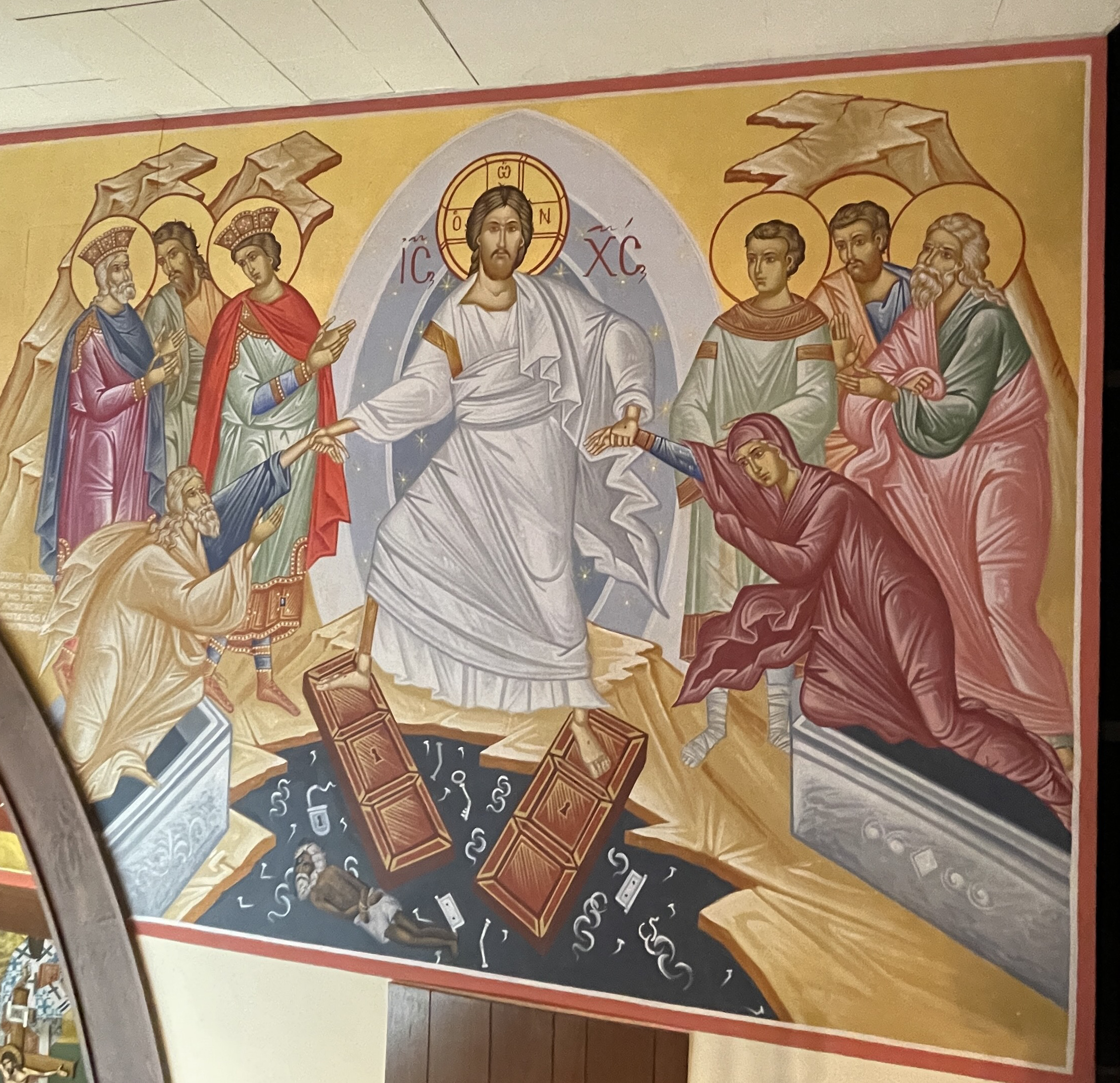
Mary Magdalene, and the other women who were present at the burial of our Saviour on Friday evening, returned from Golgotha to the city and prepared fragrant spices and myrrh, so that they might anoint the body of Jesus. On the morrow, because of the law which forbids work on the day of the Sabbath, they rested for the whole day. But at early dawn on the Sunday that followed, almost thirty-six hours since the death of the Life-giving Redeemer, they came to the sepulchre with the spices to anoint His body. While they were considering the difficulty of rolling away the stone from the door of the sepulchre, there was a fearful earthquake; and an Angel, whose countenance shone like lightning and whose garment was white as snow, rolled away the stone and sat upon it. The guards that were there became as dead from fear and took to flight. The women, however, went into the sepulchre, but did not find the Lord's body. Instead, they saw two other Angels in the form of youths clothed in white, who told them that the Saviour was risen, and they sent forth the women, who ran to proclaim to the disciples these gladsome tidings. Then Peter and John arrived, having learned from Mary Magdalene what had come to pass, and when they entered the tomb, they found only the winding sheets. Therefore, they returned again to the city with joy, as heralds now of the supernatural Resurrection of Christ, Who in truth was seen alive by the disciples on this day on five occasions. Learn More
[Greek Orthodox Archdiocese of America - June 22]
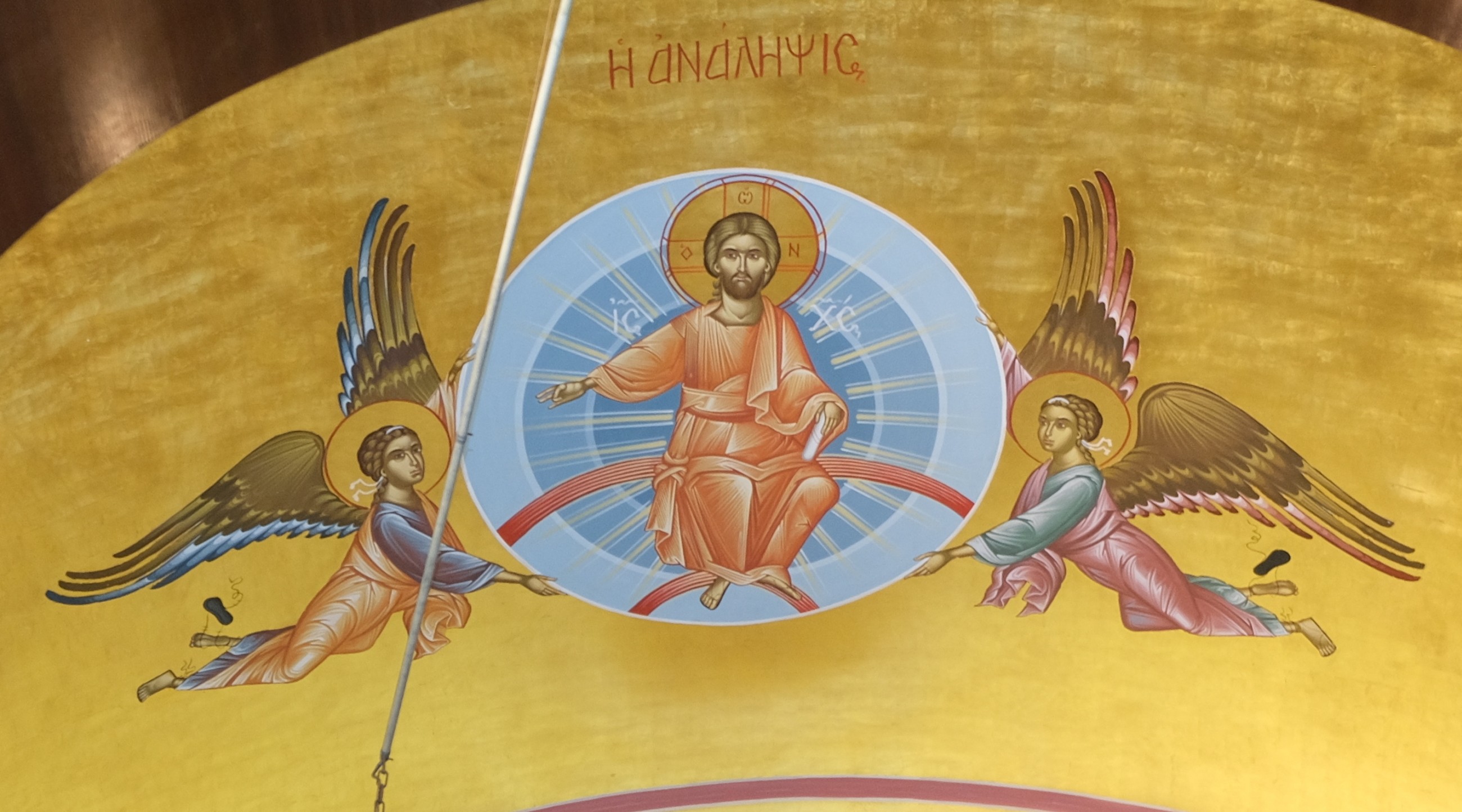
The Lord Jesus passed forty days on earth after His Resurrection from the dead, appearing continually in various places to His disciples, with whom He also spoke, ate, and drank, thereby further demonstrating His Resurrection. On this Thursday, the fortieth day after Pascha, He appeared again in Jerusalem. After He had first spoken to the disciples about many things, He gave them His last commandment, that is, that they go forth and proclaim His Name to all nations, beginning from Jerusalem. But He also commanded them that for the present, they were not to depart from Jerusalem, but to wait there together until they receive power from on high, when the Holy Spirit would come upon them. Learn More
[Greek Orthodox Archdiocese of America - June 22]
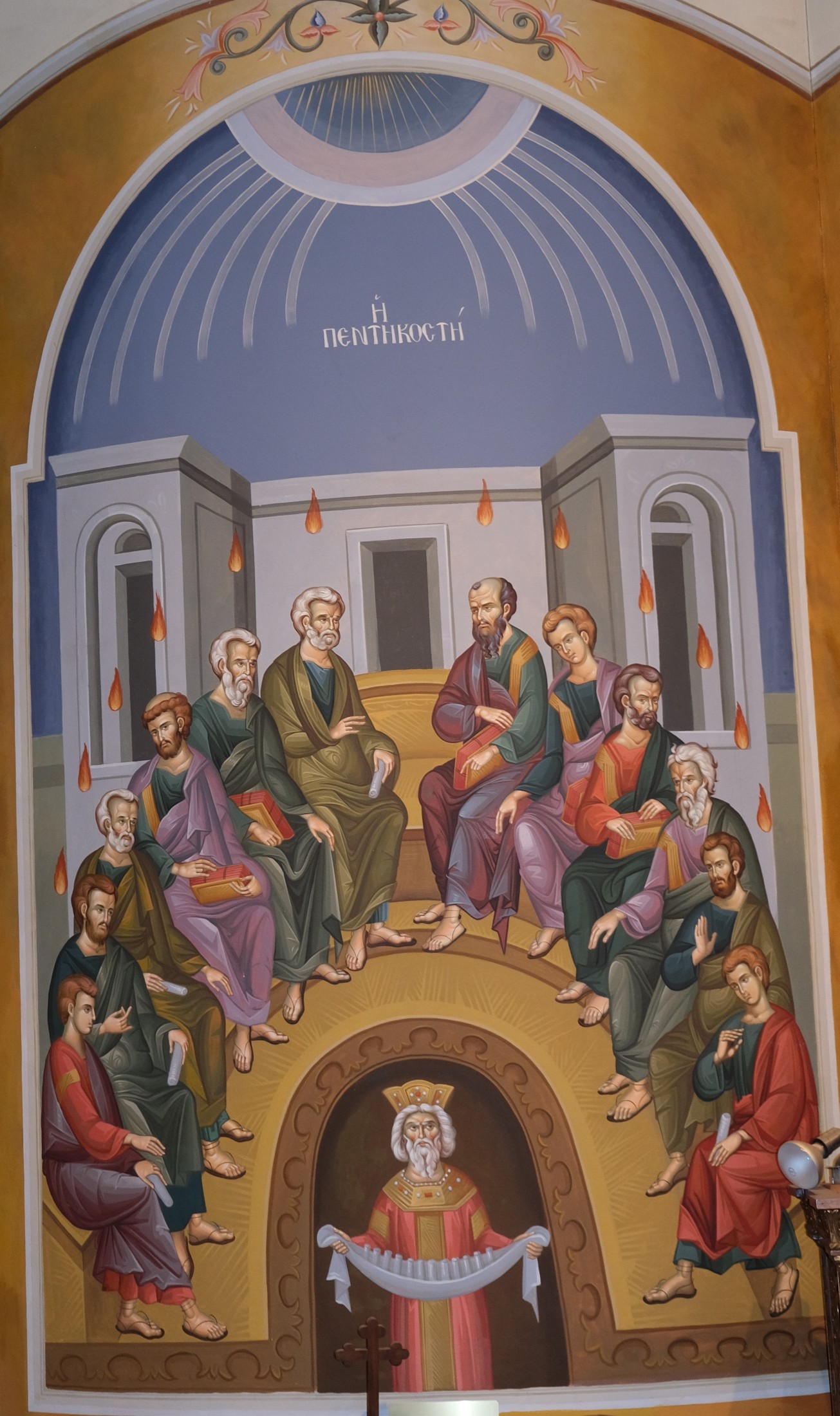
After the Saviour's Ascension into the Heavens, the eleven Apostles and the rest of His disciples, the God-loving women who followed after Him from the beginning, His Mother, the most holy Virgin Mary, and His brethren-all together about 120 souls returned from the Mount of Olives to Jerusalem. Entering into the house where they gathered, they went into the upper room, and there they persevered in prayer and supplication, awaiting the coming of the Holy Spirit, as their Divine Teacher had promised them. In the meanwhile, they chose Matthias, who was elected to take the place of Judas among the Apostles. Learn More
[Greek Orthodox Archdiocese of America - June 22]
August 6
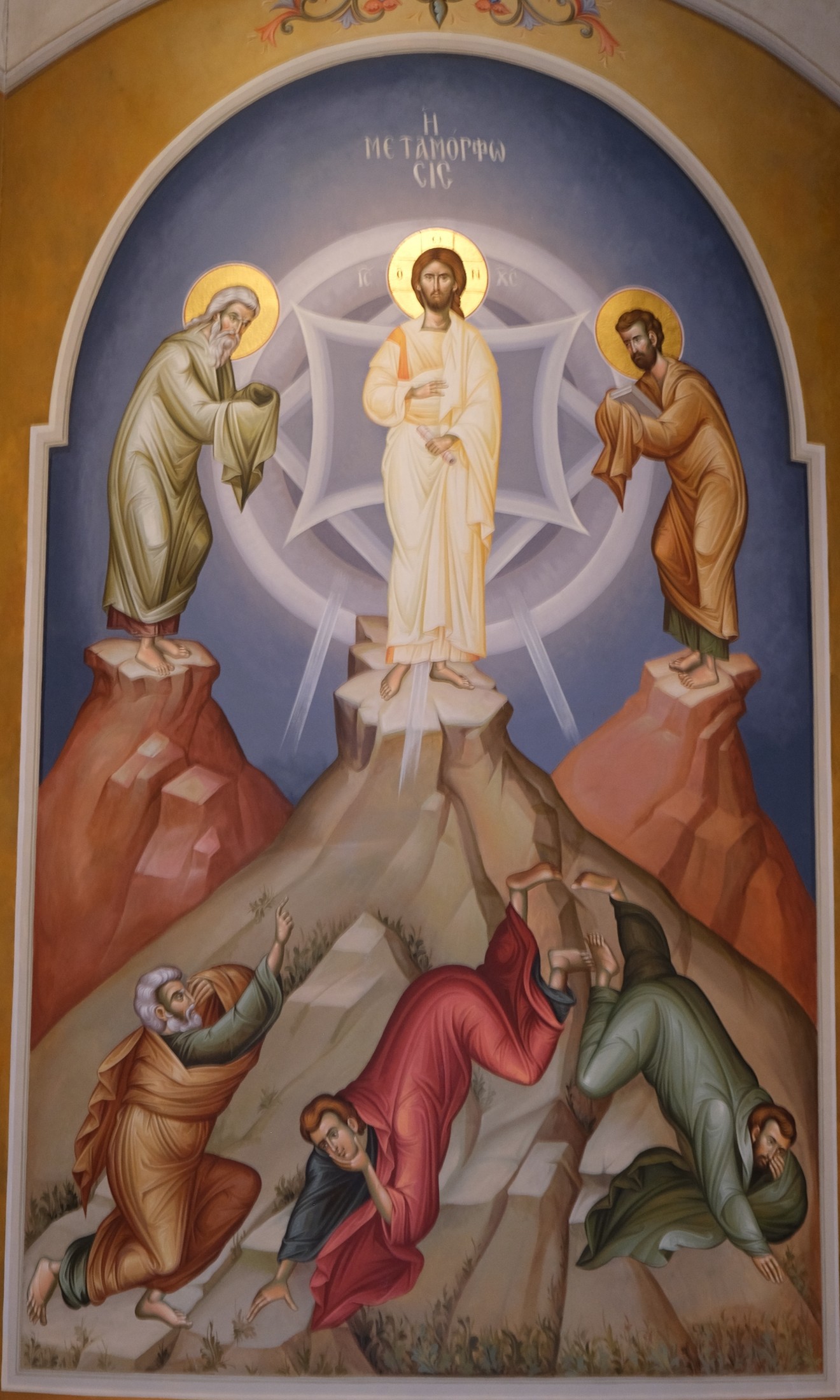
Our Lord had spoken to His disciples many times not only concerning His Passion, Cross, and Death, but also concerning the coming persecutions and afflictions that they themselves would endure. Since all these evils were near at hand, but the enjoyment of good things which they hoped to receive in their stead was yet to come, our Savior desired to give them full assurance, evidently and openly, concerning that glory which is prepared for those who endure to the end. Therefore, fulfilling that which He had promised shortly before, that "there be some standing here which shall not taste of death, till they see the Son of man coming in His Kingdom" (Matt. 16:28), He took His three foremost disciples and ascended Mount Tabor, where He was transfigured before them. His face shone like the sun, and His clothes became white as the light. Suddenly, together with this dread and marvelous effulgence of light, there appeared those pinnacles of the Prophets, Moses and Elias, who spoke with the Lord Jesus concerning His saving Passion which was about to take place. Standing before Him as reverent servants, they showed that He is the Lord of both the living and the dead, for Moses came forth from Hades, having died many centuries before, and Elias, as it were from heaven, whither he had been taken up while yet alive. After a little while a radiant cloud overshadowed them and out of the cloud they heard that same voice which had been heard at the Jordan at the Baptism of Christ, testifying to the Divinity of Jesus and saying: "This is My beloved Son, in Whom I am well-pleased; hear ye Him" (Matt. 17: 5). Learn More
[Greek Orthodox Archdiocese of America - June 22]
August 15
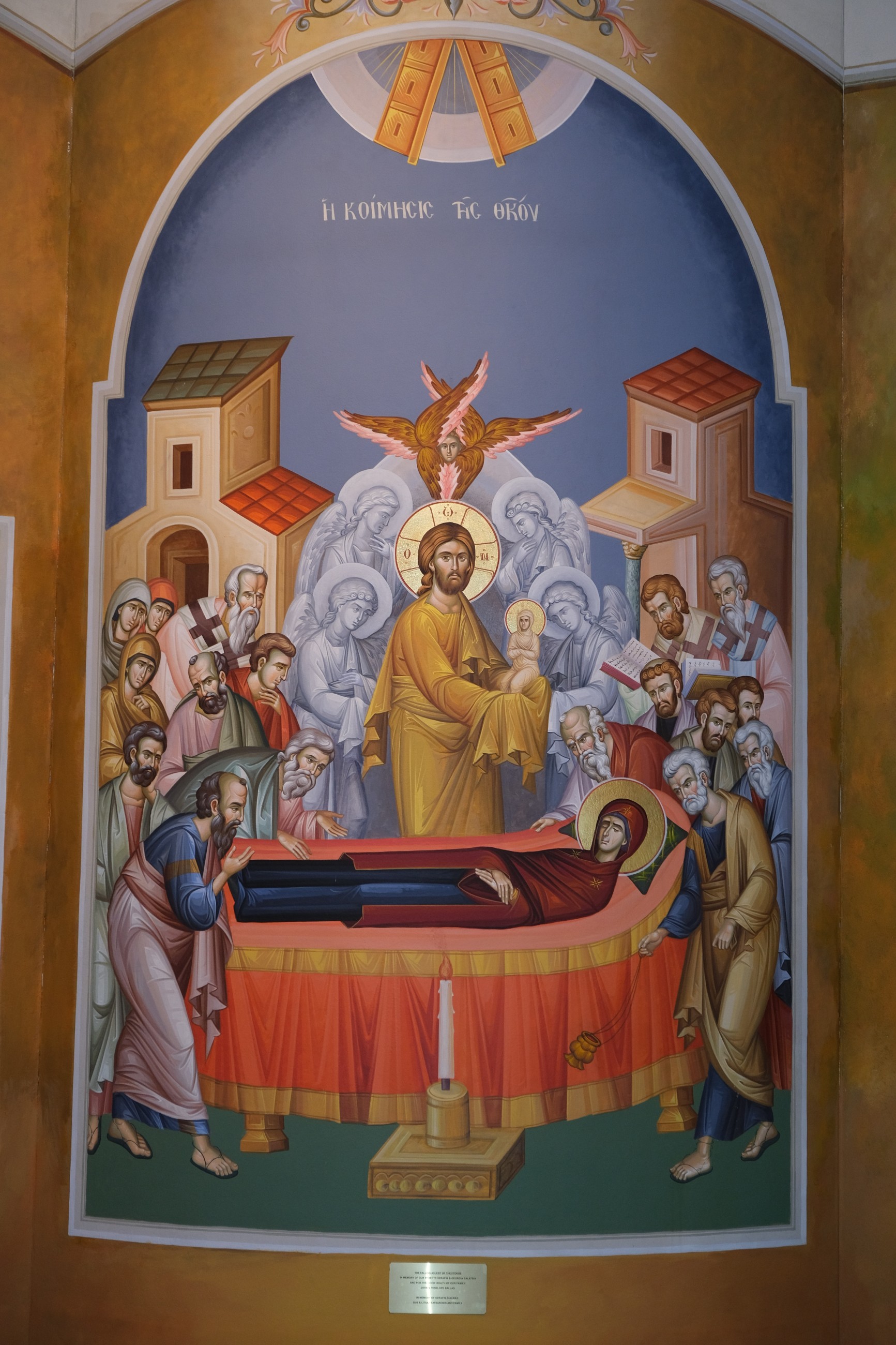
Concerning the Dormition of the Theotokos, this is what the Church has received from ancient times from the tradition of the Fathers. When the time drew nigh that our Savior was well-pleased to take His Mother to Himself, He declared unto her through an Angel that three days hence, He would translate her from this temporal life to eternity and bliss. On hearing this, she went up with haste to the Mount of Olives, where she prayed continuously. Giving thanks to God, she returned to her house and prepared whatever was necessary for her burial. While these things were taking place, clouds caught up the Apostles from the ends of the earth, where each one happened to be preaching, and brought them at once to the house of the Mother of God, who informed them of the cause of their sudden gathering. As a mother, she consoled them in their affliction as was meet, and then raised her hands to Heaven and prayed for the peace of the world. She blessed the Apostles, and, reclining upon her bed with seemliness, gave up her all-holy spirit into the hands of her Son and God. Learn More
[Greek Orthodox Archdiocese of America - June 22]
September 11
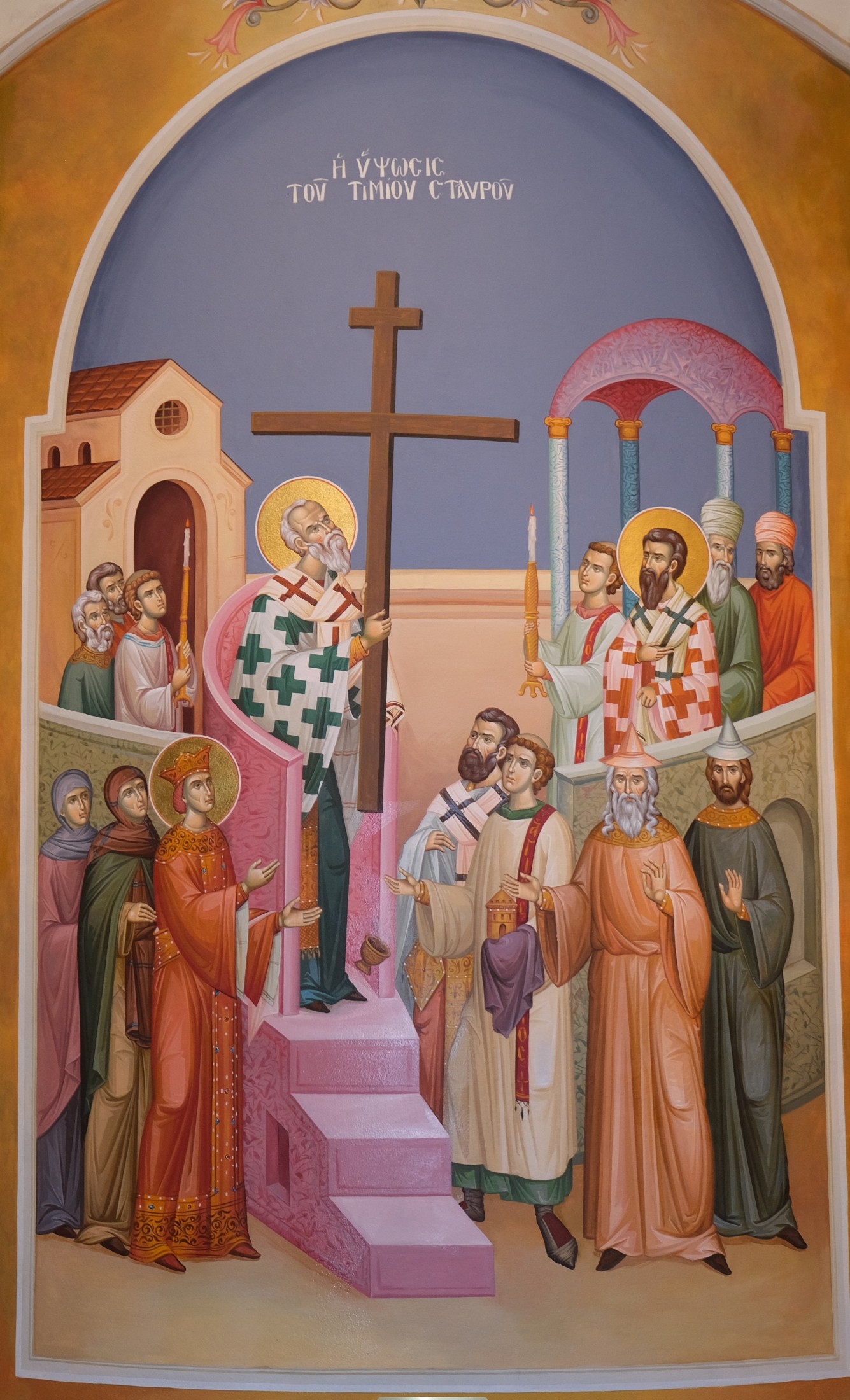
Saint Helen, the mother of Saint Constantine the Great, when she was already advanced in years, undertook, in her great piety, the hardships of a journey to Jerusalem in search of the cross, about the year 325. A temple to Aphrodite had been raised up by the Emperor Hadrian upon Golgotha, to defile and cover with oblivion the place where the saving Passion had been suffered. The venerable Helen had the statue of Aphrodite destroyed, and the earth removed, revealing the Tomb of our Lord, and three crosses. Of these, it was believed that one must be that of our Lord, the other two of the thieves crucified with Him; but Saint Helen was at a loss which one might be the Wood of our salvation. At the inspiration of Saint Macarius, Archbishop of Jerusalem, a lady of Jerusalem, who was already at the point of death from a certain disease, was brought to touch the crosses, and as soon as she came near to the Cross of our Lord, she was made perfectly whole. Consequently, the precious Cross was lifted on high by Archbishop Macarius of Jerusalem; as he stood on the ambo, and when the people beheld it, they cried out, "Lord have mercy." It should be noted that after its discovery, a portion of the venerable Cross was taken to Constantinople as a blessing. The rest was left in Jerusalem in the magnificent church built by Saint Helen, until the year 614. At that time, the Persians plundered Palestine and took the Cross to their own country (see Jan. 22, Saint Anastasius the Persian). Late, in the year 628, Emperor Heraclius set out on a military campaign, retrieved the Cross, and after bringing it to Constantinople, himself escorted it back to Jerusalem, where he restored it to its place. Learn More
[Greek Orthodox Archdiocese of America - June 22]
November 21
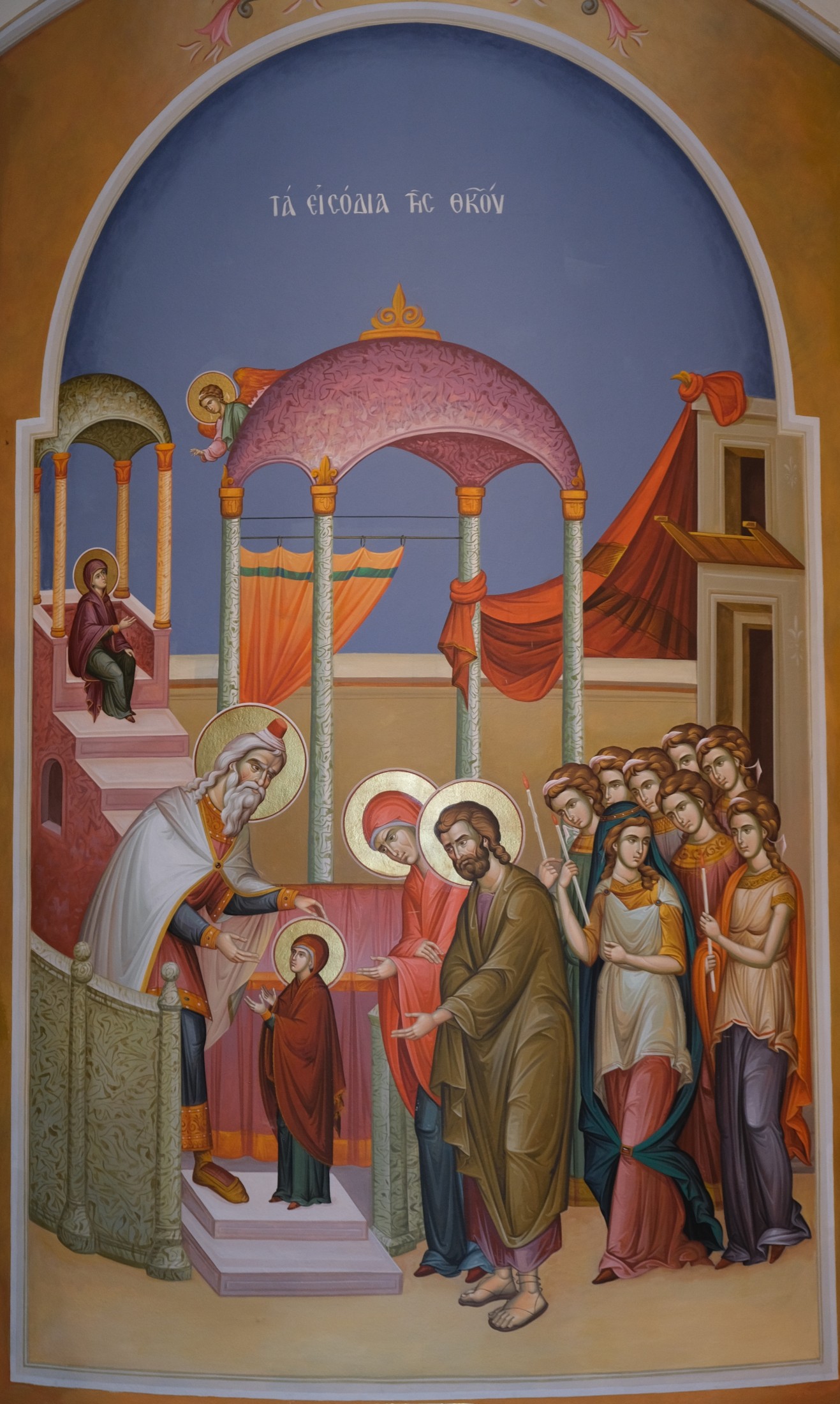
According to the tradition of the Church, the Theotokos was brought to the Temple at three years of age, where she was consecrated to God and spent her days until she was fourteen or fifteen years old; and then, as a mature maiden, by the common counsel of the priests (since her parents had reposed some three years before), she was betrothed to Joseph. Learn More
[Greek Orthodox Archdiocese of America - June 22]
December 25th
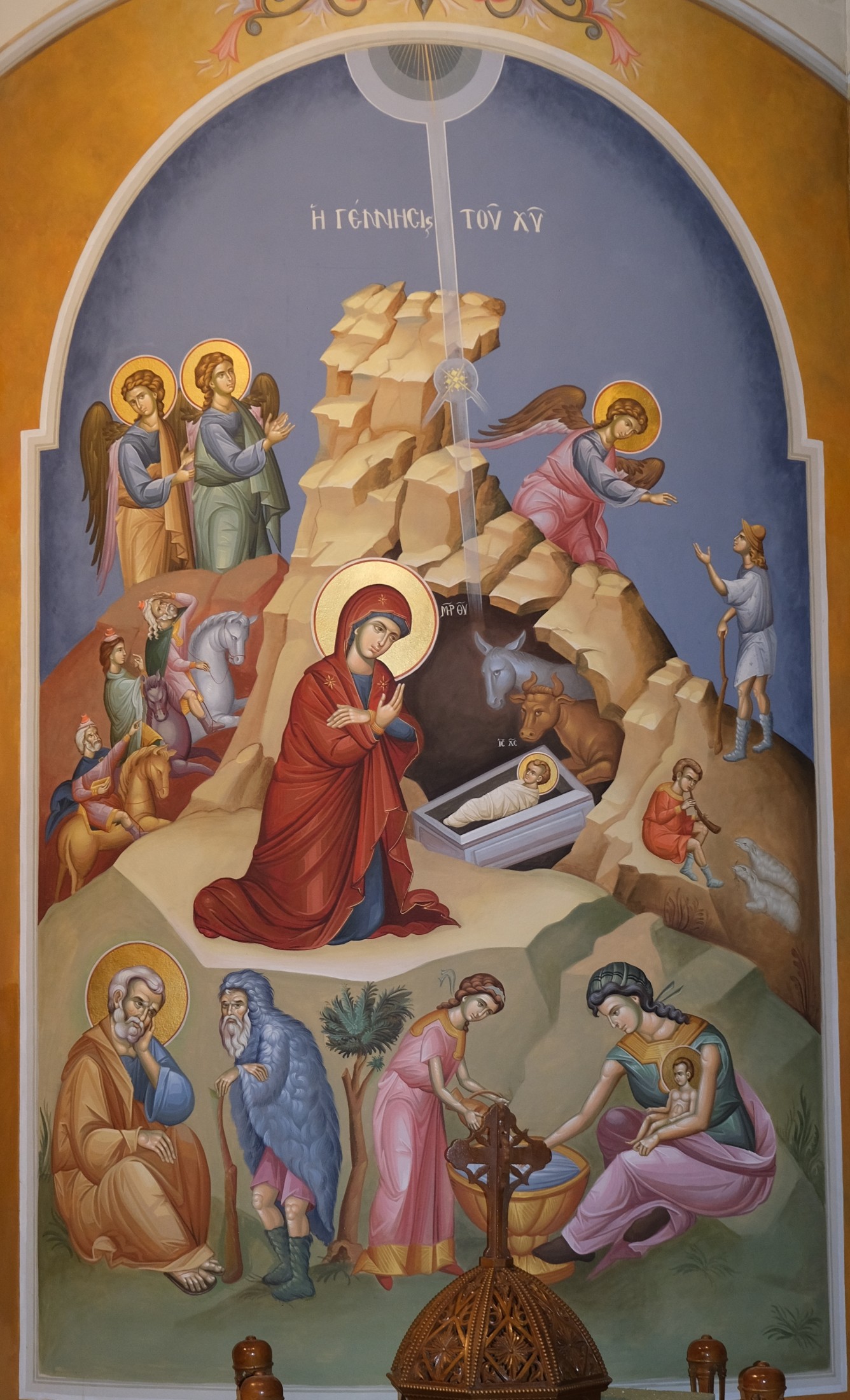
The incomprehensible and inexplicable Nativity of Christ came to pass when Herod the Great was reigning in Judea; the latter was an Ascalonite on his fathers's side and an Idumean on his mother's. He was in every way foreign to the royal line of David; rather, he had received his authority from the Roman emperors, and had ruled tyrannically over the Jewish people for some thirty-three years. The tribe of Judah, which had reigned of old, was deprived of its rights and stripped of all rule and authority. Such was the condition of the Jews when the awaited Messiah was born, and truly thus was fulfilled the prophecy which the Patriarch Jacob had spoken 1,807 years before: "A ruler shall not fail from Judah, nor a prince from his loins, until there come the things stored up for him; and he is the expectation of the nations" (Gen.49:10). Learn More
[Greek Orthodox Archdiocese of America - June 22]
January 6
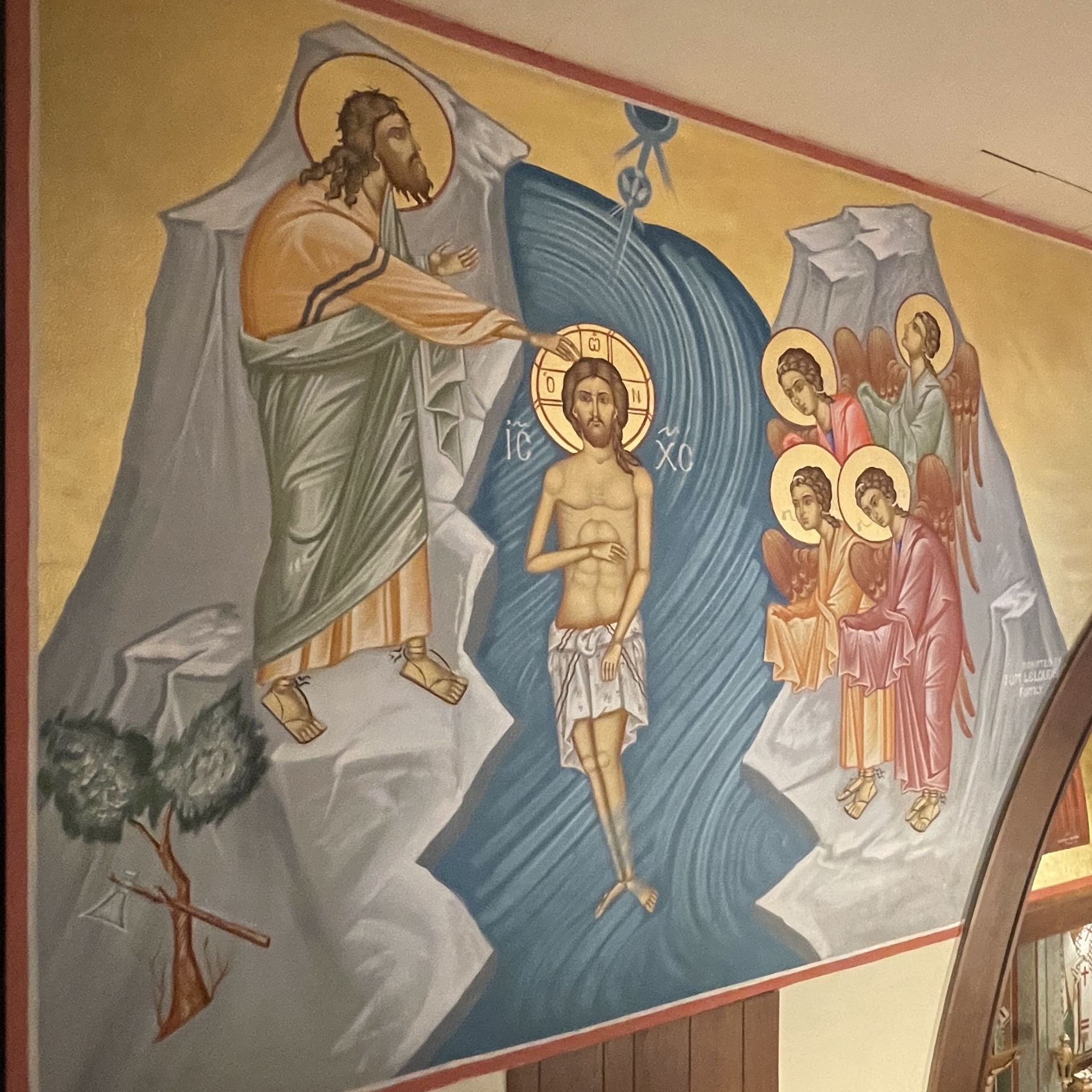
About the beginning of our Lord's thirtieth year, John the Forerunner, who was some six months older than Our Saviour according to the flesh, and had lived in the wilderness since his childhood, received a command from God and came into the parts of the Jordan, preaching the baptism of repentance unto the remission of sins. Then our Saviour also came from Galilee to the Jordan, and sought and received baptism though He was the Master and John was but a servant. Whereupon, there came to pass those marvellous deeds, great and beyond nature: the Heavens were opened, the Spirit descended in the form of a dove upon Him that was being baptized and the voice was heard from the Heavens hearing witness that this was the beloved Son of God, now baptized as a man (Matt. 3:13-17; Mark 1:9-11; Luke 3:1-22). From these events the Divinity of the Lord Jesus Christ and the great mystery of the Trinity were demonstrated. It is also from this that the present feast is called "Theophany," that is, the divine manifestation, God's appearance among men. On this venerable day the sacred mystery of Christian baptism was inaugurated; henceforth also began the saving preaching of the Kingdom of the Heavens. Learn More
[Greek Orthodox Archdiocese of America - June 22]
February 2
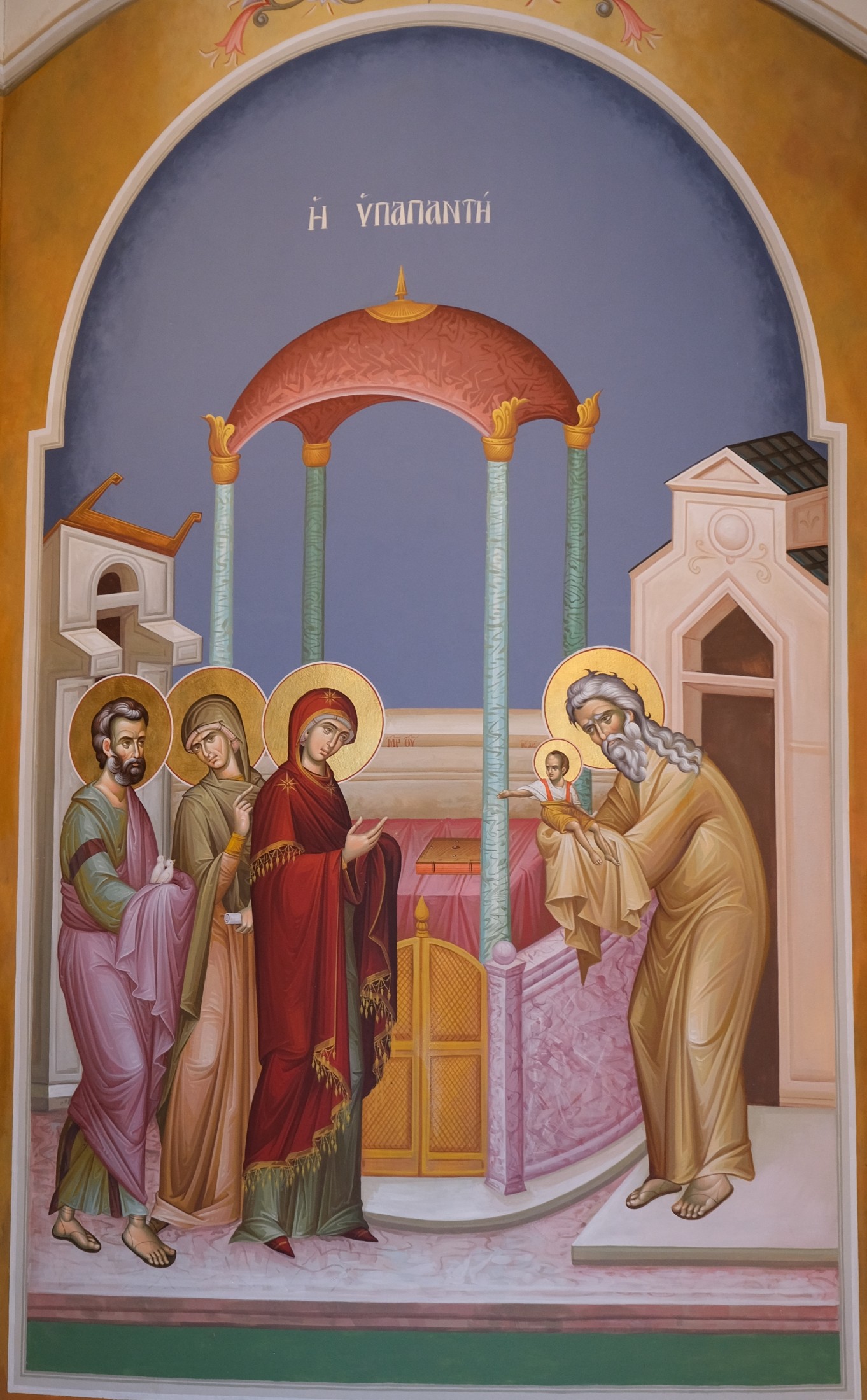
When the most pure Mother and Ever-Virgin Mary's forty days of purification had been fulfilled, she took her first-born Son to Jerusalem on this, the fortieth day after His birth, that she might present Him in the temple according to the Law of Moses, which teaches that every first-born male child be dedicated to God, and also that she might offer the sacrifice of a pair of turtle-doves or two young pigeons, as required by the Law (Luke 2:22-24; Exod. 13:2; Lev. 12:6-8). On this same day, a just and devout man, the greatly aged Symeon, was also present in the temple, being guided by the Holy Spirit. For a long time, this man had been awaiting the salvation of God, and he had been informed by divine revelation that he would not die until he beheld the Lord's Christ. Thus, when he beheld Him at that time and took Him up into his aged arms, he gave glory to God, singing: "Now lettest Thou Thy servant depart in peace, O Master. . ." And he confessed that he would close his eyes joyfully, since he had seen the Light of revelation for the nations and the Glory of Israel (Luke 2:25-32). From ancient times, the Holy Church has retained this tradition of the churching of the mother and new-born child on the fortieth day and of the reading of prayers of purification. Learn More
[Greek Orthodox Archdiocese of America - June 22]
March 25
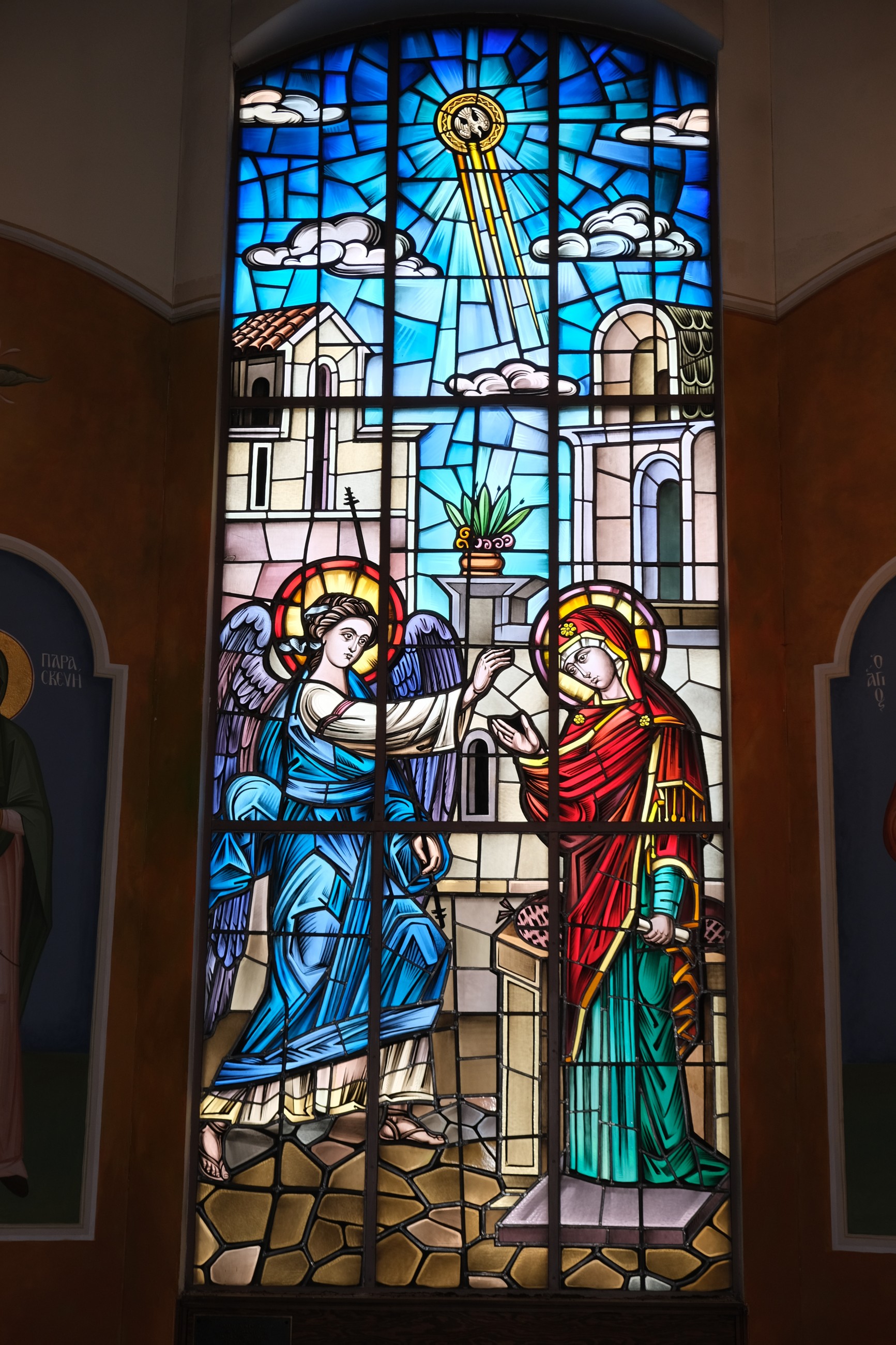
Six months after John the Forerunner's conception, the Archangel Gabriel was sent by God to Nazareth, a town of Galilee, unto Mary the Virgin, who had come forth from the Temple a mature maiden (see Nov. 21). According to the tradition handed down by the Fathers, she had been betrothed to Joseph four months. On coming to Joseph's house, the Archangel declared: "Rejoice, thou Full of Grace, the Lord is with thee: blessed art thou among women." After some consideration, and turmoil of soul, and fear because of this greeting, the Virgin, when she had finally obtained full assurance concerning God's unsearchable condescension and the ineffable dispensation that was to take place through her, and believing that all things are possible to the Most High, answered in humility: "Behold the handmaid of the Lord; be it unto me according to thy word." And at this, the Holy Spirit came upon her, and the power of the Most High overshadowed her all-blameless womb, and the Son and Word of God, Who existed before the ages, was conceived past speech and understanding, and became flesh in her immaculate body (Luke 1:26-38). Learn More
[Greek Orthodox Archdiocese of America - June 22]
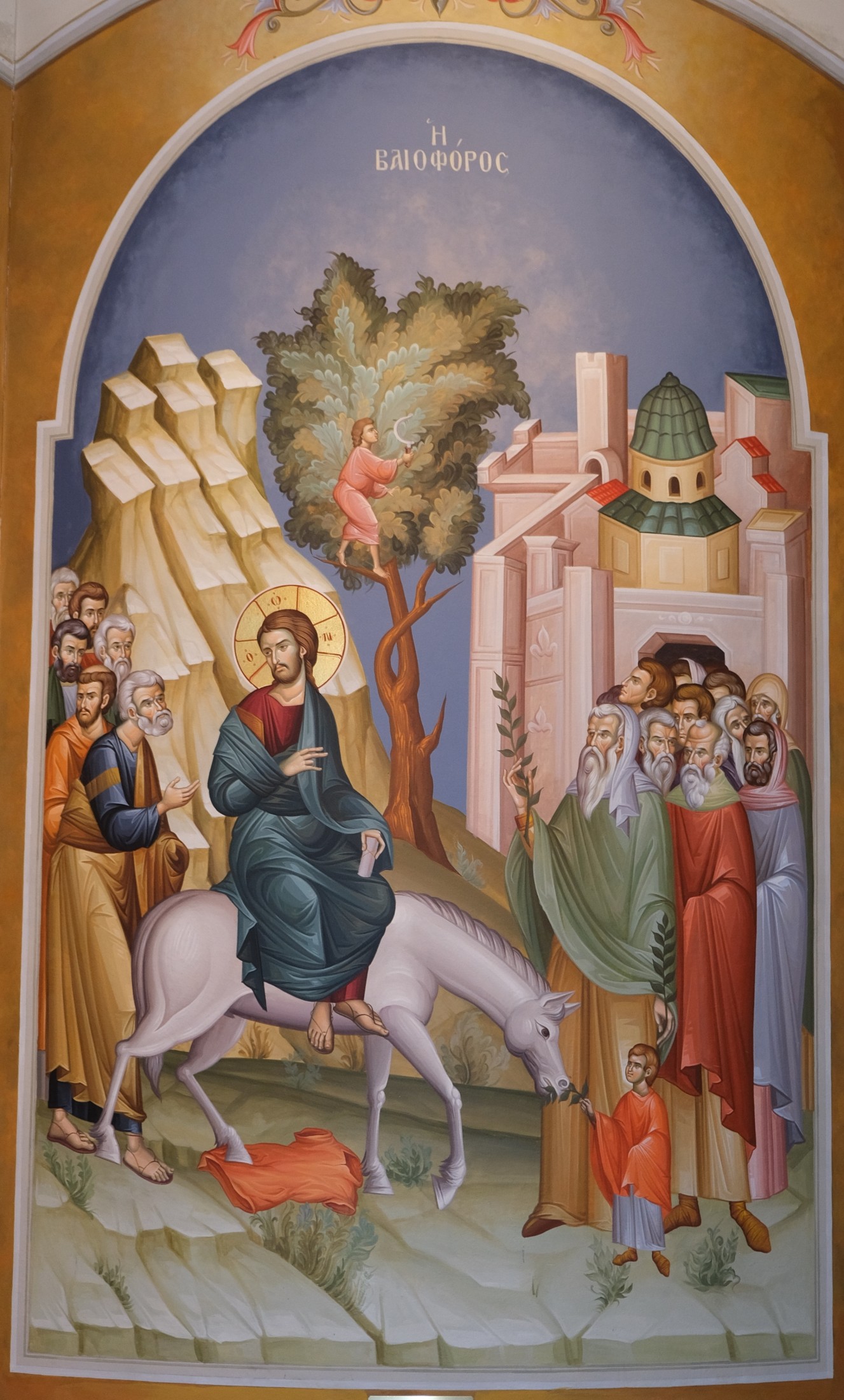
On Sunday, five days before the Passover of the Law, the Lord came from Bethany to Jerusalem. Sending two of His disciples to bring Him a foal of an ass, He sat thereon and entered into the city. When the multitude there heard that Jesus was coming, they straightway took up the branches of palm trees in their hands, and went forth to meet Him. Others spread their garments on the ground, and yet others cut branches from the trees and strewed them in the way that Jesus was to pass; and all of them together, especially the children, went before and after Him, crying out: "Hosanna: Blessed is He that cometh in the Name of the Lord, the King of Israel" (John 12:13). This is the radiant and glorious festival of our Lord's entry into Jerusalem that we celebrate today. Learn More
[Greek Orthodox Archdiocese of America - June 22]
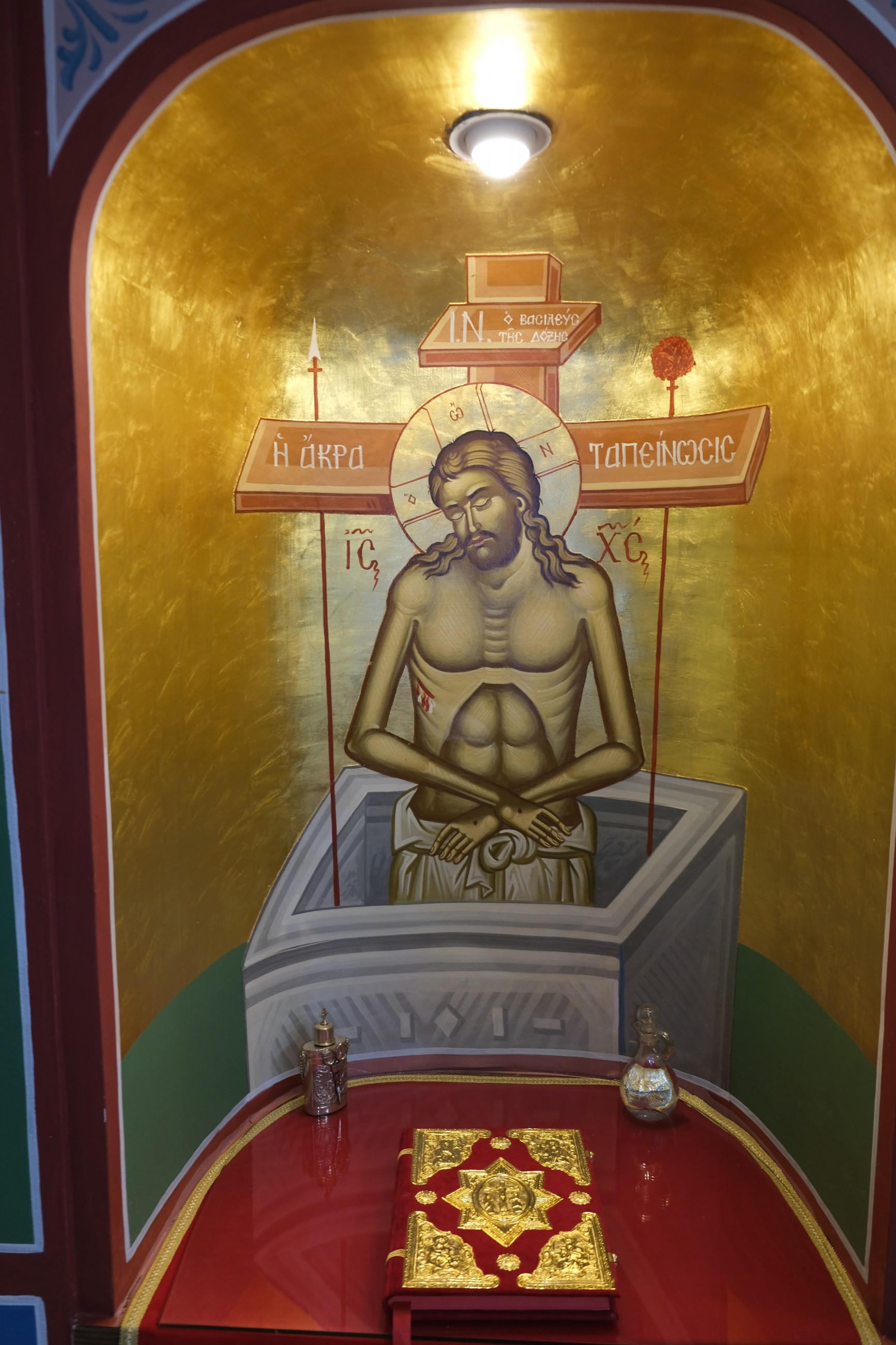
Beginning on the evening of Palm Sunday and continuing through the evening of Holy Tuesday, the Orthodox Church observes a special service known as the Service of the Bridegroom. Each evening service is the Matins or Orthros service of the following day (e.g. the service held on Sunday evening is the Orthros service for Holy Monday). The name of the service is from the figure of the Bridegroom in the parable of the Ten Virgins found in Matthew 25:1-13. Learn More
[Greek Orthodox Archdiocese of America - July 4]
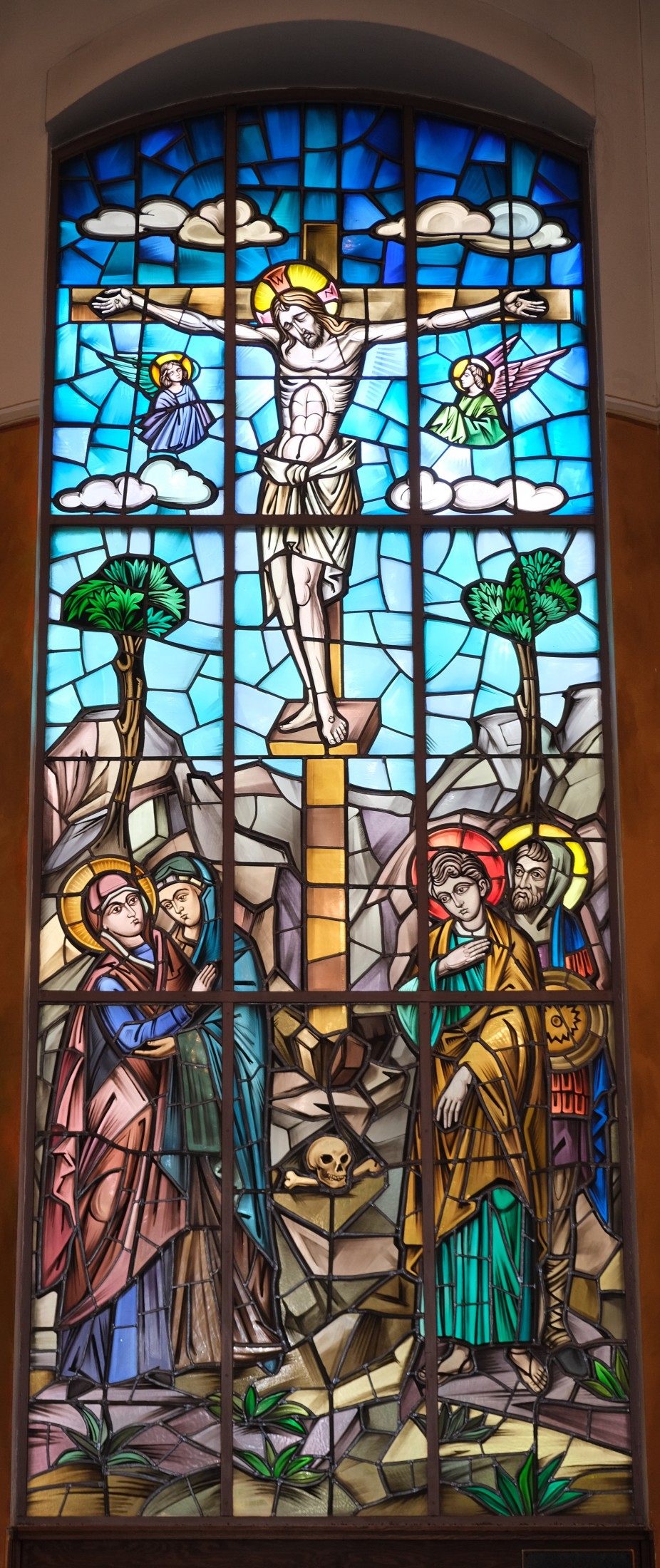
On Great and Holy Friday the Orthodox Church commemorates the death of Christ on the Cross. This is the culmination of the observance of His Passion by which our Lord suffered and died for our sins. This commemoration begins on Thursday evening with the Matins of Holy Friday and concludes with a Vespers on Friday afternoon that observes the un-nailing of Christ from the Cross and the placement of His body in the tomb. Learn More
[Greek Orthodox Archdiocese of America - July 4]
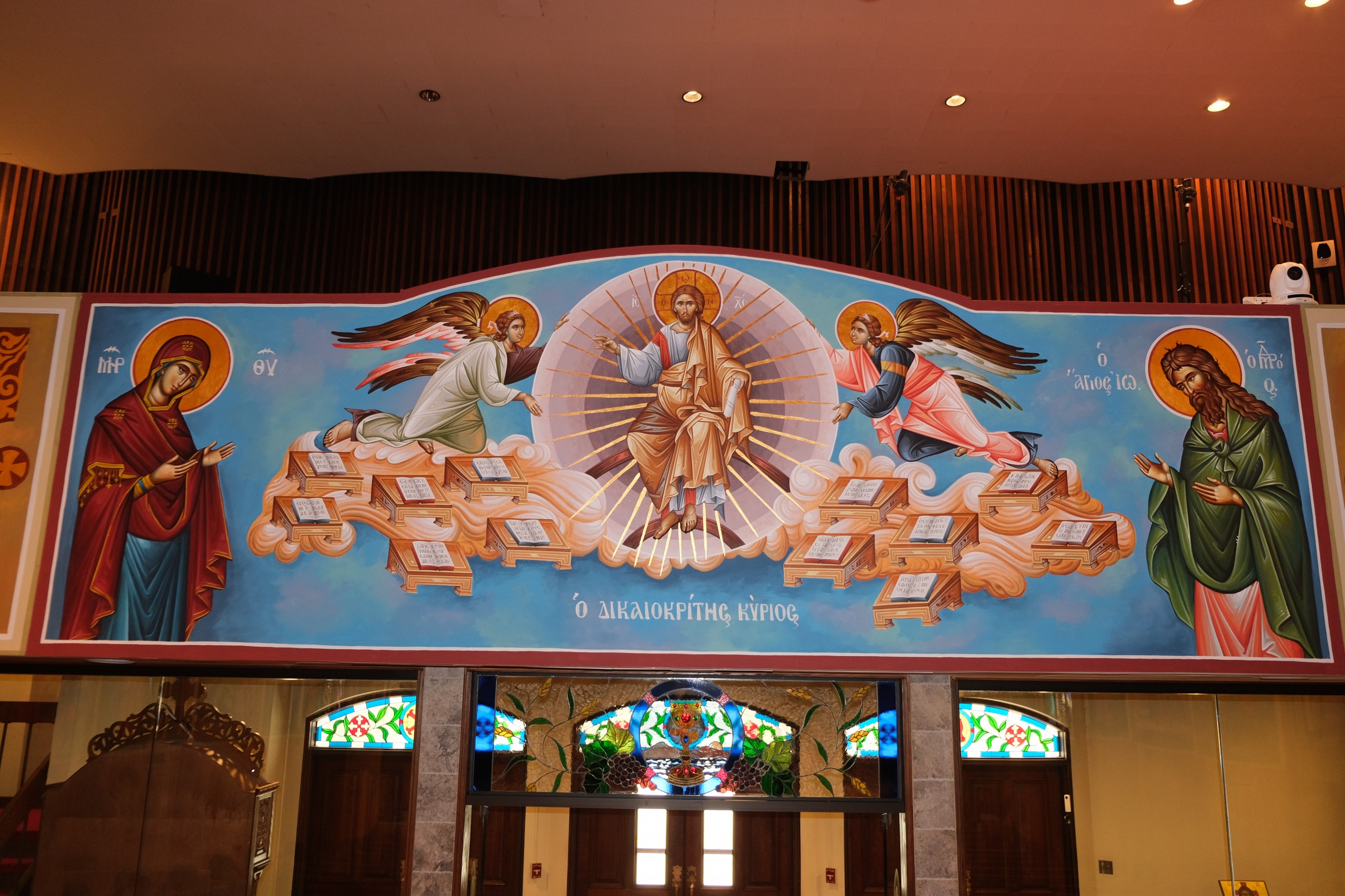
For the Orthodox Church, the End Times portending the end of this age began with the preaching of the First Forerunner, John the Baptist, who cried out to the people, "Repent, for the Kingdom of Heaven is at hand (Matthew 3:2)." The Lord Jesus Christ took up the same message when He began His public ministry (Matthew 4:17) after the beheading of John the Baptist. Throughout His public ministry Christ constantly preached of the coming Kingdom.Learn More
[Metropolitan Isaiah of Denver (2003) - July 4]
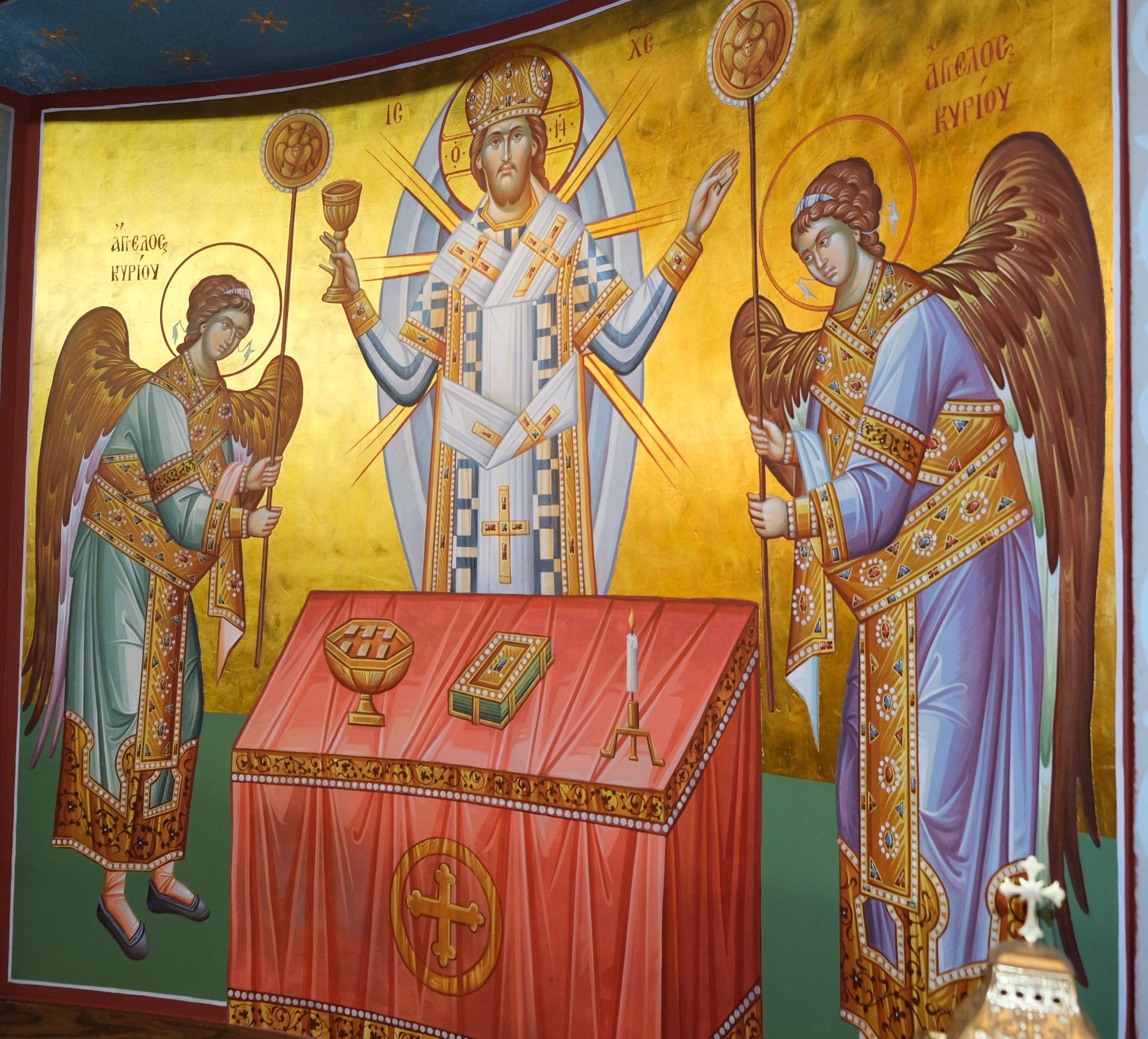
For the Orthodox Church, the End Times portending the end of this age began with the preaching of the First Forerunner, John the Baptist, who cried out to the people, "Repent, for the Kingdom of Heaven is at hand (Matthew 3:2)." The Lord Jesus Christ took up the same message when He began His public ministry (Matthew 4:17) after the beheading of John the Baptist. Throughout His public ministry Christ constantly preached of the coming Kingdom.Learn More
[Metropolitan Isaiah of Denver (2003) - July 4]
December 12
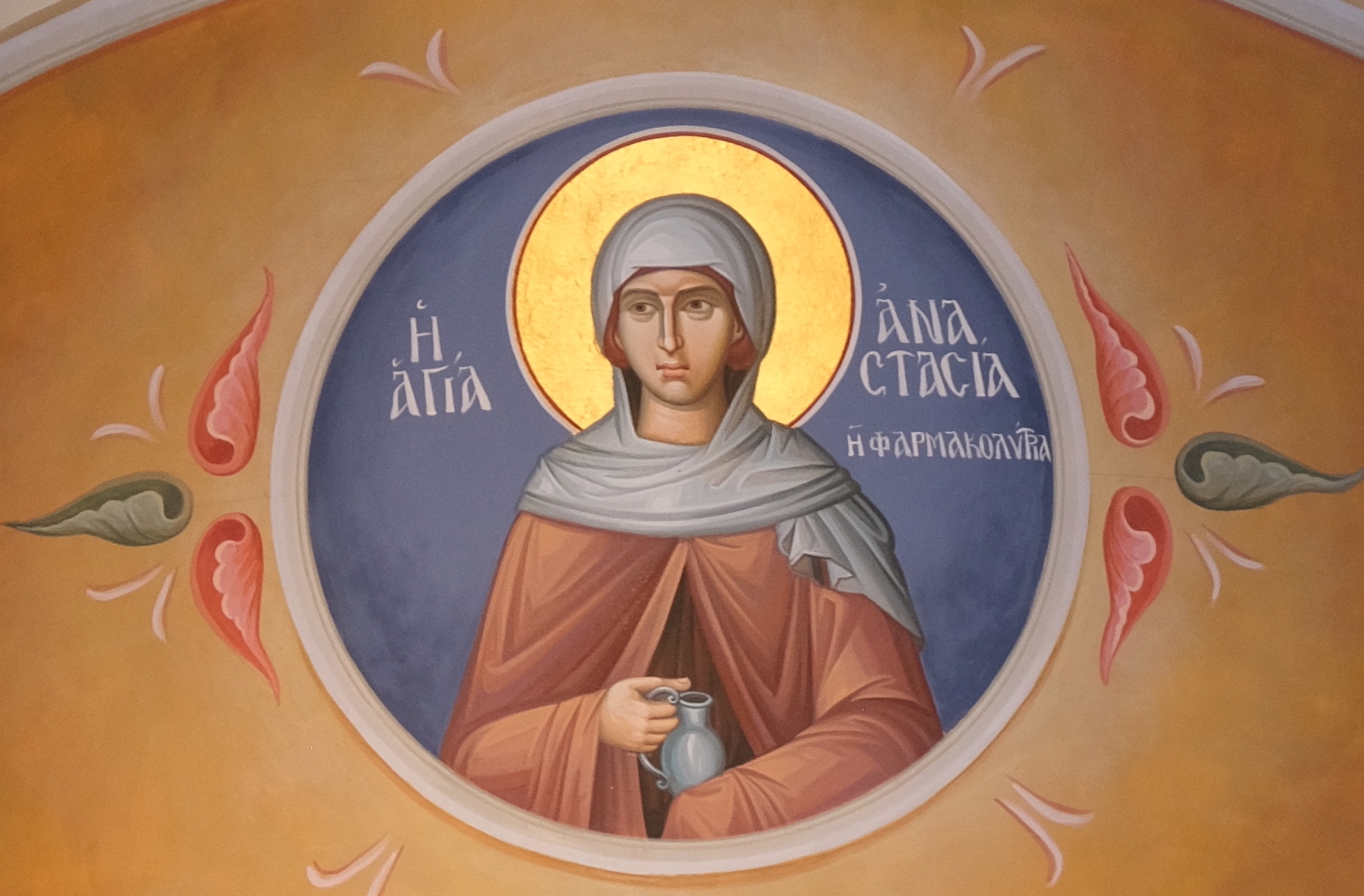
This Saint, who was from Rome, was a most comely, wealthy, and virtuous maiden, the daughter of Praepextatus and Fausta. It was her mother who instructed her in the Faith of Christ. The Saint was joined to a man named Publius Patricius, who was prodigal in life and impious in disposition, but she was widowed after a short time. Henceforth, she went about secretly to the dwellings of the poor and the prisons where the Martyrs of Christ were, and brought them whatever was needed for their daily subsistence. She washed their wounds and loosed them from their fetters, and consoled them in their anguish. Also, because the Saint, through her intercessions, has healed many from the ill effects of spells, potions, poisons, and other harmful substances, she has received the name "Deliverer from Potions." Since the fame of her deeds had spread about, she was arrested by Diocletian's minions, and after enduring many torments she was put to death by fire in the year 290. Learn More
[Greek Orthodox Archdiocese of America - June 24]
September 9
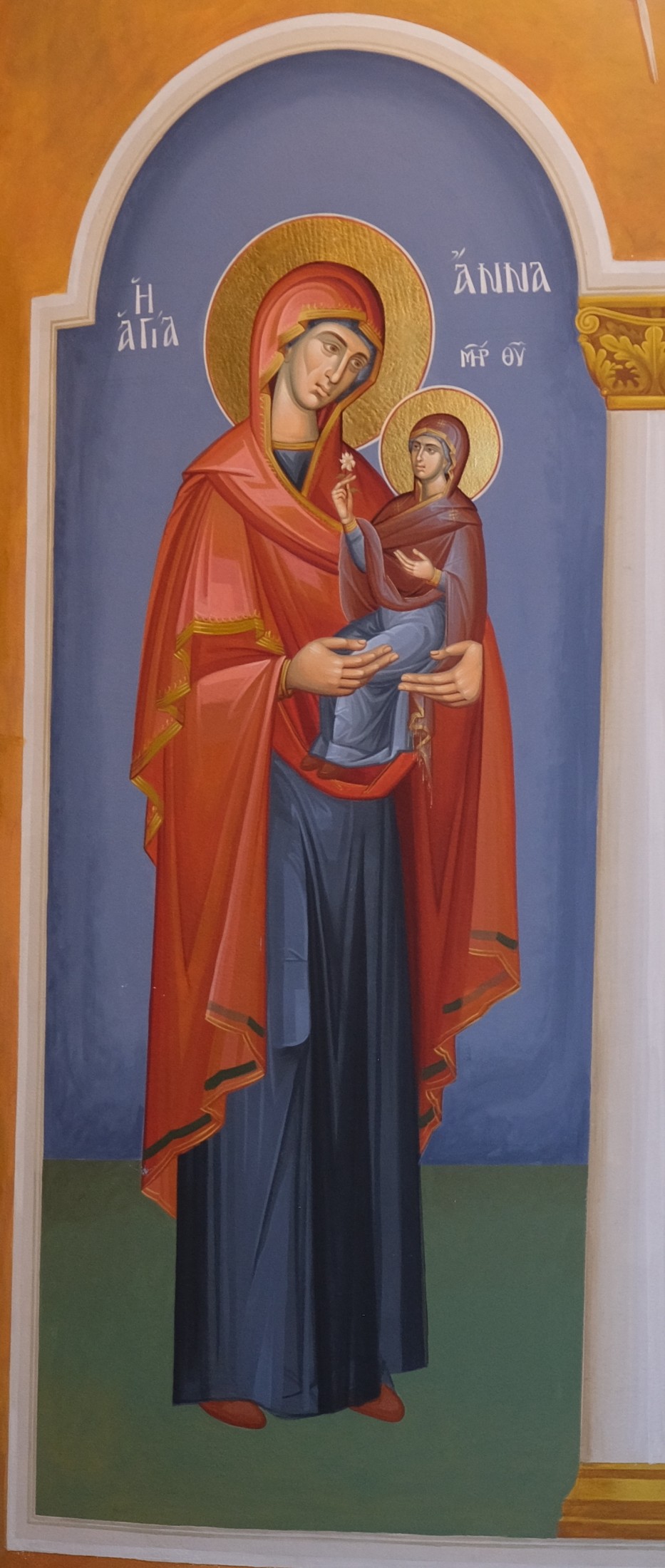
According to tradition, Anna, the ancestor of God, lived for sixty-nine years, and her spouse Joachim, for eighty; according to one account, Saint Joachim died two years before Saint Anna. The Theotokos had been orphaned of both her parents already when she was eleven years of age, when she was living in the Temple (see Sept. 8 and Nov. 21). Saint Anna is invoked for conceiving children, and for help in difficult childbirth. Learn More
[Greek Orthodox Archdiocese of America - June 24]
January 17
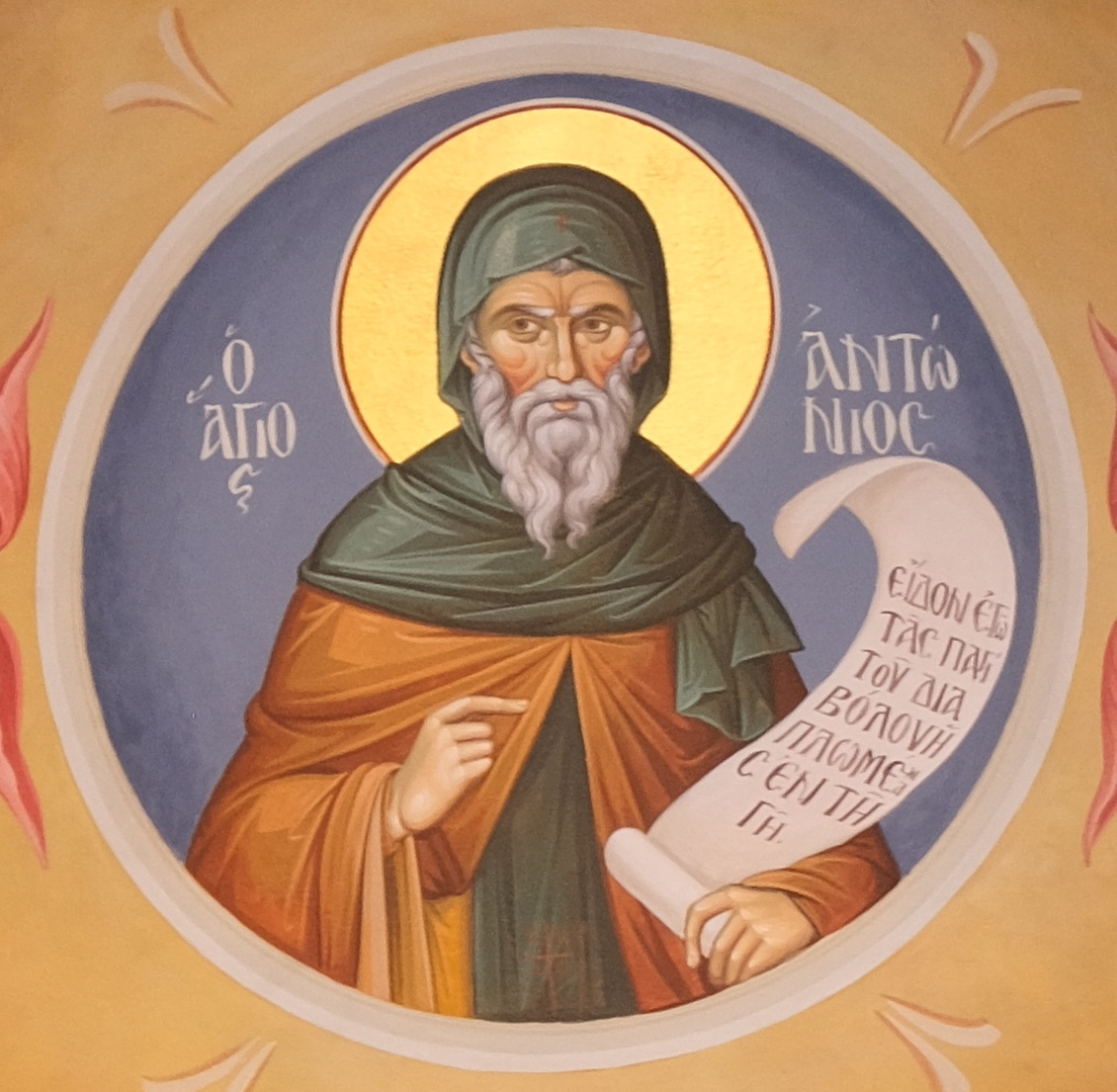
Saint Anthony, the Father of monks, was born in Egypt in 251 of pious parents who departed this life while he was yet young. On hearing the words of the Gospel: "If thou wilt be perfect, go and sell what thou hast, and give to the poor" (Matt. 19:21), he immediately put it into action. Distributing to the poor all he had, and fleeing from all the turmoil of the world, he departed to the desert. The manifold temptations he endured continually for the span of twenty years are incredible. His ascetic struggles by day and by night, whereby he mortified the uprisings of the passions and attained to the height of dispassion, surpass the bounds of nature; and the report of his deeds of virtue drew such a multitude to follow him that the desert was transformed into a city, while he became, so to speak, the governor, lawgiver, and master-trainer of all the citizens of this newly-formed city. Learn More
[Greek Orthodox Archdiocese of America - June 24]
January 18
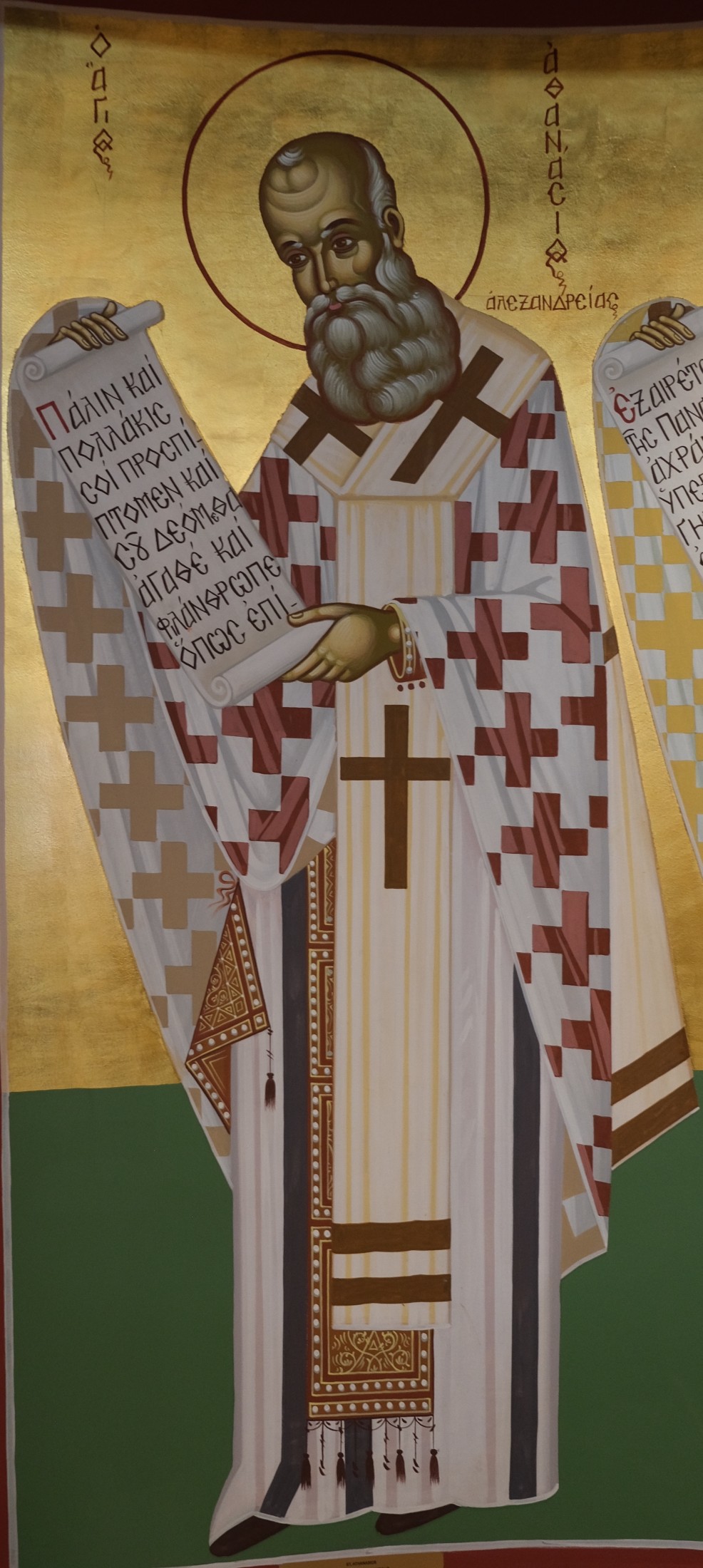
In the half-century after the First Ecumenical Council held in Nicea in 325, if there was one man whom the Arians feared and hated more intensely than any other, as being able to lay bare the whole error of their teaching, and to marshal, even from exile or hiding, the beleaguered forces of the Orthodox, it was Saint Athanasios the Great. This blazing lamp of Orthodoxy, which imperial power and heretics' plots could not quench when he shone upon the lampstand, nor find when he was hid by the people and monks of Egypt, was born in Alexandria about the year 296. He received an excellent training in Greek letters and especially in the sacred Scriptures, of which he shows an exceptional knowledge in his writings. Even as a young man he had a remarkable depth of theological understanding; he was only about twenty years old when he wrote his treatise "On the Incarnation." Saint Alexander, the Archbishop of Alexandria, brought him up in piety, ordained him his deacon, and after deposing Arius for his blasphemy against the Divinity of the Son of God, took Athanasios to the First Council in Nicea in 325. Saint Athanasios was to spend the remainder of his life laboring in defense of this Holy Council. In 326, before his death, Alexander appointed Athanasios his successor. Learn More
[Greek Orthodox Archdiocese of America - July 4]
December 4
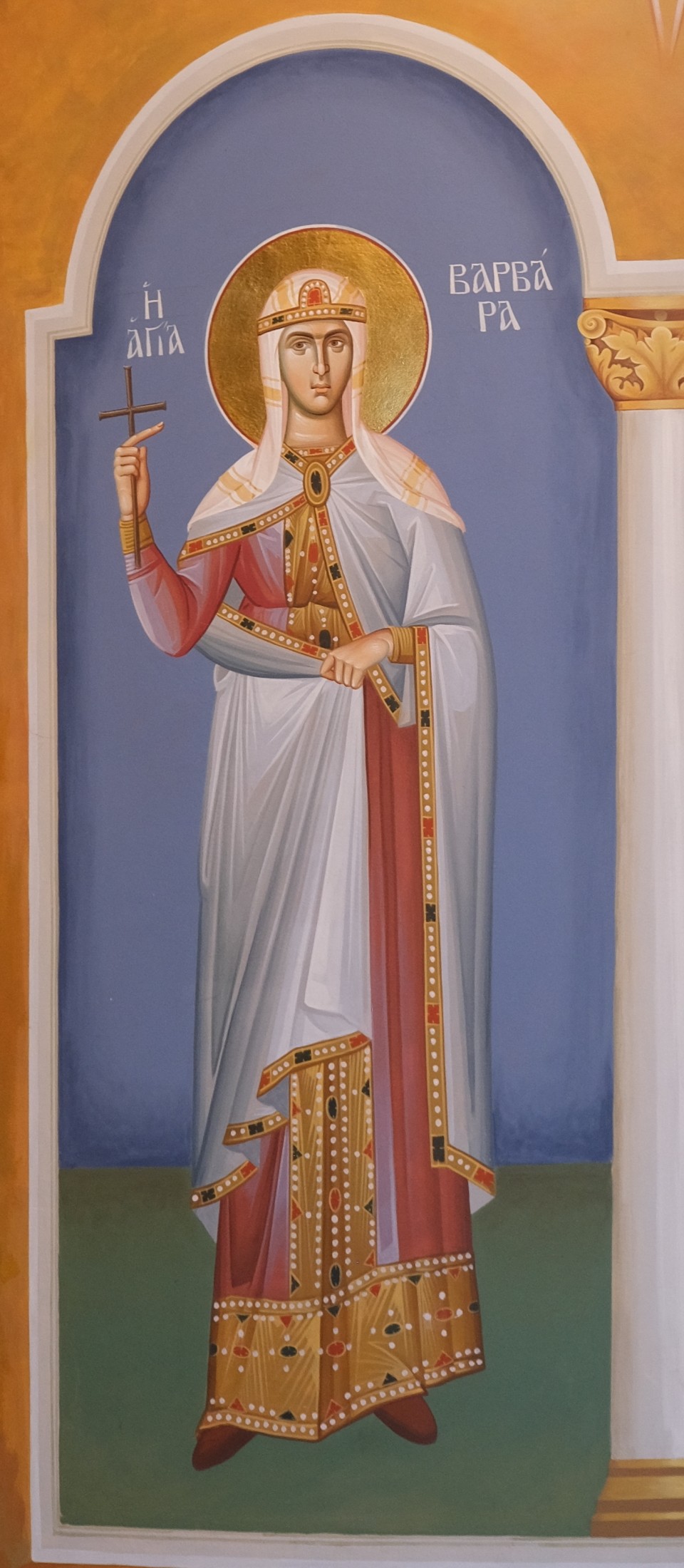
Saint Barbara was from Heliopolis of Phoenicia and lived during the reign of Maximian. She was the daughter of a certain idolater named Dioscorus. When Barbara came of age, she was enlightened in her pure heart and secretly believed in the Holy Trinity. About this time Dioscorus began building a bath-house; before it was finished he was required to go away to attend to certain matters, and in his absence Barbara directed the workmen to build a third window in addition to the two her Father had commanded. She also inscribed the sign of the Cross with her finger upon the marble of the bath-house, leaving the saving sign cut as deeply into the marble as if it had been done with an iron tool. (When the Synaxarion of Saint Barbara was written, the marble of the bath-house and the cross inscribed by Saint Barbara were still preserved, and many healings were worked there.) When Dioscorus returned, he asked why the third window had been added; Barbara began to declare to him the mystery of the Trinity. Because she refused to renounce her faith, Dioscorus tortured Barbara inhumanely, and after subjecting her to many sufferings he beheaded her with his own hands, in the year 290. Learn More
[Greek Orthodox Archdiocese of America - June 24]
January 1
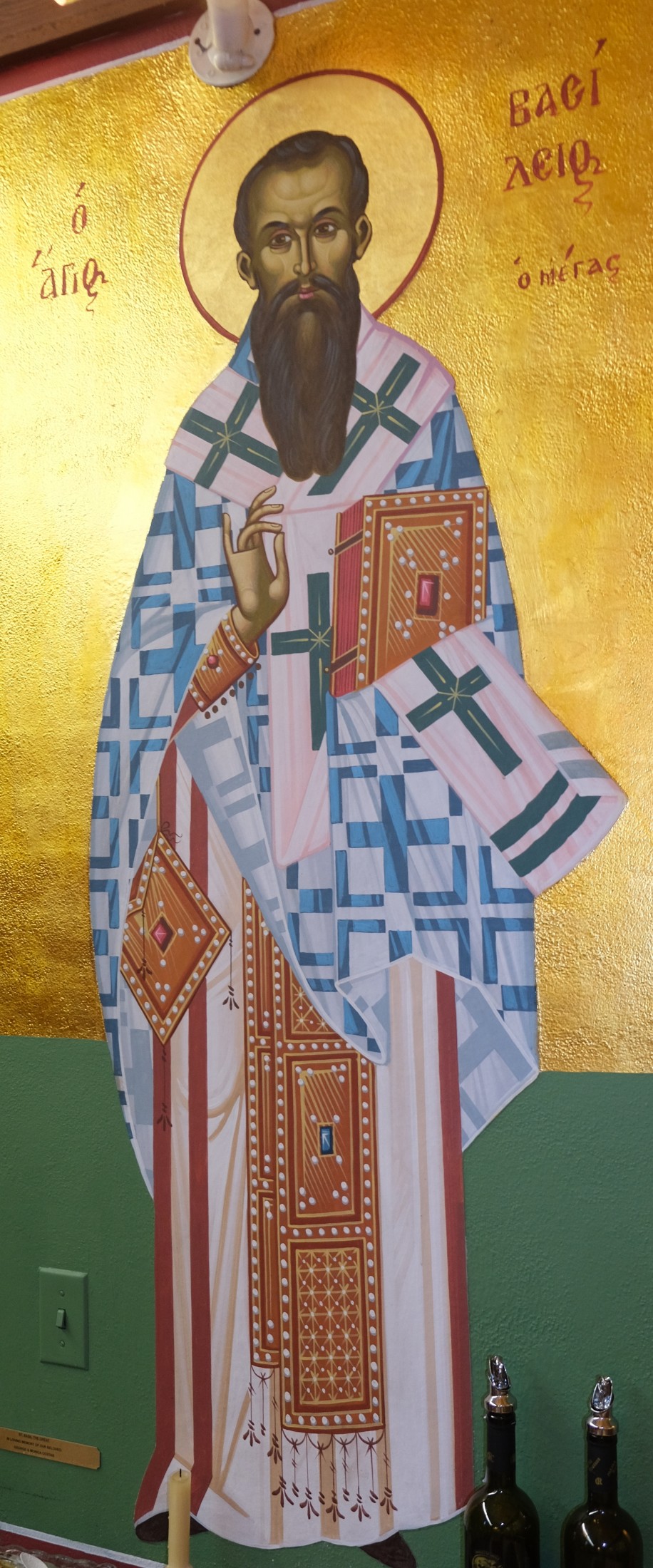
Saint Basil the Great was born about the end of the year 329 in Caesarea of Cappadocia, to a family renowned for their learning and holiness. His parents' names were Basil and Emily. His mother Emily (commemorated July 19) and his grandmother Macrina (Jan. 14) are Saints of the Church, together with all his brothers and sisters: Macrina, his elder sister (July 19), Gregory of Nyssa (Jan. 10), Peter of Sebastia (Jan. 9), and Naucratius. Basil studied in Constantnople under the sophist Libanius, then in Athens, where also he formed a friendship with the young Gregory, a fellow Cappadocian, later called "the Theologian." Through the good influence of his sister Macrina (see July 19), he chose to embrace the ascetical life, abandoning his worldly career. He visited the monks in Egypt, in Palestine, in Syria, and in Mesopotamia, and upon returning to Caesarea, he departed to a hermitage on the Iris River in Pontus, not far from Annesi, where his mother and his sister Macrina were already treading the path of the ascetical life; here he also wrote his ascetical homilies. Learn More
[Greek Orthodox Archdiocese of America - June 24]
November 25
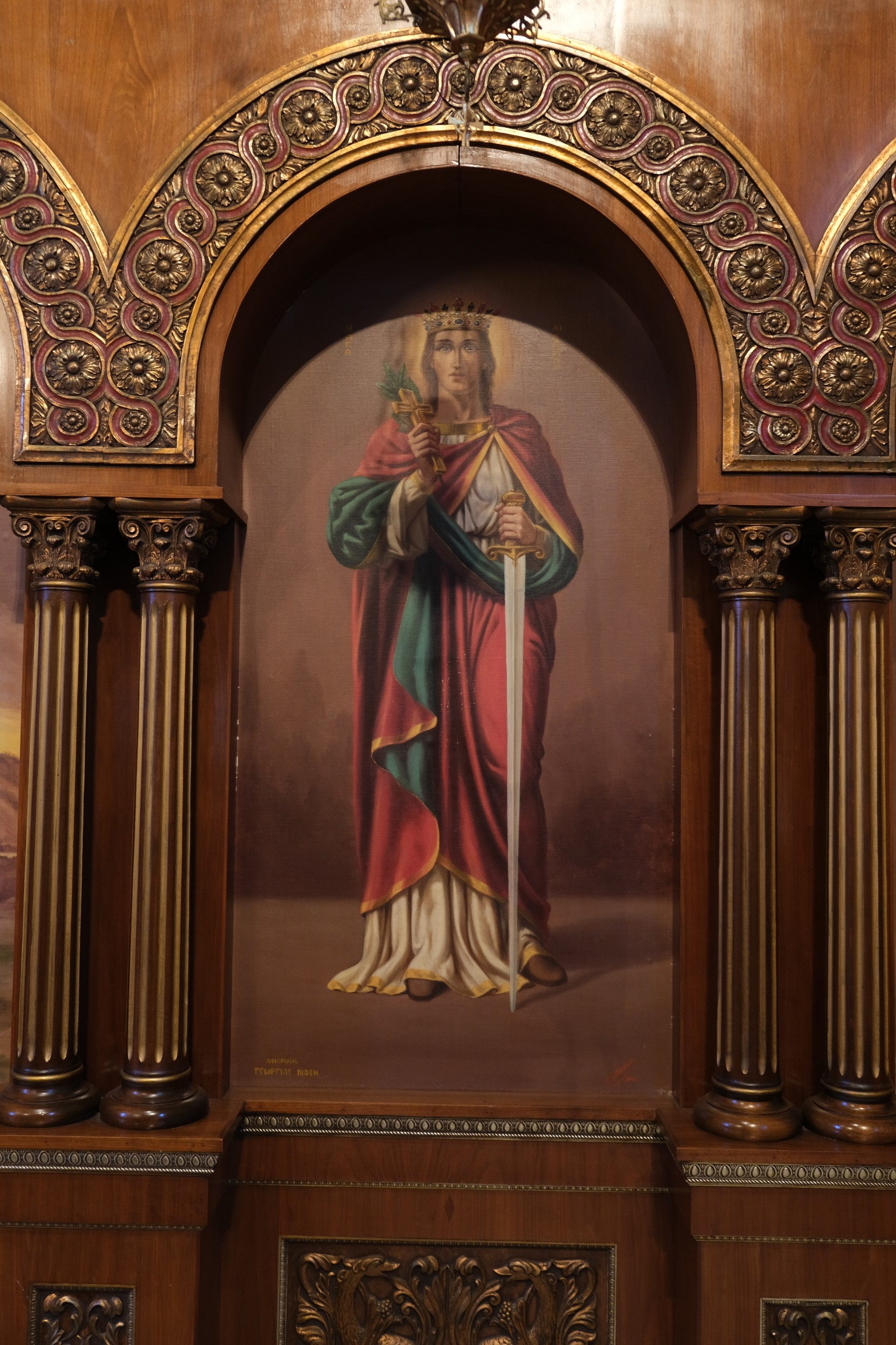
Saint Catherine, who was from Alexandria, was the daughter of Constas (or Cestus). She was an exceedingly beautiful maiden, most chaste, and illustrious in wealth, lineage, and learning. By her steadfast understanding, she utterly vanquished the passionate and unbridled soul of Maximinus, the tyrant of Alexandria; and by her eloquence, she stopped the mouths of the so-called philosophers who had been gathered to dispute with her. She was crowned with the crown of martyrdom in the year 305. Her holy relics were taken by Angels to the holy mountain of Sinai, where they were discovered many years later; the famous monastery of Saint Catherine was originally dedicated to the Holy Transfiguration of the Lord and the Burning Bush, but later was dedicated to Saint Catherine. According to the ancient usage, Saints Catherine and Mercurius were celebrated on the 24th of this month, whereas the holy Hieromartyrs Clement of Rome and Peter of Alexandria were celebrated on the 25th. The dates of the feasts of these Saints were interchanged at the request of the Church and Monastery of Mount Sinai, so that the festival of Saint Catherine, their patron, might be celebrated more festively together with the Apodosis of the Feast of the Entry of the Theotokos. The Slavic Churches, however, commemorate these Saints on their original dates. Learn More
[Greek Orthodox Archdiocese of America - June 24]
February 10
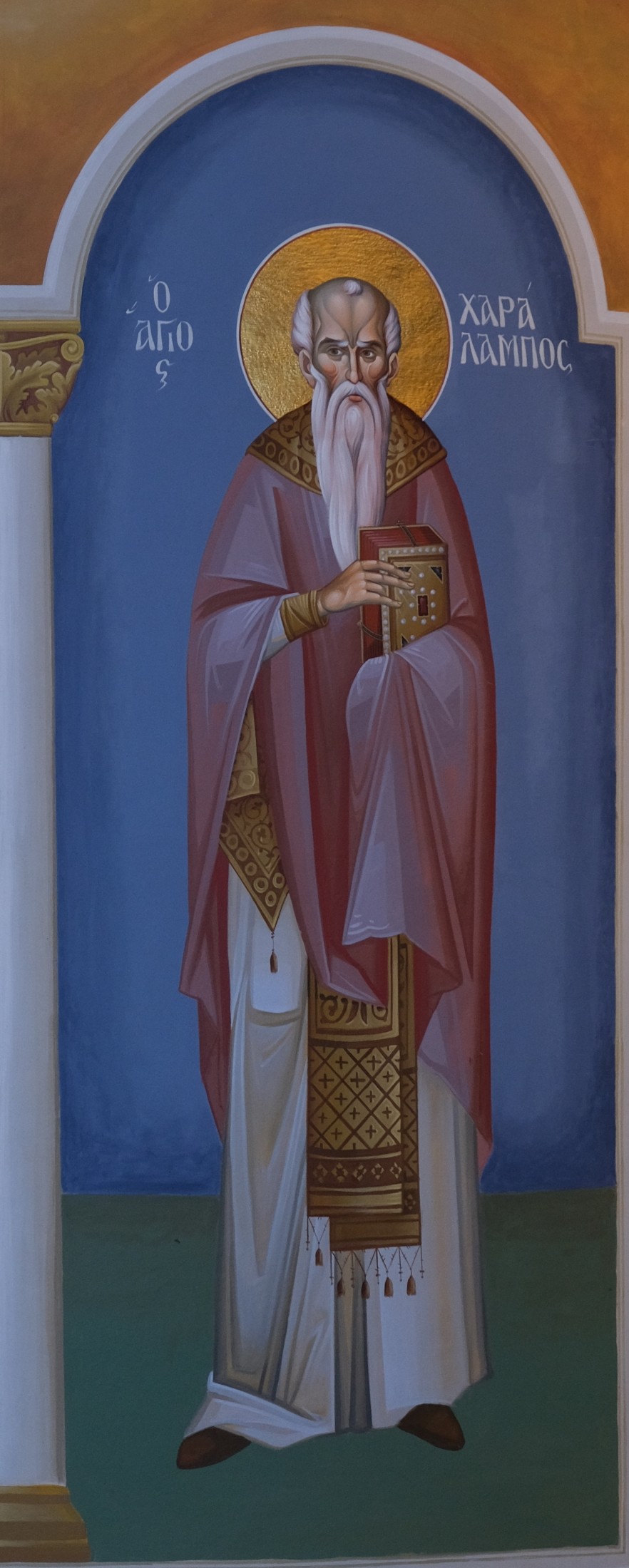
This Saint was a priest of the Christians in Magnesia, the foremost city of Thessaly, in the diocese having the same name. He contested during the reign of Alexander Severus (222-235), when Lucian was Proconsul of Magnesia. At the time of his martyrdom the Saint was 103 years of age. Learn More
[Greek Orthodox Archdiocese of America - July 5]
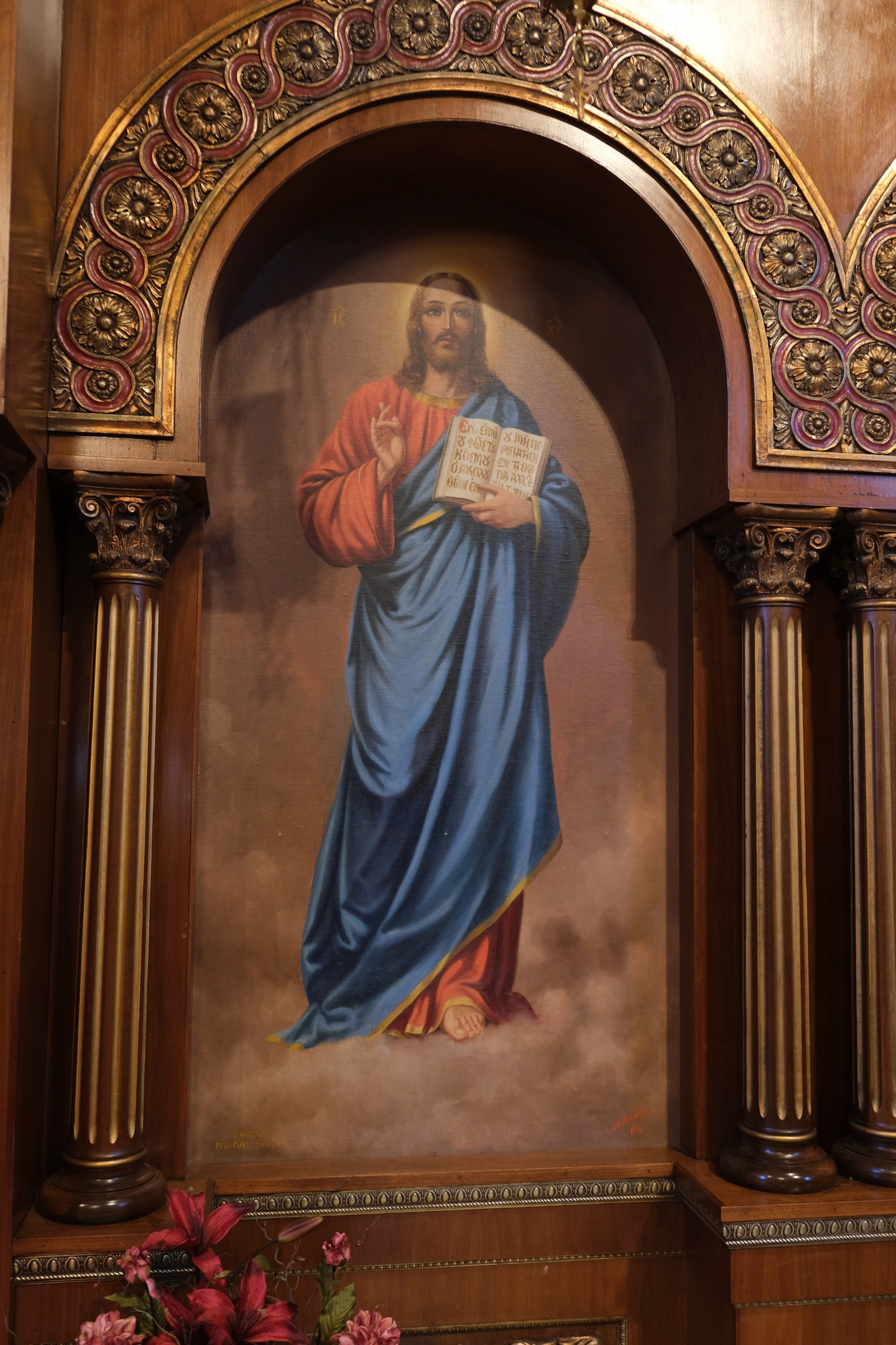
Who is Jesus Christ? He's the God-man, the eternal Son of God who, in the fullness of time, took on flesh and became fully human--while remaining fully God. This is so important because of what it means for our salvation. If we understand who Christ really is, we can understand who we really are. Learn More
[Greek Orthodox Archdiocese of America - July 4]
---
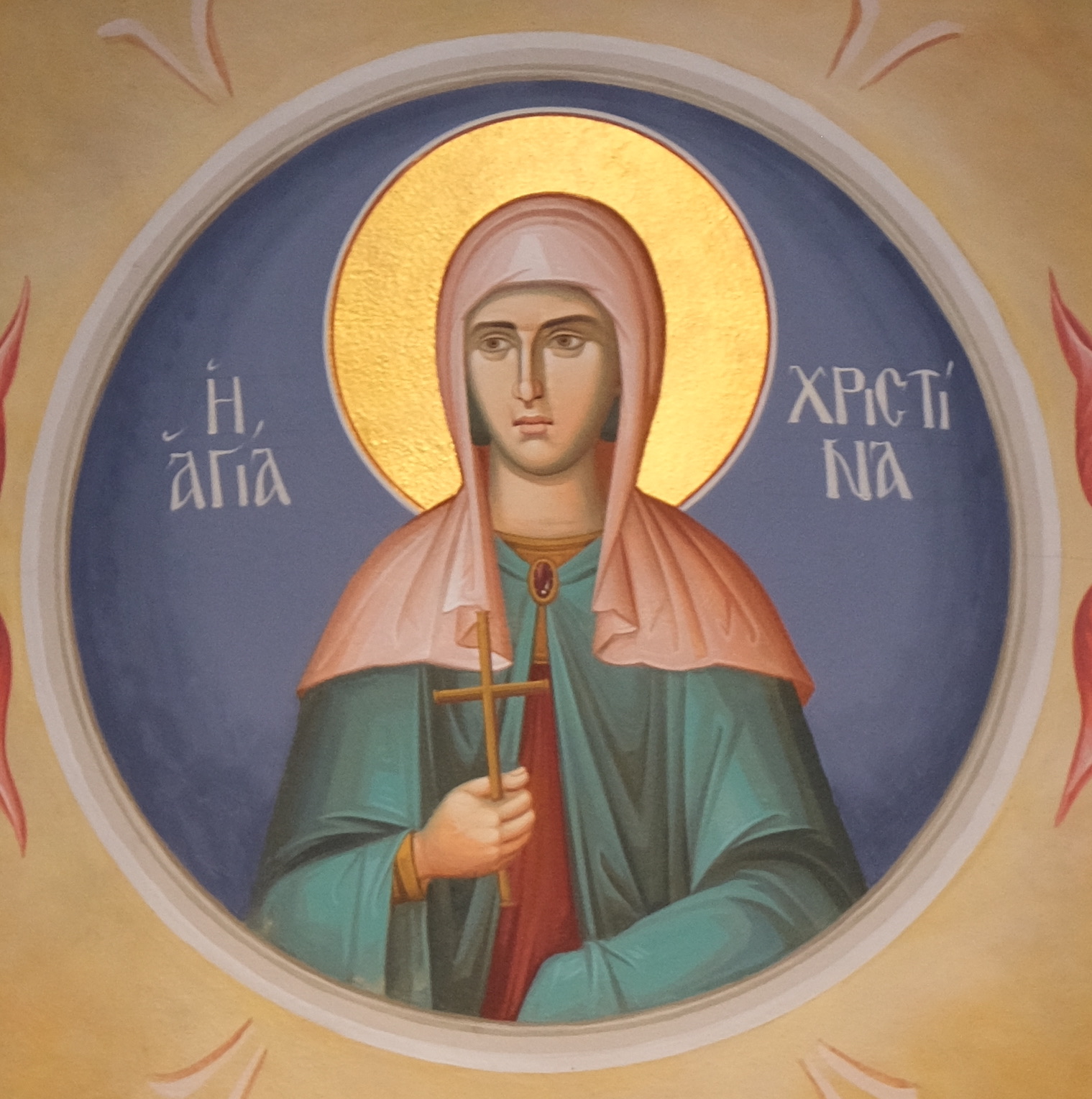
---
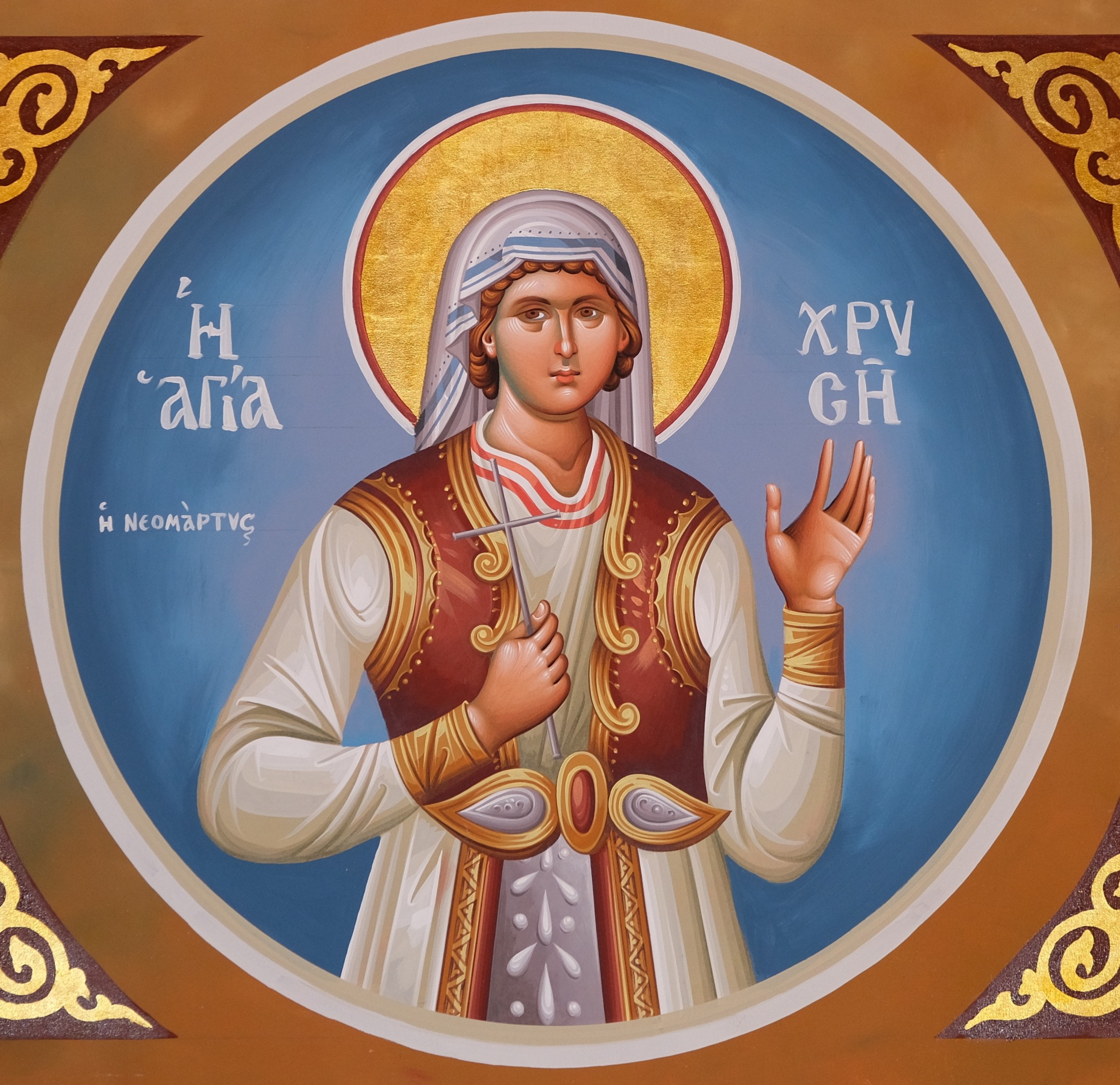
May 21
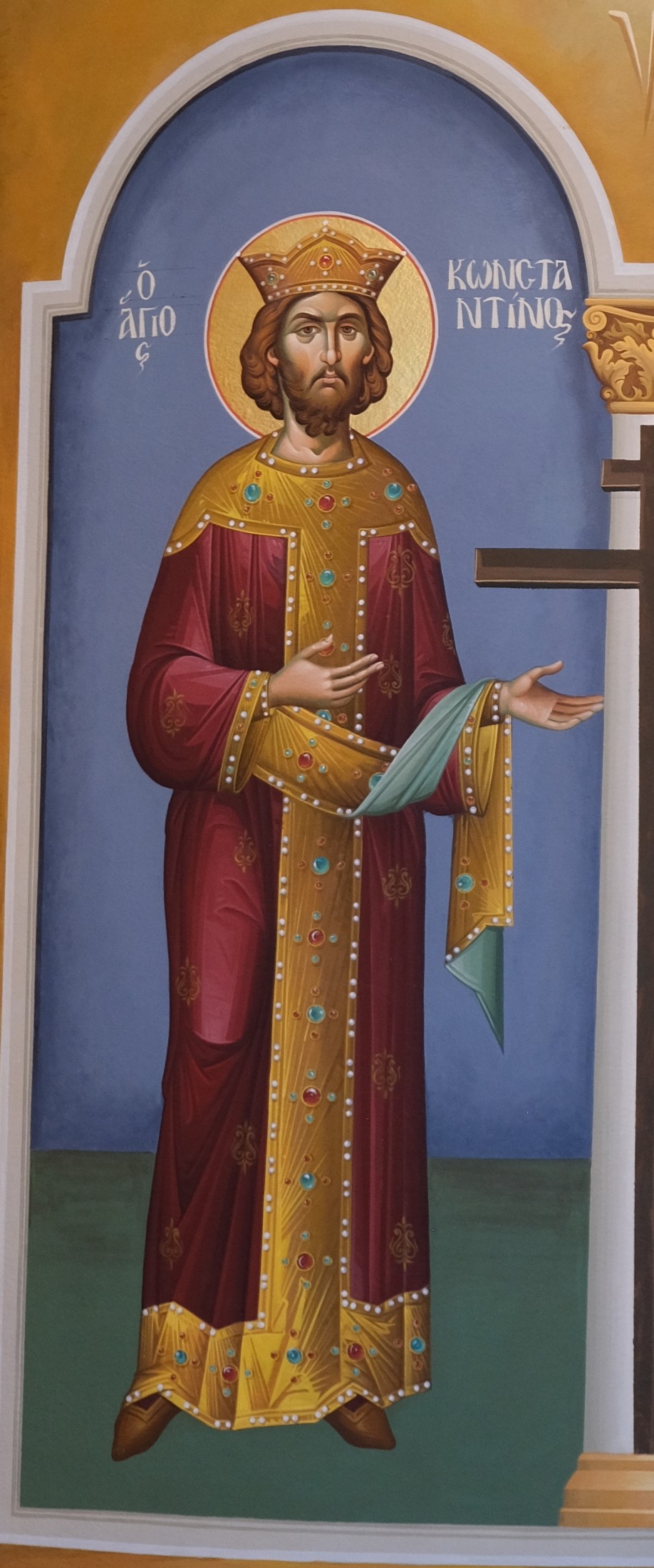
This great and renowned sovereign of the Christians was the son of Constantius Chlorus (the ruler of the westernmost parts of the Roman empire), and of the blessed Helen. He was born in 272, in (according to some authorities) Naissus of Dardania, a city on the Hellespont. In 306, when his father died, he was proclaimed successor to his throne. In 312, on learning that Maxentius and Maximinus had joined forces against him, he marched into Italy, where, while at the head of his troops, he saw in the sky after midday, beneath the sun, a radiant pillar in the form of a cross with the words: "By this shalt thou conquer." The following night, our Lord Jesus Christ appeared to him in a dream and declared to him the power of the Cross and its significance. When he arose in the morning, he immediately ordered that a labarum be made (which is a banner or standard of victory over the enemy) in the form of a cross, and he inscribed on it the Name of Jesus Christ. On the 28th Of October, he attacked and mightily conquered Maxentius, who drowned in the Tiber River while fleeing. The following day, Constantine entered Rome in triumph and was proclaimed Emperor of the West by the Senate, while Licinius, his brother-in-law, ruled in the East. But out of malice, Licinius later persecuted the Christians. Constantine fought him once and again, and utterly destroyed him in 324, and in this manner he became monarch over the West and the East. Under him and because of him all the persecutions against the Church ceased. Christianity triumphed and idolatry was overthrown. In 325 he gathered the First Ecumenical Council in Nicaea, which he himself personally addressed. In 324, in the ancient city of Byzantium, he laid the foundations of the new capital of his realm, and solemnly inaugurated it on May 11, 330, naming it after himself, Constantinople. Since the throne of the imperial rule was transferred thither from Rome, it was named New Rome, the inhabitants of its domain were called Romans, and it was considered the continuation of the Roman Empire. Falling ill near Nicomedia, he requested to receive divine Baptism, according to Eusebius (The Life of Constantine. Book IV, 61-62), and also according to Socrates and Sozomen; and when he had been deemed worthy of the Holy Mysteries, he reposed in 337, on May 21 or 22, the day of Pentecost, having lived sixty-five years, of which he ruled for thirty-one years. His remains were transferred to Constantinople and were deposed in the Church of the Holy Apostles, which had been built by him (see Homily XXVI on Second Corinthians by Saint John Chrysostom). Learn More
[Greek Orthodox Archdiocese of America - June 24]
November 1
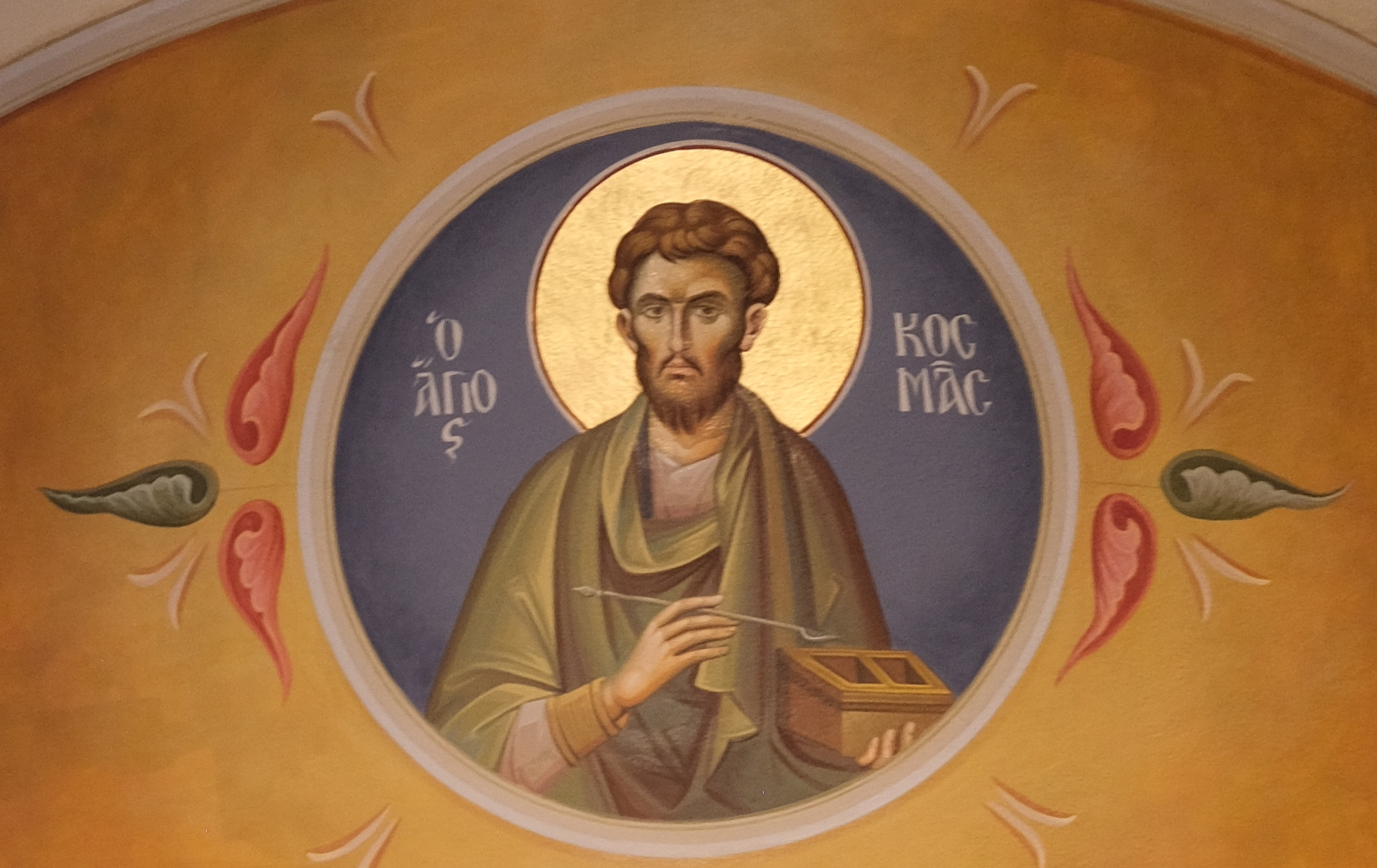
These Saints were from Asia (that is, Asia Minor). After the death of their father, their Christ-loving mother Theodota reared them in piety and in all manner of virtue, and had them instructed in every science, especially that of medicine. This became their vocation, and they went about healing every illness and malady, bestowing healing freely on both men and beasts alike; because of this, they are called "Unmercenaries." And thus, having completed the course of their life, they reposed in peace. Learn More
[Greek Orthodox Archdiocese of America - June 24]
January 18
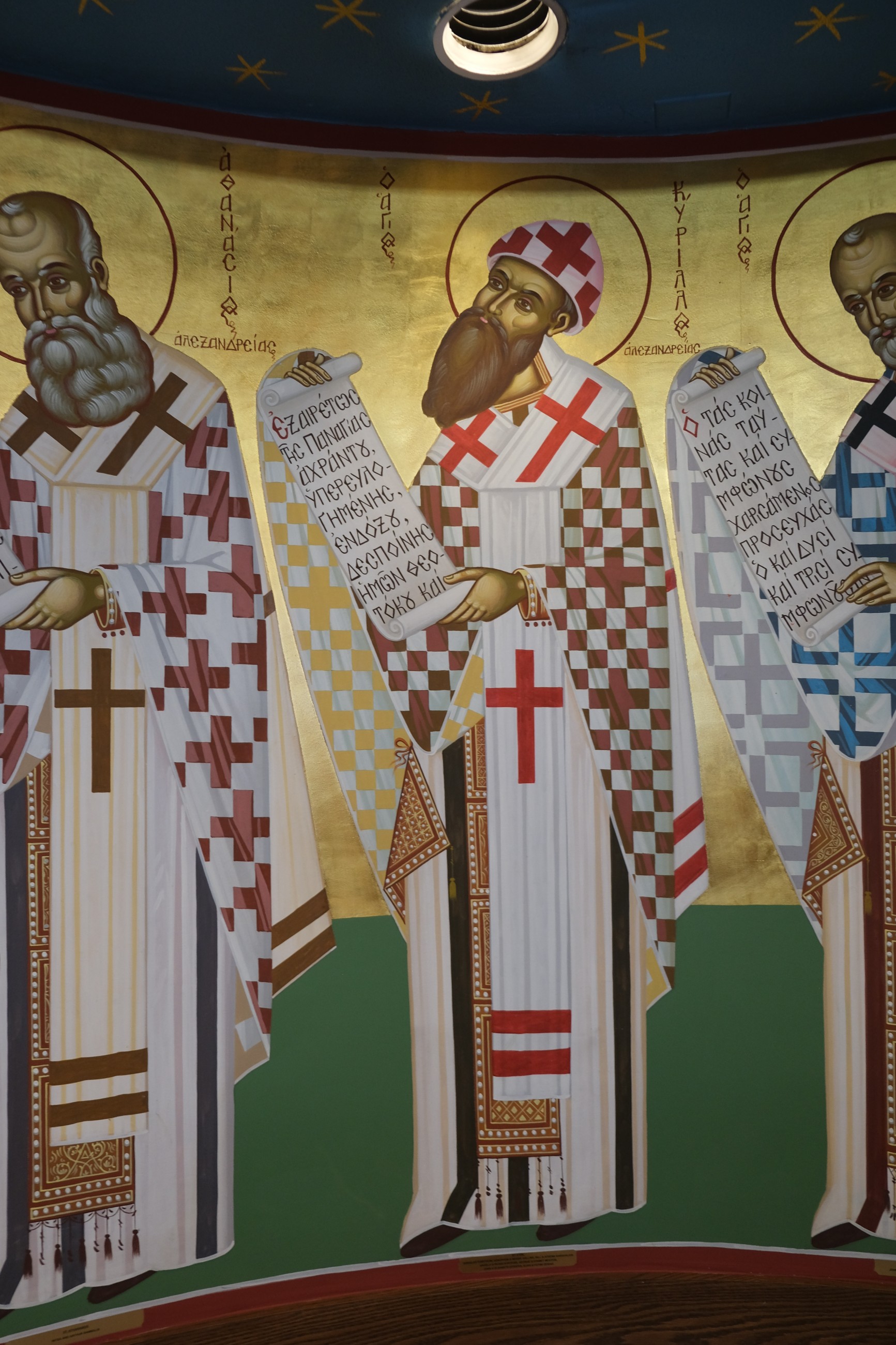
Saint Cyril was also from Alexandria, born about the year 376. He was the nephew of Theophilus, Patriarch of Alexandria, who also instructed the Saint in his youth. Having first spent much time with the monks in Nitria, he later became the successor to his uncle's throne in 412. In 429, when Cyril heard tidings of the teachings of the new Patriarch of Constantinople, Nestorius, he began attempting through private letters to bring Nestorius to renounce his heretical teaching about the Incarnation. When the heresiarch did not repent, Saint Cyril, together with Pope Celestine of Rome, led the Orthodox opposition to his error. Saint Cyril presided over the Third Ecumenical Council of the 200 Holy Fathers in the year 431, who gathered in Ephesus under Saint Theodosius the Younger. At this Council, by his most wise words, he put to shame and convicted the impious doctrine of Nestorius, who, although he was in town, refused to appear before Cyril. Saint Cyril, besides overthrowing the error of Nestorius, has left to the Church full commentaries on the Gospels of Luke and John. Having shepherded the Church of Christ for thirty-two years, he reposed in 444. Learn More
[Greek Orthodox Archdiocese of America - July 4]
November 1
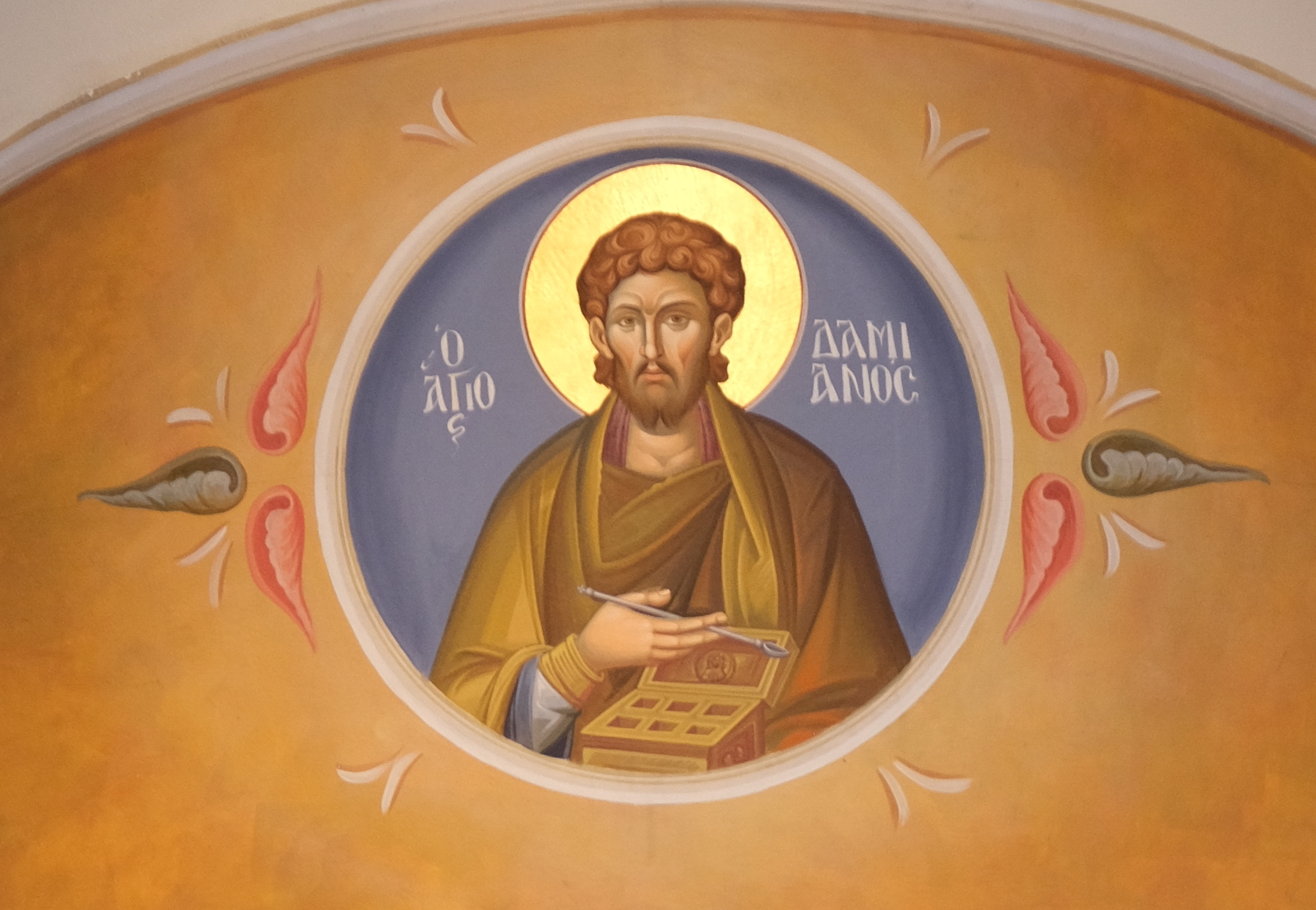
These Saints were from Asia (that is, Asia Minor). After the death of their father, their Christ-loving mother Theodota reared them in piety and in all manner of virtue, and had them instructed in every science, especially that of medicine. This became their vocation, and they went about healing every illness and malady, bestowing healing freely on both men and beasts alike; because of this, they are called "Unmercenaries." And thus, having completed the course of their life, they reposed in peace. Learn More
[Greek Orthodox Archdiocese of America - June 24]
October 10
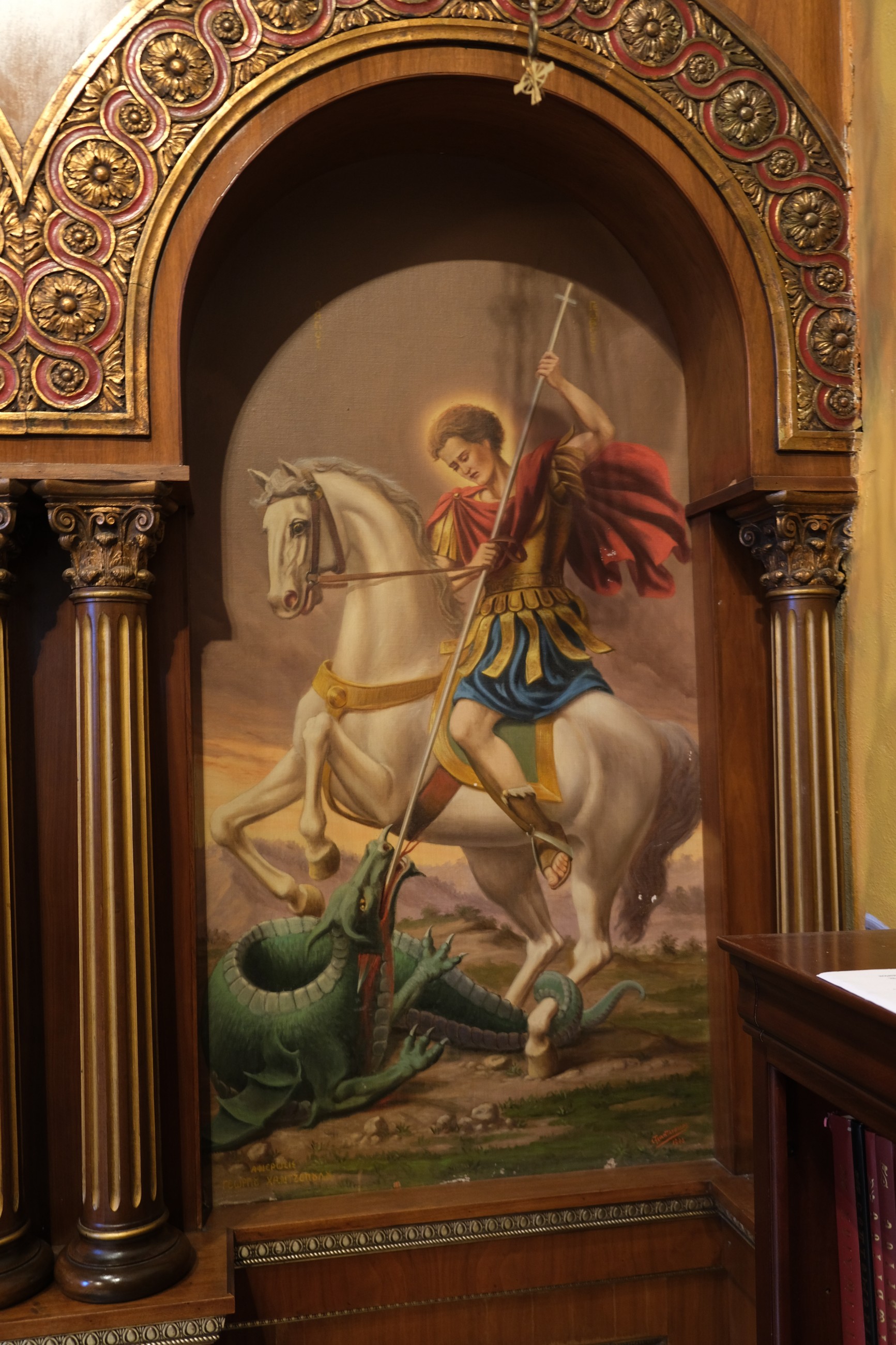
Saint Demetrius was a Thessalonian, a most pious son of pious and noble parents, and a teacher of the Faith of Christ. When Maximian first came to Thessalonica in 290, he raised the Saint to the rank of Duke of Thessaly. But when it was discovered that the Saint was a Christian, he was arrested and kept bound in a bath-house. While the games were under way in the city, Maximian was a spectator there. A certain friend of his, a barbarian who was a notable wrestler, Lyaeus by name, waxing haughty because of the height and strength of his body, boasted in the stadium and challenged the citizens to a contest with him. All that fought with him were defeated. Seeing this, a certain youth named Nestor, aquaintance of Demetrius', came to the Saint in the bath-house and asked his blessing to fight Lyaeus single-handed. Receiving this blessing and sealing himself with the sign of the precious Cross, he presented himself in the stadium, and said, "O God of Demetrius, help me!" and straightway he engaged Lyaeus in combat and smote him with a mortal blow to the heart, leaving the former boaster lifeless upon the earth. Maximian was sorely grieved over this, and when he learned who was the cause of this defeat, he commanded straightway and Demetrius was pierced with lances while he was yet in the bath-house, As for Nestor, Maximian commanded that he be slain with his own sword. Learn More
[Greek Orthodox Archdiocese of America - June 24]
December 17
.
The holy hierarch, Saint Dionysius, who was born and reared on Zakynthos, was the son of pious and wealthy parents, Mocius and Paulina by name. In his youth he entered the ancient monastery of the Strophada Islands, which lie south of Zakynthos, and there he donned the monastic habit. Later, he was appointed Archbishop of Aegina, and adorned its throne for a considerable time. Thereafter he returned to his homeland. One incident in his life especially reveals to what virtue he attained. A man came to him in desperation, witnessing that he had committed a murder, and was being pursued by the slain man's family. He asked Saint Dionysius to give him refuge. The Saint agreed to this, upon learning that it was his own brother whom the man had slain, he said nothing, but concealing the agony of his grief, hid him. When the Saint's kinsmen arrived at the monastery, he told them that the Murderer had gone by such and such a way. When they had departed, he admonished the man concerning the gravity of his sin, instructed him in repentance, and sent him off in peace having forgiven him his brother's murder. According to local tradition, this man later returned and became a monk at this same monastery. Saint Dionysius reposed in peace in 1621, leaving behind his sacred and incorrupt relics as a treasure for his fellow citizens. Learn More
[Greek Orthodox Archdiocese of America - June 24]
December 15
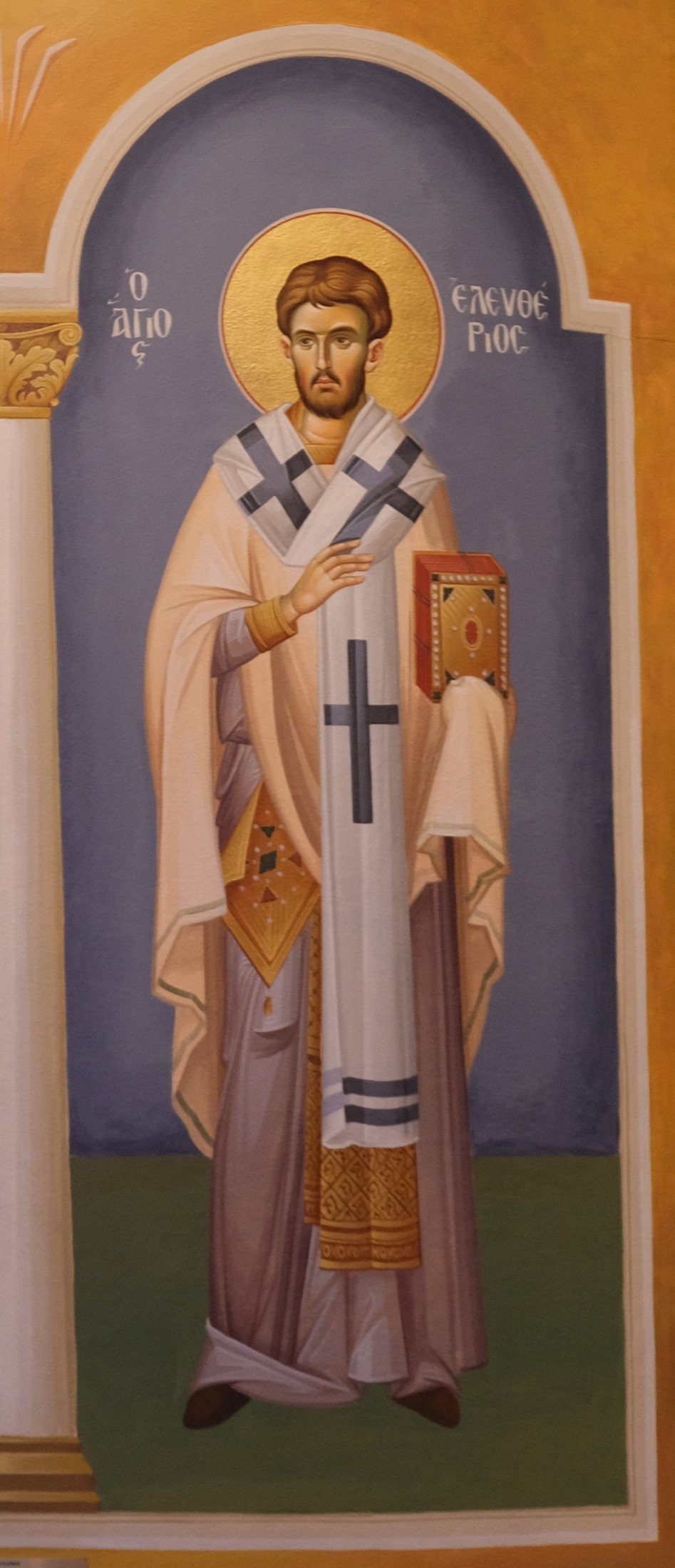
This Saint had Rome as his homeland. Having been orphaned of his father from childhood, he was taken by his mother Anthia to Anicetus, the Bishop of Rome (some call him Anencletus, or Anacletus), by whom he was instructed in the sacred letters (that is, the divine Scriptures). Though still very young in years, he was made Bishop of Illyricum by reason of his surpassing virtue, and by his teachings he converted many unbelievers to Christ. However, during a most harsh persecution that was raised against the Christians under Hadrian (reigned 117-138), the Saint was arrested by the tyrants. Enduring many torments for Christ, he was finally put to death by two soldiers about the year 126. As for his Christ-loving mother Anthia, while embracing the remains of her son and kissing them with maternal affection, she was also beheaded. Learn More
[Greek Orthodox Archdiocese of America - July 5]
July 20
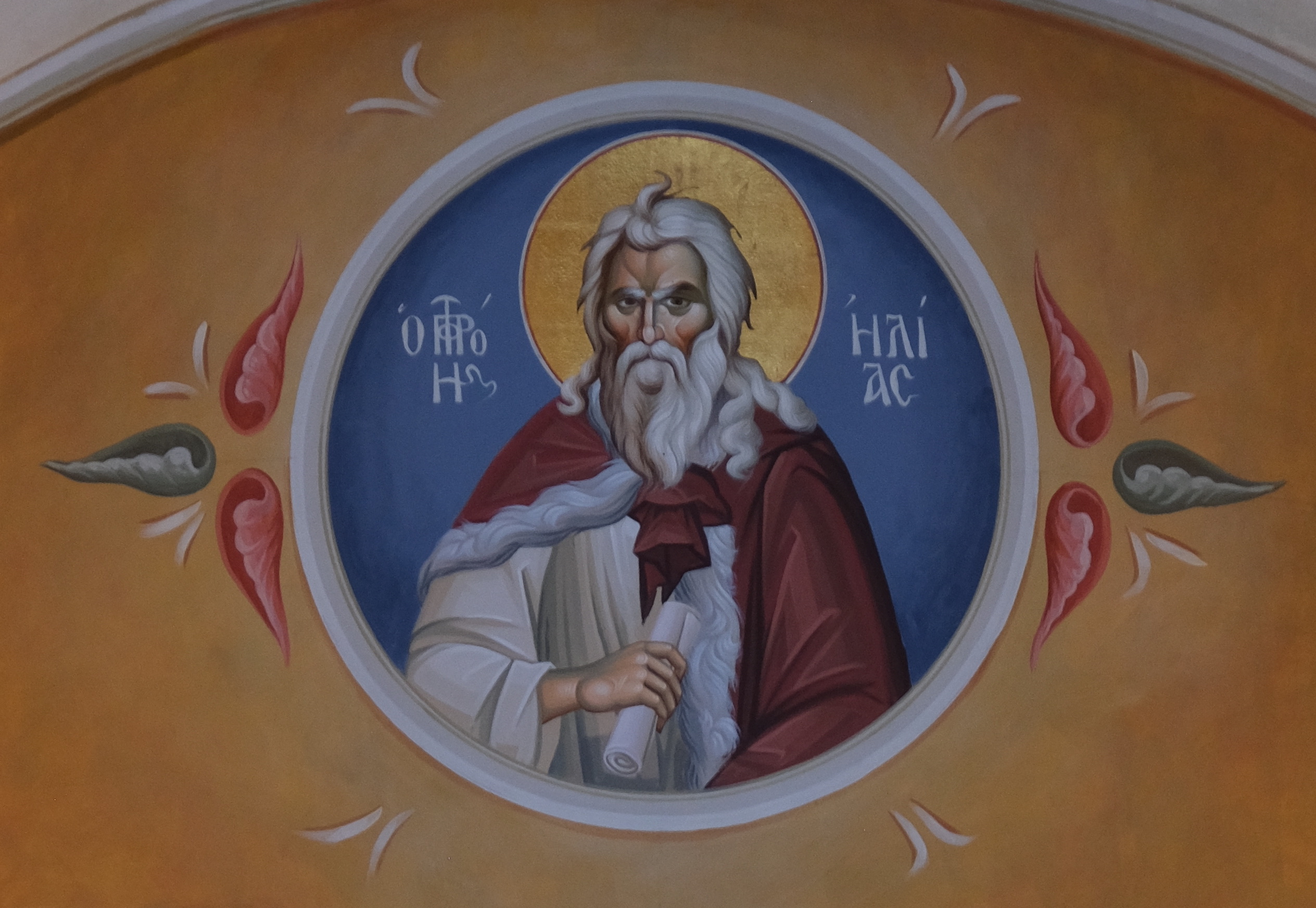
Elias of great fame was from Thisbe or Thesbe, a town of Galaad (Gilead), beyond the Jordan. He was of priestly lineage, a man of a solitary and ascetical character, clothed in a mantle of sheep skin, and girded about his loins with a leathern belt. His name is interpreted as "Yah is my God." His zeal for the glory of God was compared to fire, and his speech for teaching and rebuke was likened unto a burning lamp. From this too he received the name Zealot. Therefore, set aflame with such zeal, he sternly reproved the impiety and lawlessness of Ahab and his wife Jezebel. He shut up heaven by means of prayer, and it did not rain for three years and six months. Ravens brought him food for his need when, at God's command, he was hiding by the torrent of Horrath. He multiplied the little flour and oil of the poor widow of Sarephtha of Sidon, who had given him hospitality in her home, and when her son died, he raised him up. He brought down fire from Heaven upon Mount Carmel, and it burned up the sacrifice offered to God before all the people of Israel, that they might know the truth. At the torrent of Kisson, he slew 450 false prophets and priests who worshipped idols and led the people astray. He received food wondrously at the hand of an Angel, and being strengthened by this food he walked for forty days and forty nights. He beheld God on Mount Horeb, as far as this is possible for human nature. He foretold the destruction of the house of Ahab, and the death of his son Ohozias; and as for the two captains of fifty that were sent by the king, he burned them for their punishment, bringing fire down from Heaven. He divided the flow of the Jordan, and he and his disciple Elisseus passed through as it were on dry land; and finally, while speaking with him, Elias was suddenly snatched away by a fiery chariot in the year 895 B.C., and he ascended as though into heaven, whither God most certainly translated him alive, as He did Enoch (Gen. 5:24; IV Kings 2: 11). But from thence also, after seven years, by means of an epistle he reproached Joram, the son of Josaphat, as it is written: "And there came a message in writing to him from Elias the Prophet, saying, Thus saith the Lord God of David thy father, Because thou hast not walked in the way," and so forth (II Chron. 21:12). According to the opinion of the majority of the interpreters, this came to pass either through his disciple Elisseus, or through another Prophet when Elias appeared to them, even as he appeared on Mount Tabor to the disciples of Christ (see Aug. 6). Learn More
[Greek Orthodox Archdiocese of America - June 24]
July 11 & September 9
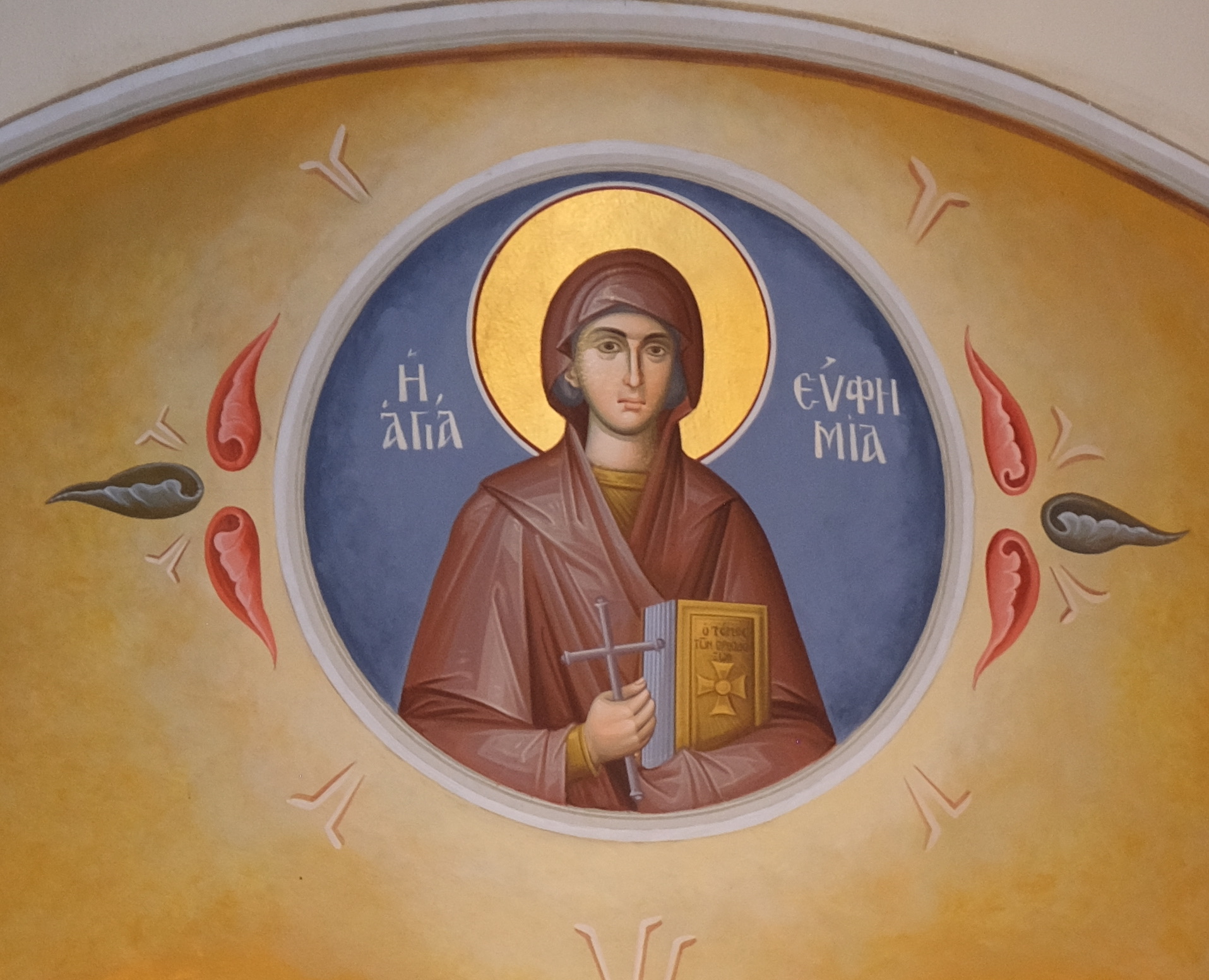
Saint Euphemia was from Chalcedon and lived in virginity. According to some, she suffered martyrdom during the reign of Diocletian, in 303; according to others, in 307. Her sacred relics are preserved in the Patriarchate in Constantinople. In 451, during the reign of the Sovereigns Marcian and Pulcheria, the Fourth Ecumenical Council was convoked in Chalcedon against Eutyches and those of like mind with him. After much debate, the Fathers who were the defenders of Orthodoxy, being 630 in number, agreed among themselves and with those who were of contrary mind, to write their respective definitions of faith in separate books, and to ask God to confirm the truth in this matter. When they had prepared these texts, they placed the two tomes in the case that held Saint Euphemia's relics, sealed it, and departed. After three days of night-long supplications, they opened the reliquary in the presence of the Emperor, and found the tome of the heretics under the feet of the Martyr, and that of the Orthodox in her right hand. Learn More (July 11) and Learn More (September 9)
[Greek Orthodox Archdiocese of America - July 5]
---
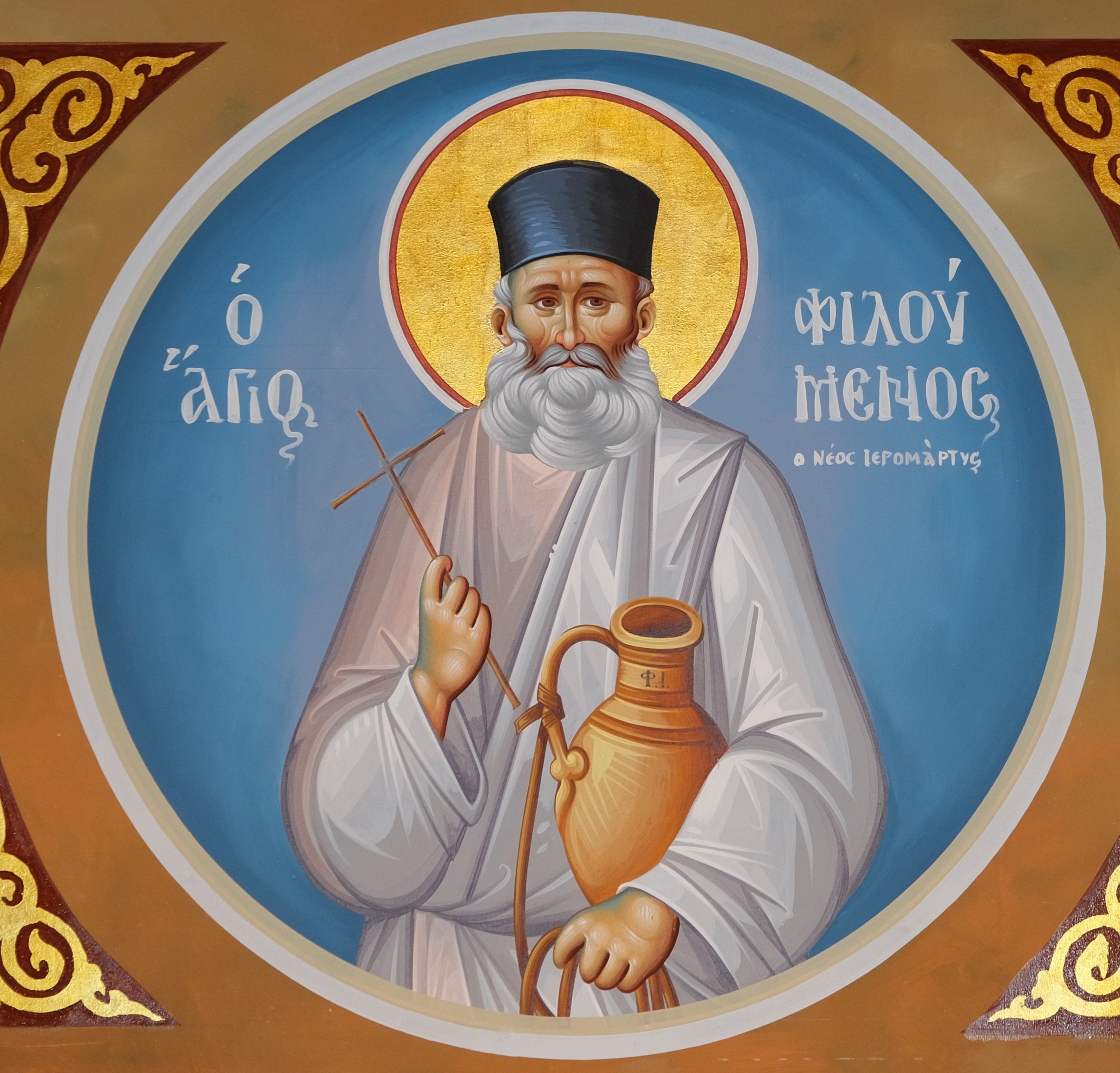
March 20
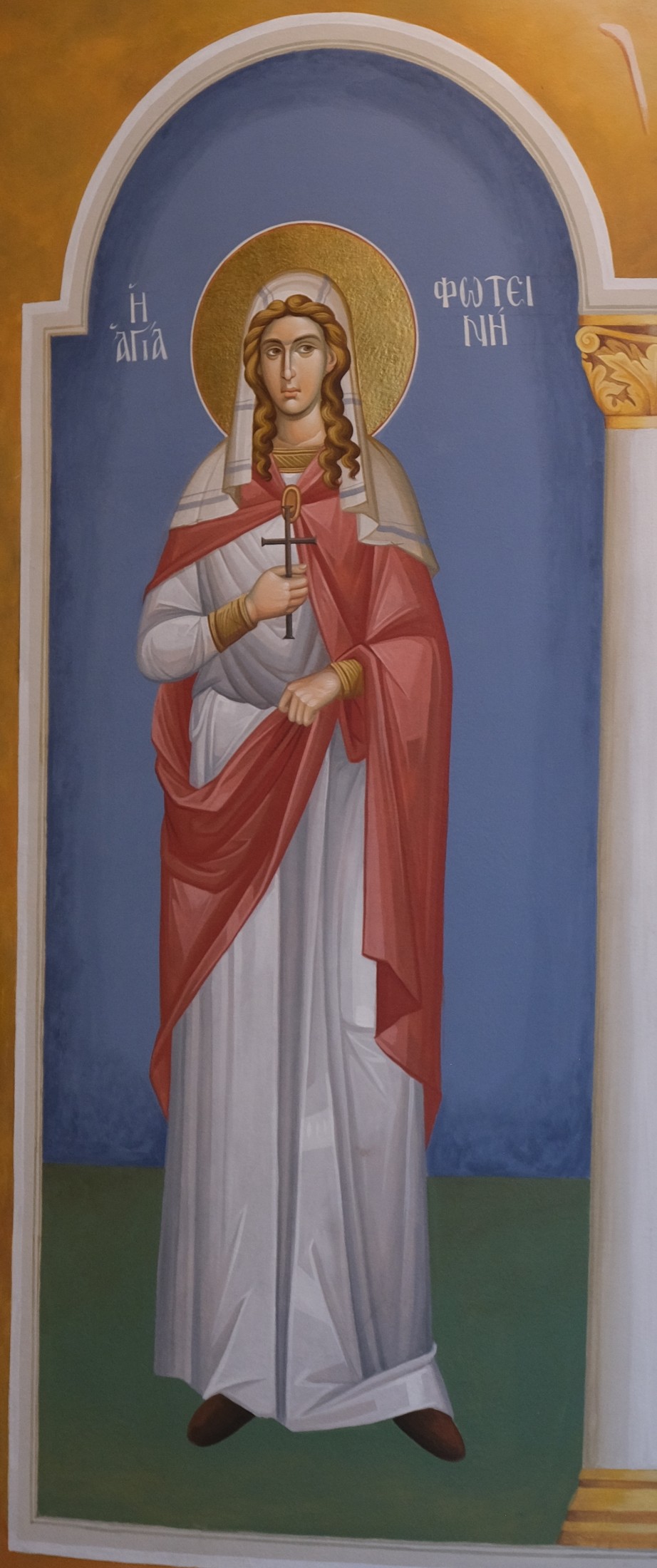
Saint Photini lived in 1st century Palestine and was the woman that Christ met at Jacob's Well in Samaria as recorded in the Gospel according to John (4:4-26). After her encounter with Christ, she and her whole family were baptized by the Apostles and became evangelists of the early Church. Photini and her children eventually were summoned before the emperor Nero and instructed to renounce their faith in Christ. They refused to do so, accepting rather to suffer various tortures. After many efforts to force her to surrender to idolatry, the emperor ordered that she be thrown down a well. Photini gave up her life in the year 66. Learn More
[Greek Orthodox Archdiocese of America - July 5]
March 26 & November 8
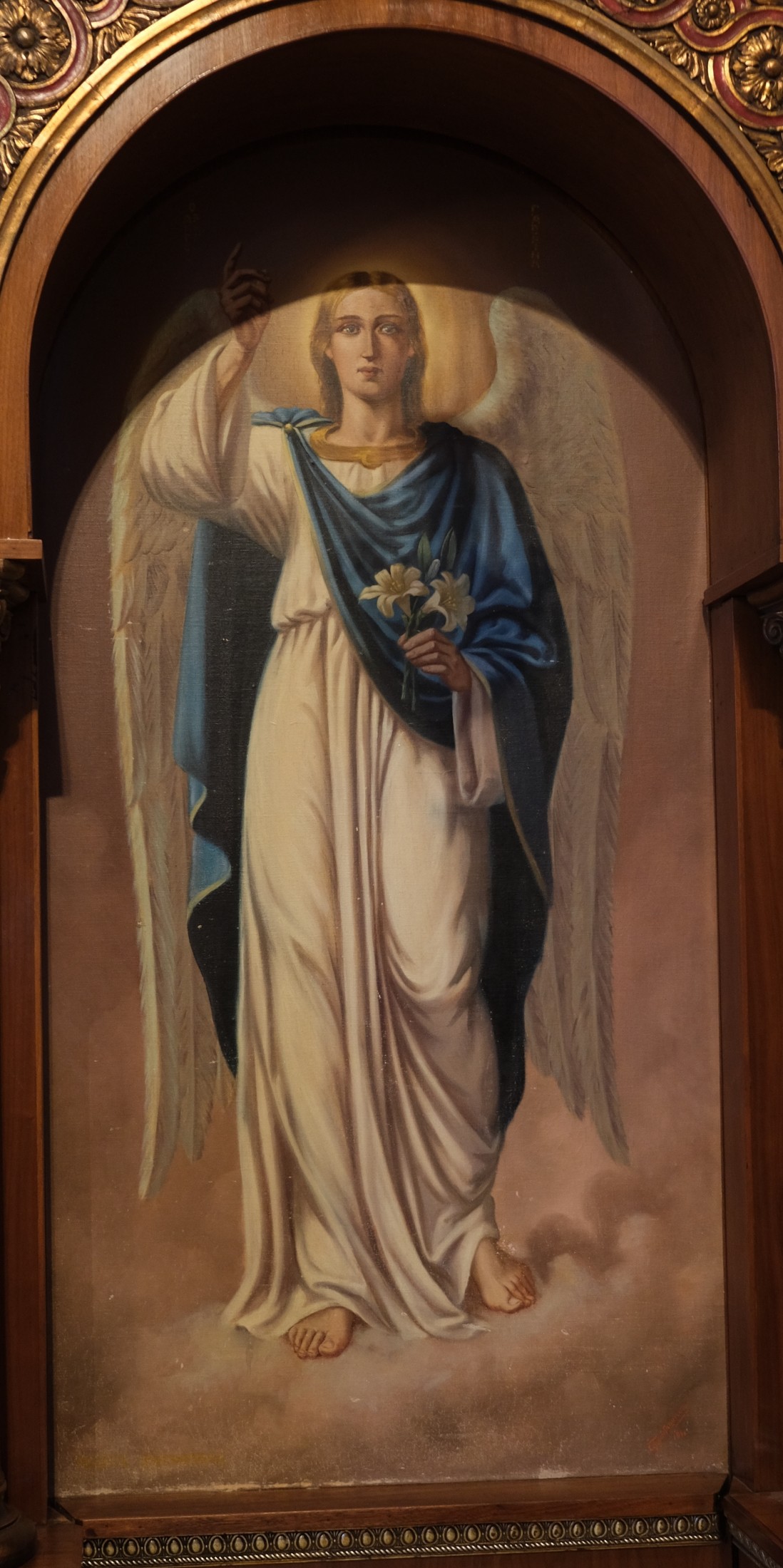
All the Angels, according to the Apostle Paul, are ministering spirits, - sent forth to minister to them who shall be heirs of salvation - (Heb. 1:14). God set them as overseers of every nation and people, and guides to that which is profitable (Deut. 32:8); and while one Angel is appointed to oversee each nation as a whole, one is also appointed to protect each Christian individually. He commands them to guard them that hope on Him, that nothing should harm them, neither should any evil draw nigh to their dwelling (Ps. 90:10-12). In the Heavens they always behold the face of God, sending up to Him the thrice-holy hymn and interceding with Him in our behalf, seeing they rejoice over one sinner that repents (Esaias 6:2-3; Matt. 18:10; Luke 15:7). In a word, they have served God in so many ways for our benefit, that the pages of Holy Scripture are filled with the histories thereof. It is for these reasons that the Orthodox Catholic Church, wisely honouring these divine ministers, our protectors and guardians, celebrates today the present Synaxis that is, our coming together in assembly for their common feast to chant their praises, especially for the Archangels Michael and Gabriel, who are mentioned in the Scriptures by name. The name Michael means "Who is like God?" and Gabriel means "God is mighty." The number of Angels is not defined in the divine Scriptures, where Daniel says that thousands of thousands ministered before Him, and ten thousands of ten thousands attended upon Him -(Dan. 7:10). But all of them are divided into nine orders which are called Thrones, Cherubim, Seraphim, Dominions, Powers, Authorities, Principalities, Archangels, and Angels. Learn More
[Greek Orthodox Archdiocese of America - June 24]
April 23
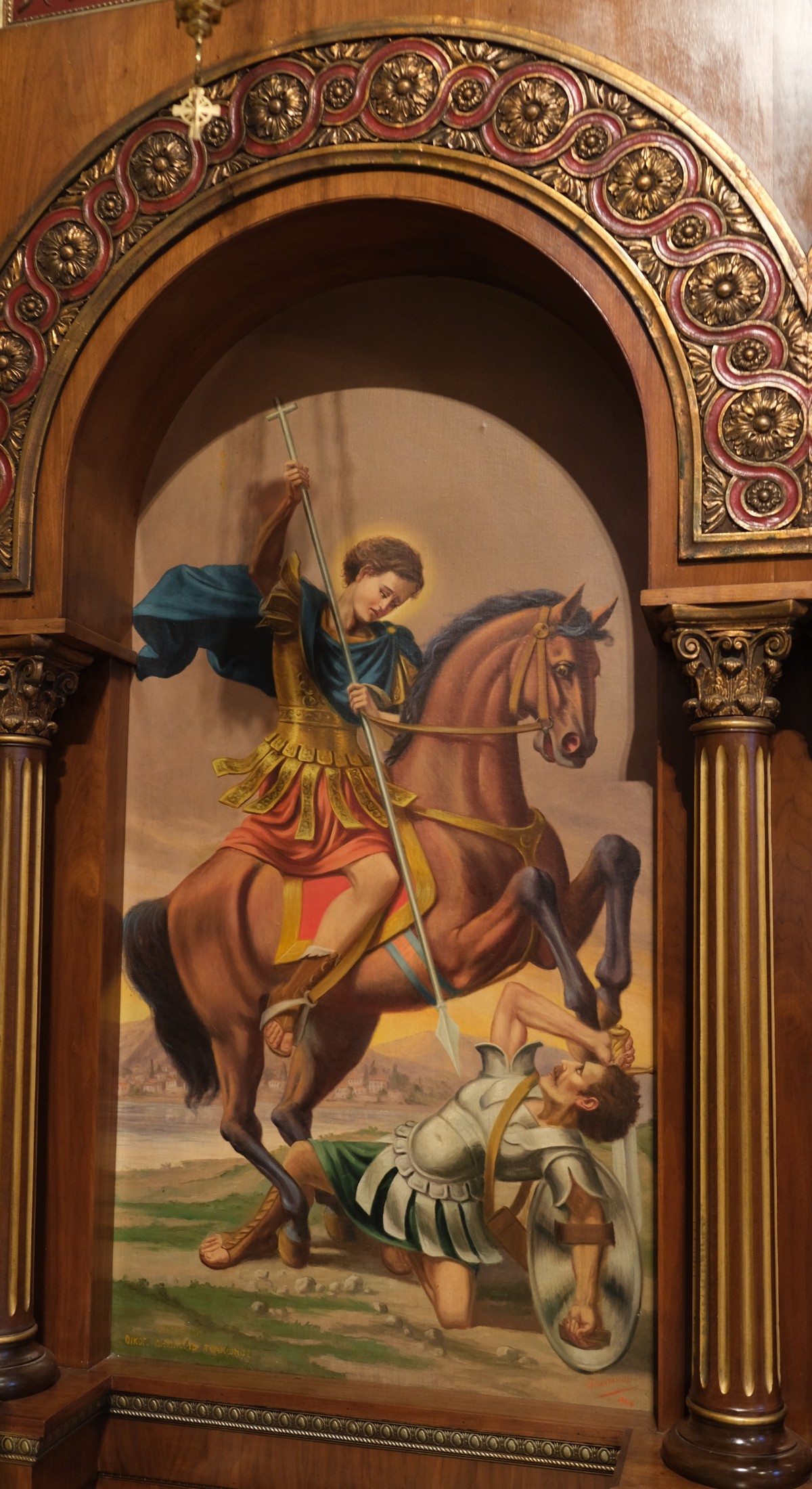
George, this truly great and glorious Martyr of Christ, was born of a father from Cappadocia and a mother from Palestine. Being a military tribune, or chiliarch (that is, a commander of a thousand troops), he was illustrious in battle and highly honoured for his courage. When he learned that the Emperor Diocletian was preparing a persecution of the Christians, Saint George presented himself publicly before the Emperor and denounced him. When threats and promises could not move him from his steadfast confession, he was put to unheard-of tortures, which he endured with great bravery, overcoming them by his faith and love towards Christ. By the wondrous signs that took place in his contest, he guided many to the knowledge of the truth, including Queen Alexandra, wife of Diocletian, and was finally beheaded in 296 in Nicomedia. Learn More
[Greek Orthodox Archdiocese of America - June 24]
November 14
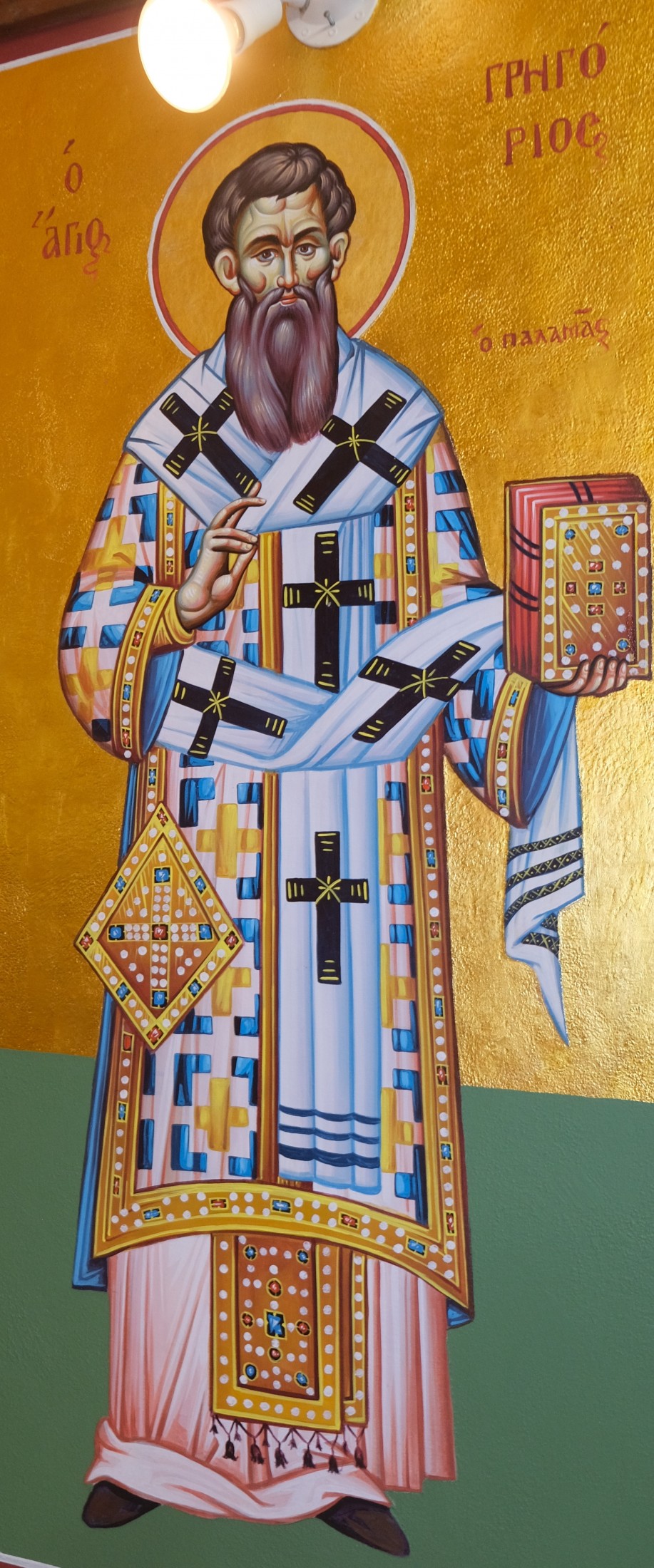
This divine Father, who was from Asia Minor, was from childhood reared in the royal court of Constantinople, where he was instructed in both religious and secular wisdom. Later, while still a youth, he left the imperial court and struggled in asceticism on Mount Athos, and in the Skete at Beroea. He spent some time in Thessalonica being treated for an illness that came from his harsh manner of life. He was present in Constantinople at the Council that was convened in 1341 against Barlaam of Calabria, and at the Council of 1347 against Acindynus, who was of like mind with Barlaam; Barlaam and Acindynus claimed that the grace of God is created. At both these Councils, the Saint contended courageously for the true dogmas of the Church of Christ, teaching in particular that divine grace is not created, but is the uncreated energies of God which are poured forth throughout creation: otherwise it would be impossible, if grace were created, for man to have genuine communion with the uncreated God. In 1347 he was appointed Metropolitan of Thessalonica. He tended his flock in an apostolic manner for some twelve years, and wrote many books and treatises on the most exalted doctrines of our Faith; and having lived for a total of sixty-three years, he reposed in the Lord in 1359. Learn More
[Greek Orthodox Archdiocese of America - June 24]
January 25
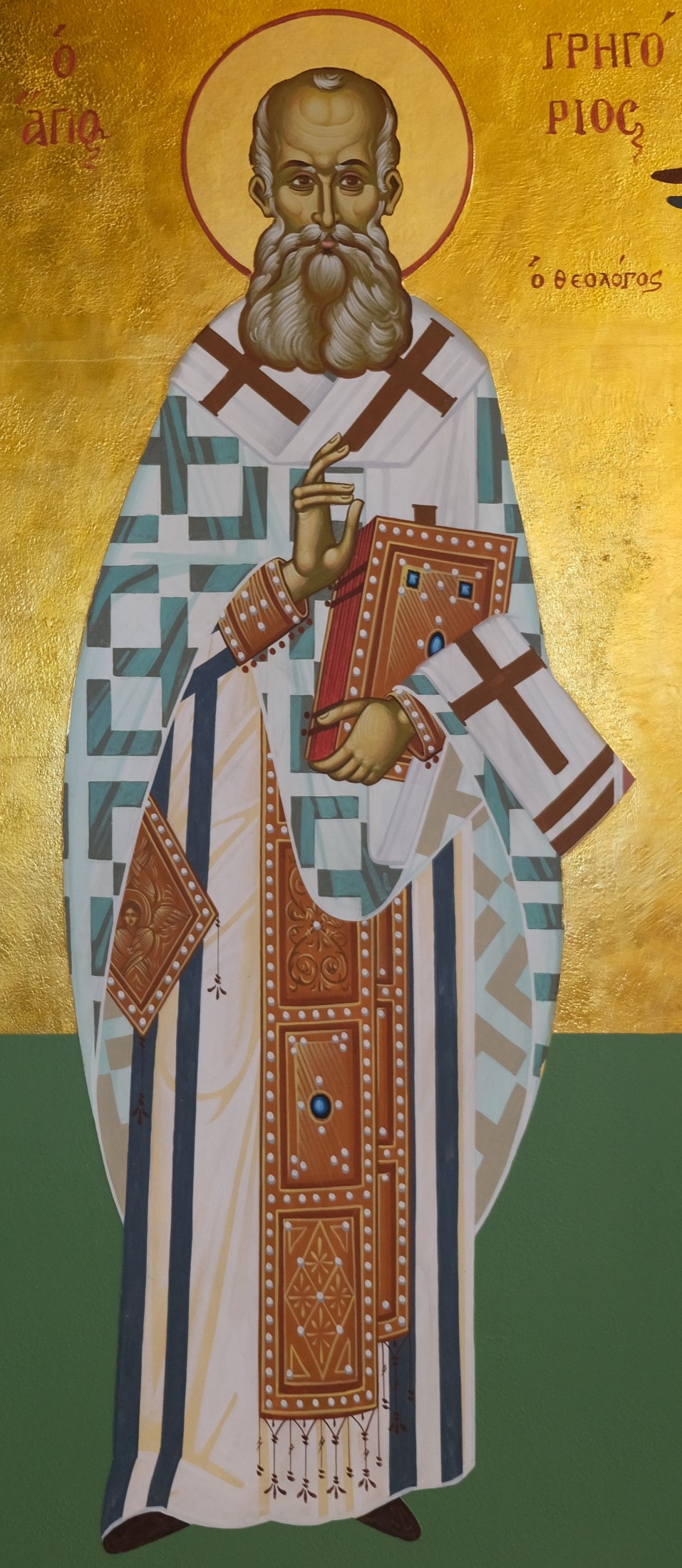
This great Father and Teacher of the Church was born in 329 in Arianzus, a village of the second district of Cappadocia, not far from Nazianzus. His father, who later became Bishop of Nazianzus, was named Gregory (commemorated Jan. 1), and his mother was named Nonna (Aug. 5); both are among the Saints, and so are his brother Caesarius (Mar. 9) and his sister Gorgona (Feb. 23). At first he studied in Caesarea of Palestine, then in Alexandria, and finally in Athens. As he was sailing from Alexandria to Athens, a violent sea storm put in peril not only his life but also his salvation, since he had not yet been baptized. With tears and fervour he besought God to spare him, vowing to dedicate his whole self to Him, and the tempest gave way to calm. At Athens Saint Gregory was later joined by Saint Basil the Great, whom he already knew; but now their acquaintanceship grew into a lifelong brotherly love. Another fellow student of theirs in Athens was the young Prince Julian, who later as Emperor was called the Apostate because he denied Christ and did all in his power to restore paganism. Even in Athens, before Julian had thrown off the mask of piety; Saint Gregory saw what an unsettled mind he had, and said, "What an evil the Roman State is nourishing" (Orat. V, 24, PG 35:693). Learn More
[Greek Orthodox Archdiocese of America - July 4]
May 12
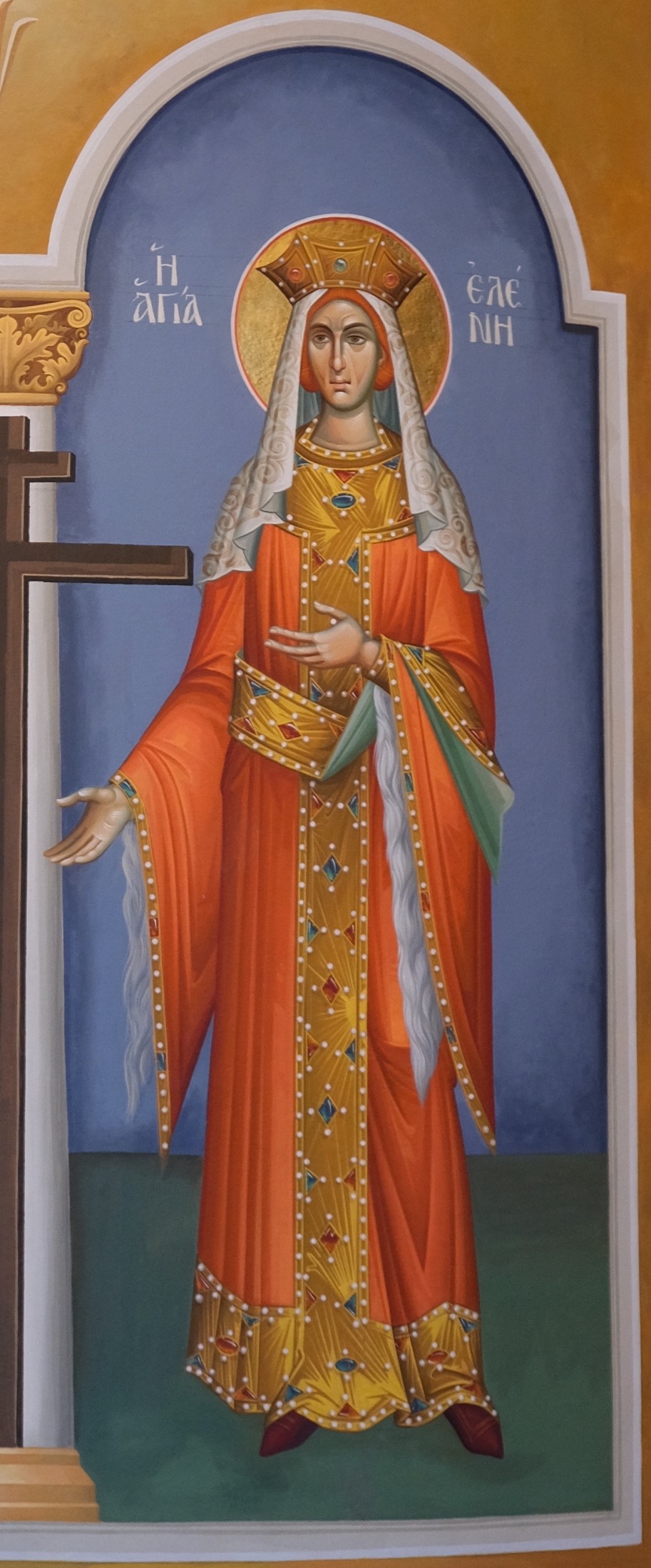
As for his holy mother Helen, after her son had made the Faith of Christ triumphant throughout the Roman Empire, she undertook a journey to Jerusalem and found the Holy Cross on which our Lord was crucified (see Sept. 13 and 14). After this, Saint Helen, in her zeal to glorify Christ, erected churches in Jerusalem at the sites of the Crucifixion and Resurrection, in Bethlehem at the cave where our Saviour was born, another on the Mount of Olives whence He ascended into Heaven, and many others throughout the Holy Land, Cyprus, and elsewhere. She was proclaimed Augusta, her image was stamped upon golden coins, and two cities were named Helenopolis after her in Bithynia and in Palestine. Having been thus glorified for her piety, she departed to the Lord being about eighty years of age, according to some in the year 330, according to others, in 336. Learn More
[Greek Orthodox Archdiocese of America - June 24]
---
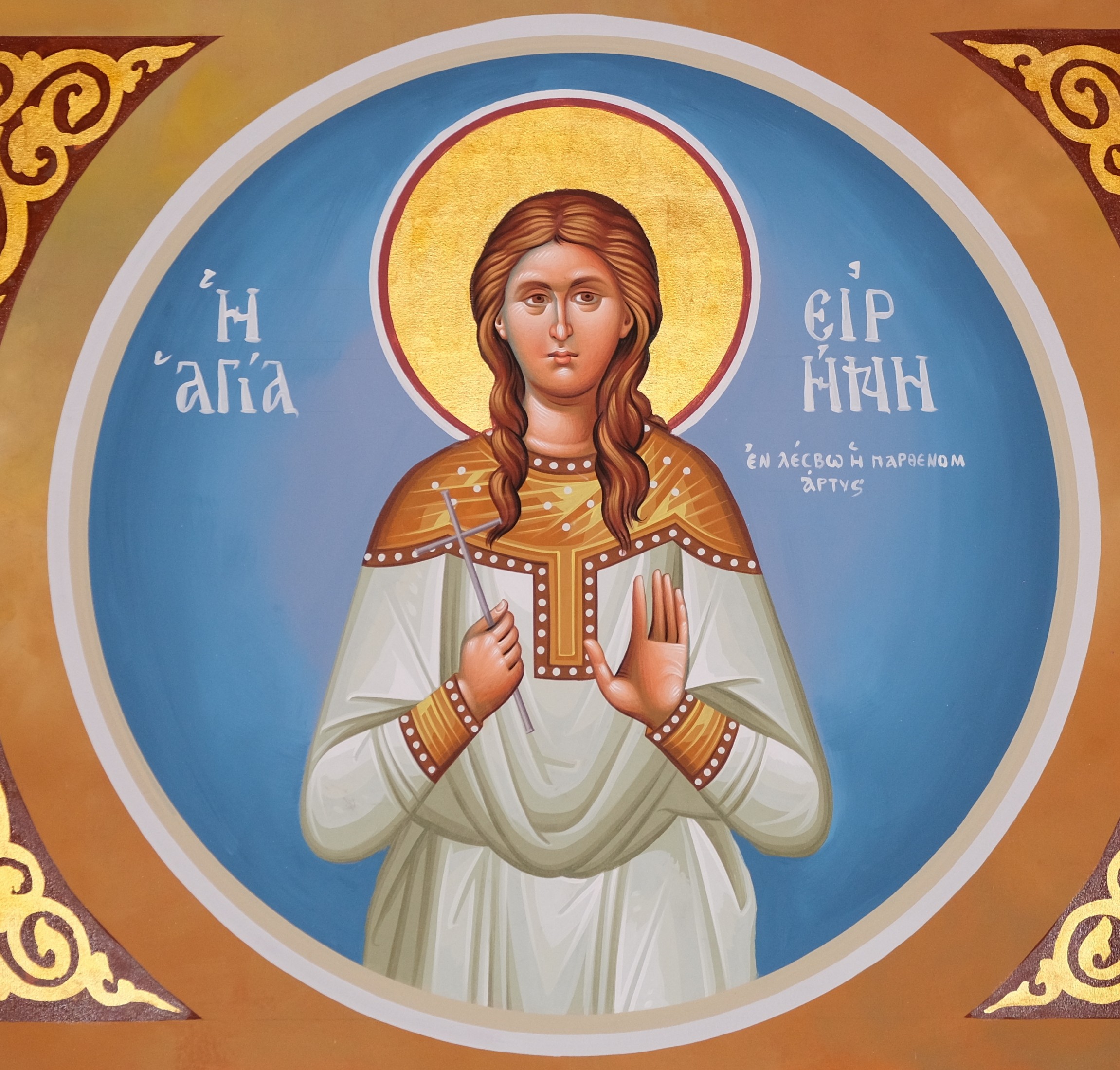
May 5
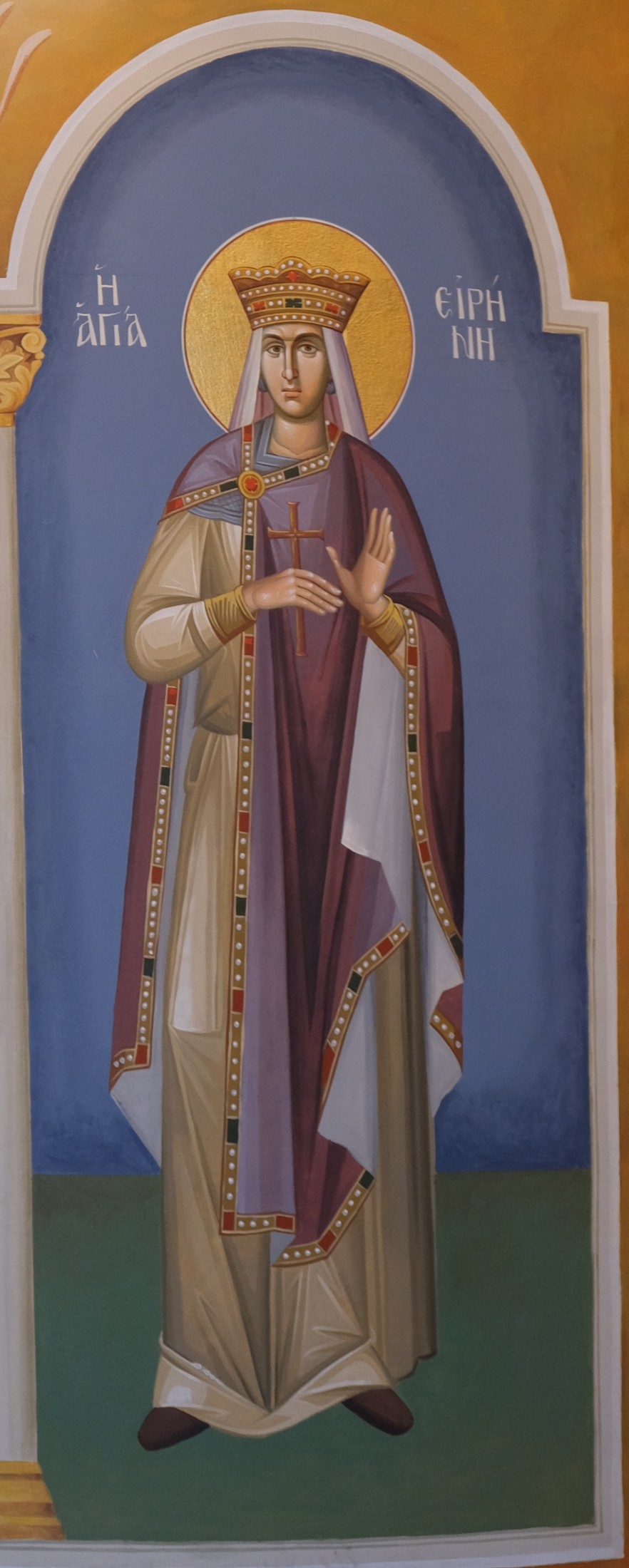
Saint Irene was the daughter of a princelet called Licinius; named Penelope by her parents, through a divine revelation she was brought to faith in Christ and at Baptism was renamed Irene. In her zeal for piety she broke in pieces all the idols of her father, who commanded that she be trampled underfoot by horses. But while she remained unharmed, one of the horses rose up and cast down her father, killing him. By her prayer she raised him to life again, and he believed and was baptized. Afterwards, in many journeyings, Saint Irene suffered torments and punishments for her faith, but was preserved by the power of God, while working dread miracles and converting many thousands of souls. At last she came to Ephesus, where she fell asleep in peace, in the first half of the fourth century. Two days after her death, her gravestone was found lifted off, and her grave empty. At least two churches were dedicated to Saint Irene in Constantinople, and she is also the patroness of the Aegean island of Thera, which is commonly called Santorin (or Santorini), a corruption of "Saint Irene." Learn More
[Greek Orthodox Archdiocese of America - July 5]
September 9
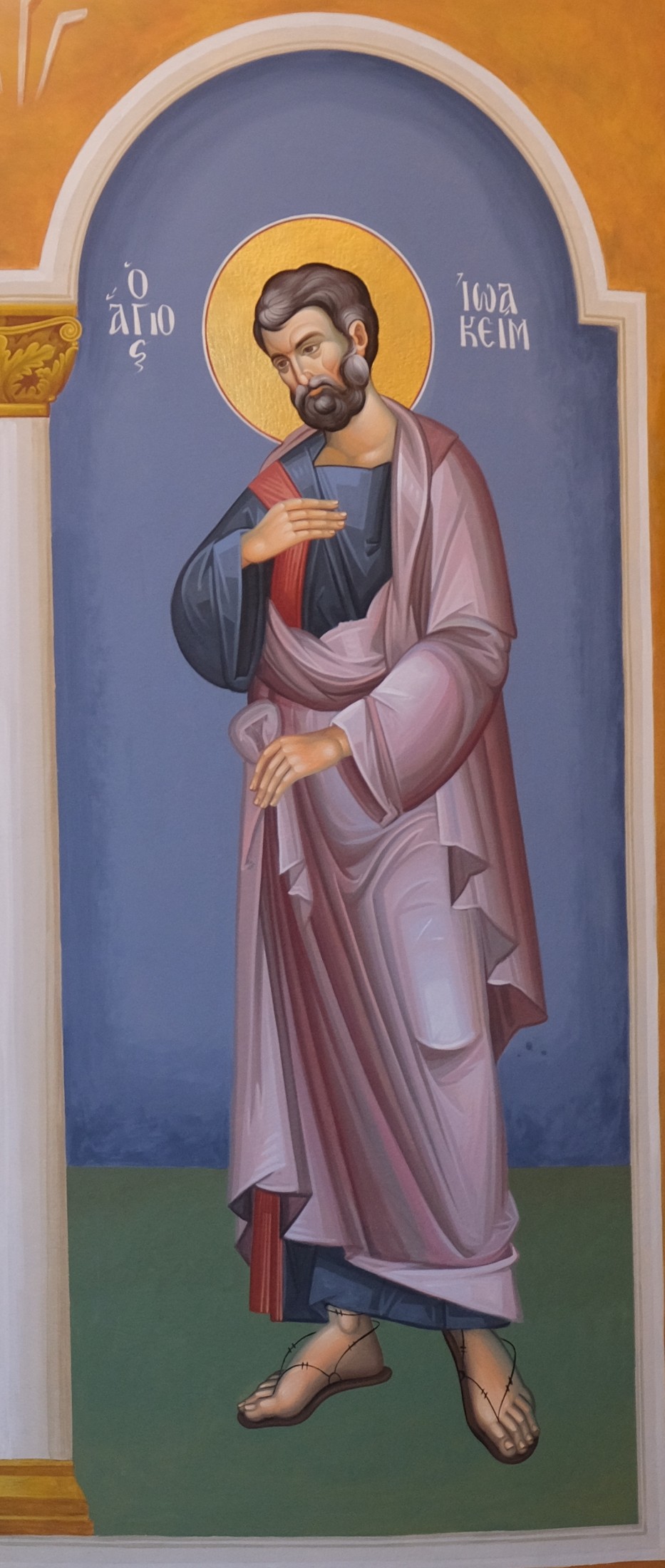
According to tradition, Anna, the ancestor of God, lived for sixty-nine years, and her spouse Joachim, for eighty; according to one account, Saint Joachim died two years before Saint Anna. The Theotokos had been orphaned of both her parents already when she was eleven years of age, when she was living in the Temple (see Sept. 8 and Nov. 21). Saint Anna is invoked for conceiving children, and for help in difficult childbirth. Learn More
[Greek Orthodox Archdiocese of America - July 5]
November 11
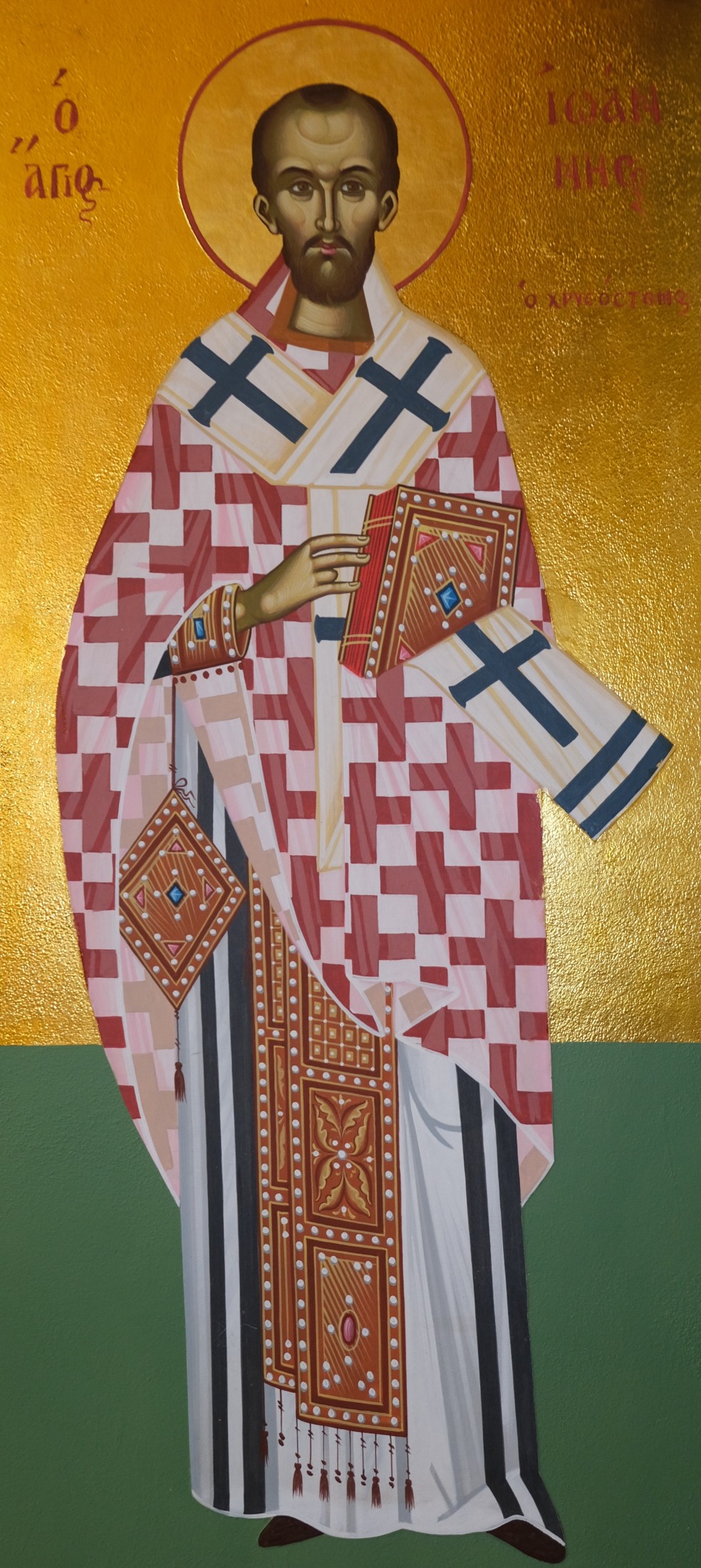
This greatest and most beloved of all Christian orators was born in Antioch the Great in the year 344 or 347; his pious parents were called Secundus and Anthusa. After his mother was widowed at the age of twenty, she devoted herself to bringing up John and his elder sister in the nurture and admonition of the Lord. John received his literary training under Anthragathius the philosopher, and Libanius the sophist, who was the greatest Greek scholar and rhetorician of his day. Libanius was a pagan, and when asked before his death whom he wished to have for his successor, he said, "John, had not the Christians stolen him from us." With such a training, and with such gifts as he had by nature, John had before him a brilliant career as a rhetorician. But through the good example of his godly mother Anthusa and of the holy Bishop Meletius of Antioch (see Feb. 12), by whom he was ordained reader about the year 370, he chose instead to dedicate himself to God. From the years 374 to 381 he lived the monastic life in the hermitages that were near Antioch. His extreme asceticism undermined his health, compelling him to return to Antioch, where Saint Meletius ordained him deacon about the year 381. Saint Meletius was called to Constantinople later that year to preside over the Second Ecumenical Council, during which he fell asleep in the Lord. In 386 Bishop Flavian ordained John presbyter of the Church of Antioch. Upon his elevation to the priesthood his career as a public preacher began, and his exceptional oratorical gifts were made manifest through his many sermons and commentaries. They are distinguished by their eloquence and the remarkable ease with which rich imagery and scriptural allusions are multiplied; by their depth of insight into the meaning of Scripture and the workings of God's providence; and, not least of all, by their earnestness and moral force, which issue from the heart of a blameless and guileless man who lived first what he preached to others. Because of his fame, he was chosen to succeed Saint Nectarius as Patriarch of Constantinople. He was taken away by stealth, to avoid the opposition of the people, and consecrated Patriarch of Constantinople on February 28, 398, by Theophilus, Patriarch of Alexandria, who was to prove his mortal enemy. Learn More
[Greek Orthodox Archdiocese of America - June 24]
January 7
.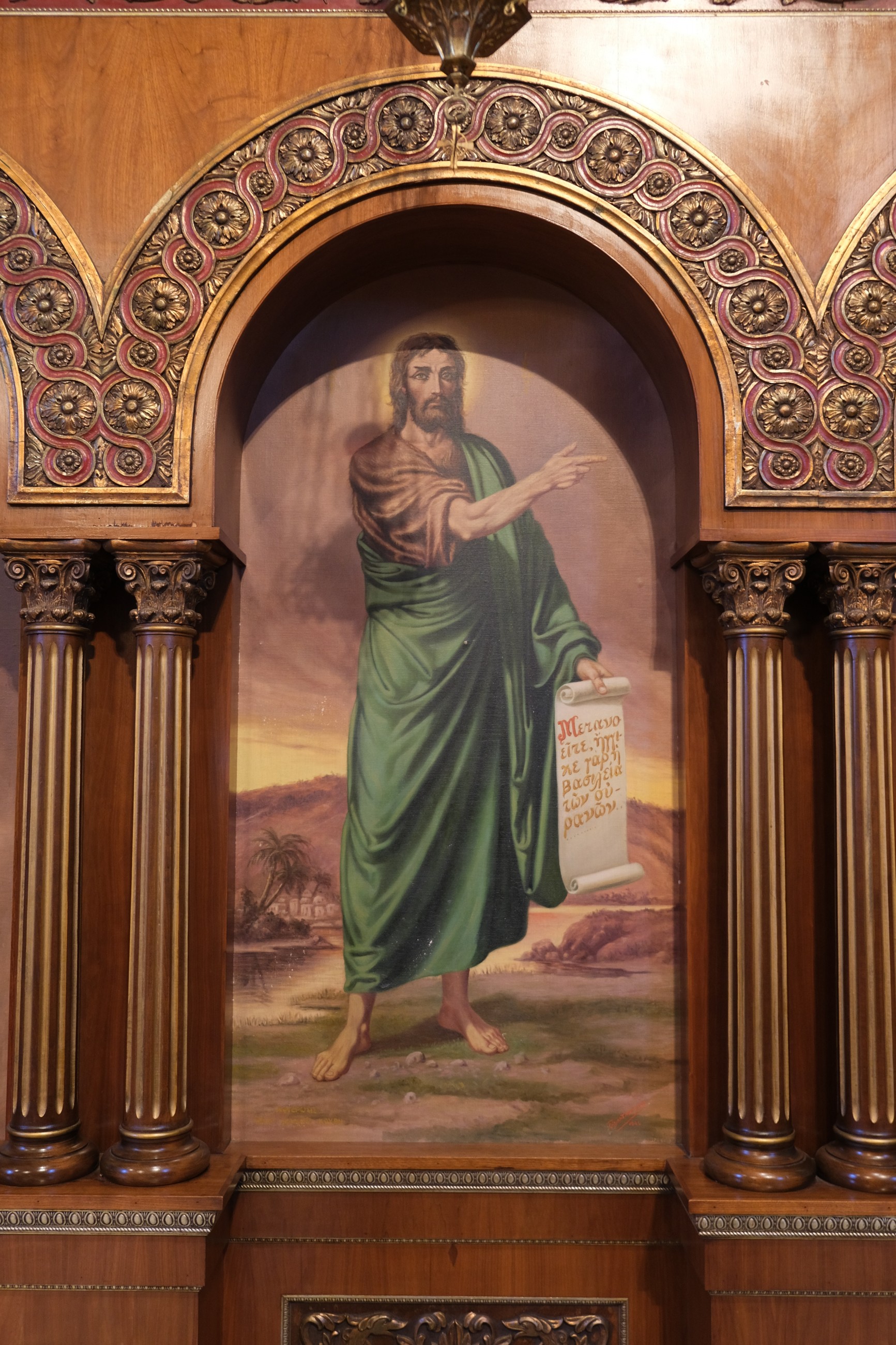
He that was greater than all who are born of women, the Prophet who received God's testimony that he surpassed all the Prophets, was born of the aged and barren Elizabeth (Luke 1: 7) and filled all his kinsmen, and those that lived round about, with gladness and wonder. But even more wondrous was that which followed on the eighth day when he was circumcised, that is, the day on which a male child receives his name. Those present called him Zacharias, the name of his father. But the mother said, "Not so, but he shall be called John." Since the child's father was unable to speak, he was asked, by means of a sign, to indicate the child's name. He then asked for a tablet and wrote, "His name is John." And immediately Zacharias' mouth was opened, his tongue was loosed from its silence of nine months, and filled with the Holy Spirit, he blessed the God of Israel, Who had fulfilled the promises made to their fathers, and had visited them that were sitting in darkness and the shadow of death, and had sent to them the light of salvation. Zacharias prophesied concerning the child also, saying that he would be a Prophet of the Most High and Forerunner of Jesus Christ. And the child John, who was filled with grace, grew and waxed strong in the Spirit; and he was in the wilderness until the day of his showing to Israel (Luke 1:57-80). His name is a variation of the Hebrew "Johanan," which means "Yah is gracious." Learn More
[Greek Orthodox Archdiocese of America - June 24]
September 26
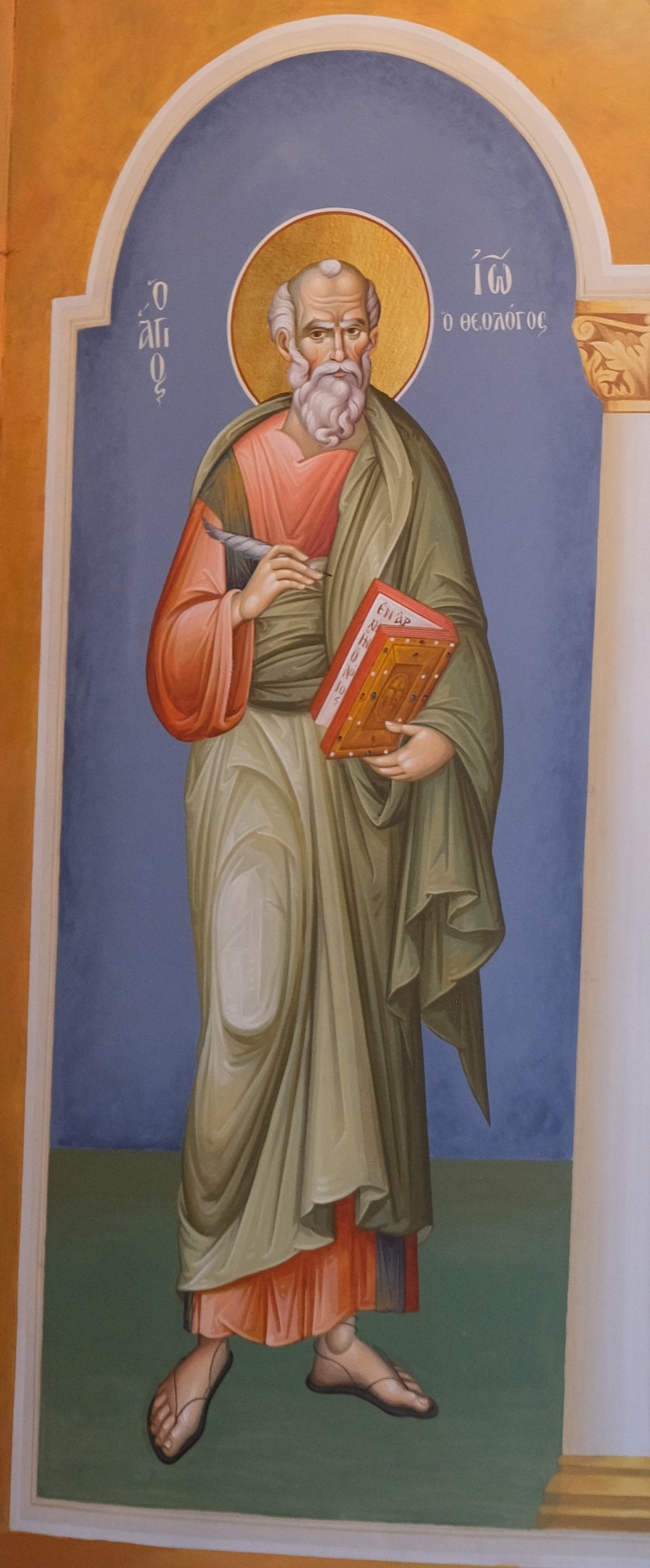
This Apostle was from Bethsaida of Galilee, and was the son of Zebedee and Salome, and the brother of James the elder. First a fisherman by trade, he became an Apostle and the beloved Disciple of Christ. Only he of all the Disciples followed Him even to the Cross, and was entrusted with the care of our Saviour's Mother, as it were another son to her, and a brother of Christ the Teacher. After this, he preached throughout Asia Minor, especially in Ephesus. When the second persecution against the Christians began in the year 96 during the reign of Domitian, he was taken in bonds to Rome, and there was cast into a vat filled to the brim with boiling oil. Coming forth therefrom unharmed, he was exiled to the island of Patmos, where he wrote the Book of Revelation. Returning again to Ephesus after the death of the tyrant, he wrote his Gospel (after the other Evangelists had already written theirs) and his three Catholic Epistles. In all, he lived ninety-five years and fell asleep in the Lord during the reign of Trajan in the year 100. He was called Theologian because he loftily expounded in his Gospel the theology of the inexpressible and eternal birth of the Son and Word of God the Father. It is for this cause that an eagle-a symbol of the Holy Spirit, as Saint Irenaeus says-is depicted in his icon, for this was one of the four symbolic living creatures that the Prophet Ezekiel saw (Ezek. 1:10). Read More
[Greek Orthodox Archdiocese of America - June 24]
November 12
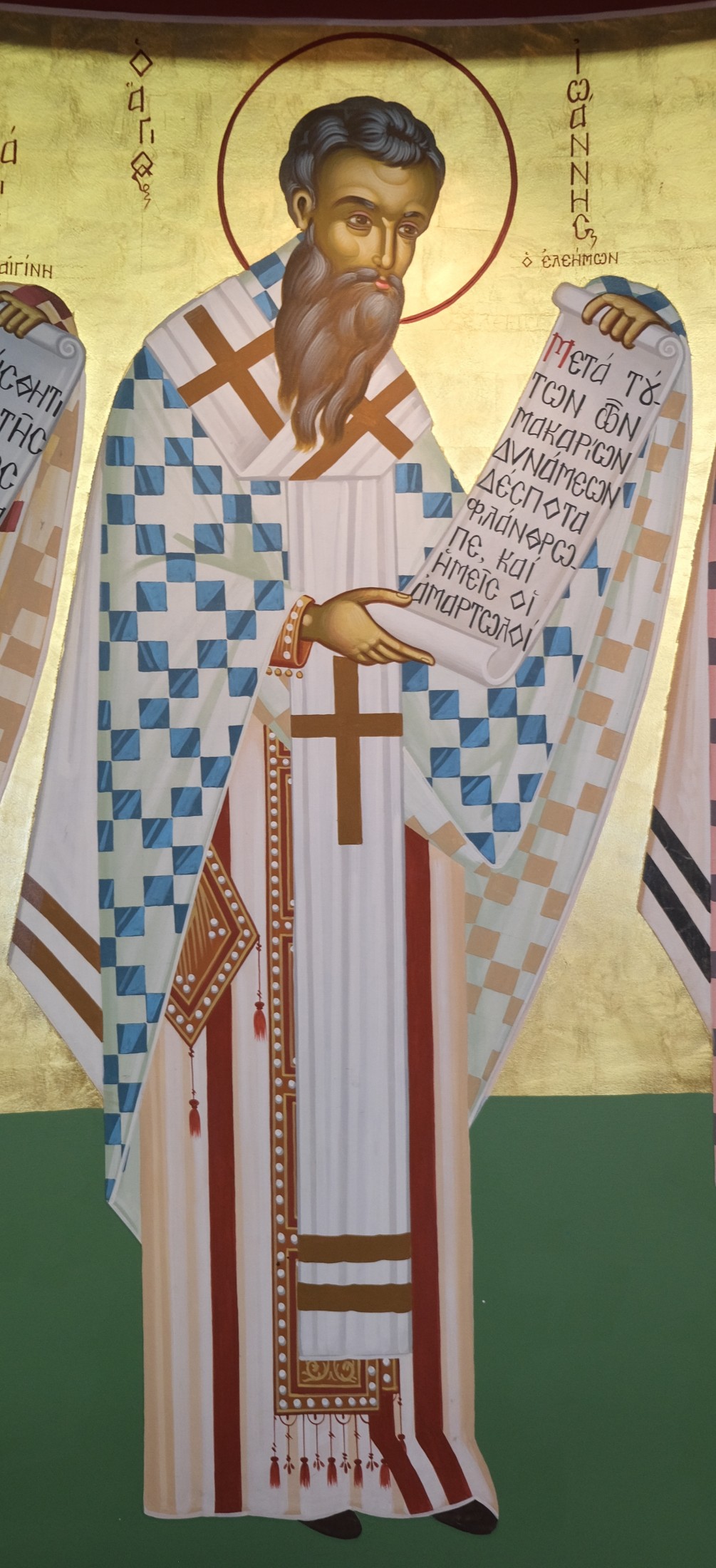
Saint John was born in 555 on the island of Cyprus in the city of Amathus; his father, Epiphanius, was a ruler of Cyprus. The Saint was consecrated Archbishop of Alexandria in 608. A man of exemplary uprightness, in his zeal for Orthodoxy he strove mightily to fight the many heresies among the Christians in Egypt; but above all, he was famous for his singular generosity, humility, and sympathy towards all, especially the poor. His mercy was so great that the report of it reached the Persian invaders of Jerusalem, who desired to see him because of it. Saint John reposed in 619, at the age of sixty-four. Learn More
[Greek Orthodox Archdiocese of America - June 24]
May 27
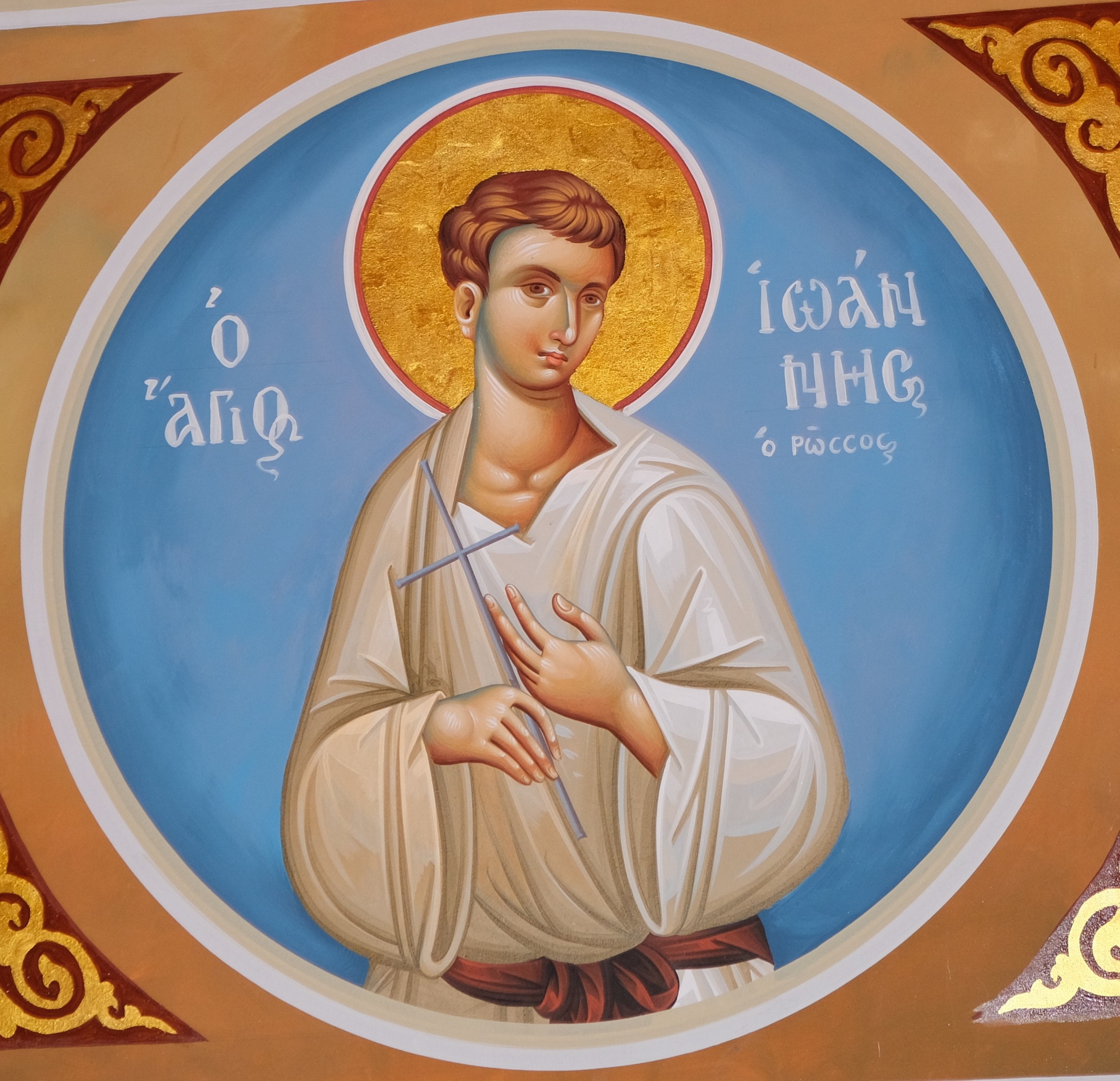
The Holy New Confessor John, a native of Russia, was captured during the Russian campaign against the Turks in 1711 and was thereafter sold into slavery in Asia Minor. In this condition he struggled to serve God in piety even while he served his earthly master in all that was needful. He remained steadfast in the Christian Faith in the face of the many enticements the Moslems provided to lure him to their error, and was granted the grace to work miracles by his prayers. He reposed in peace in 1730. His relics remained incorrupt and are found at New Procopion of Euboia in Greece. Read More
[Greek Orthodox Archdiocese of America - June 24]
September 7

---
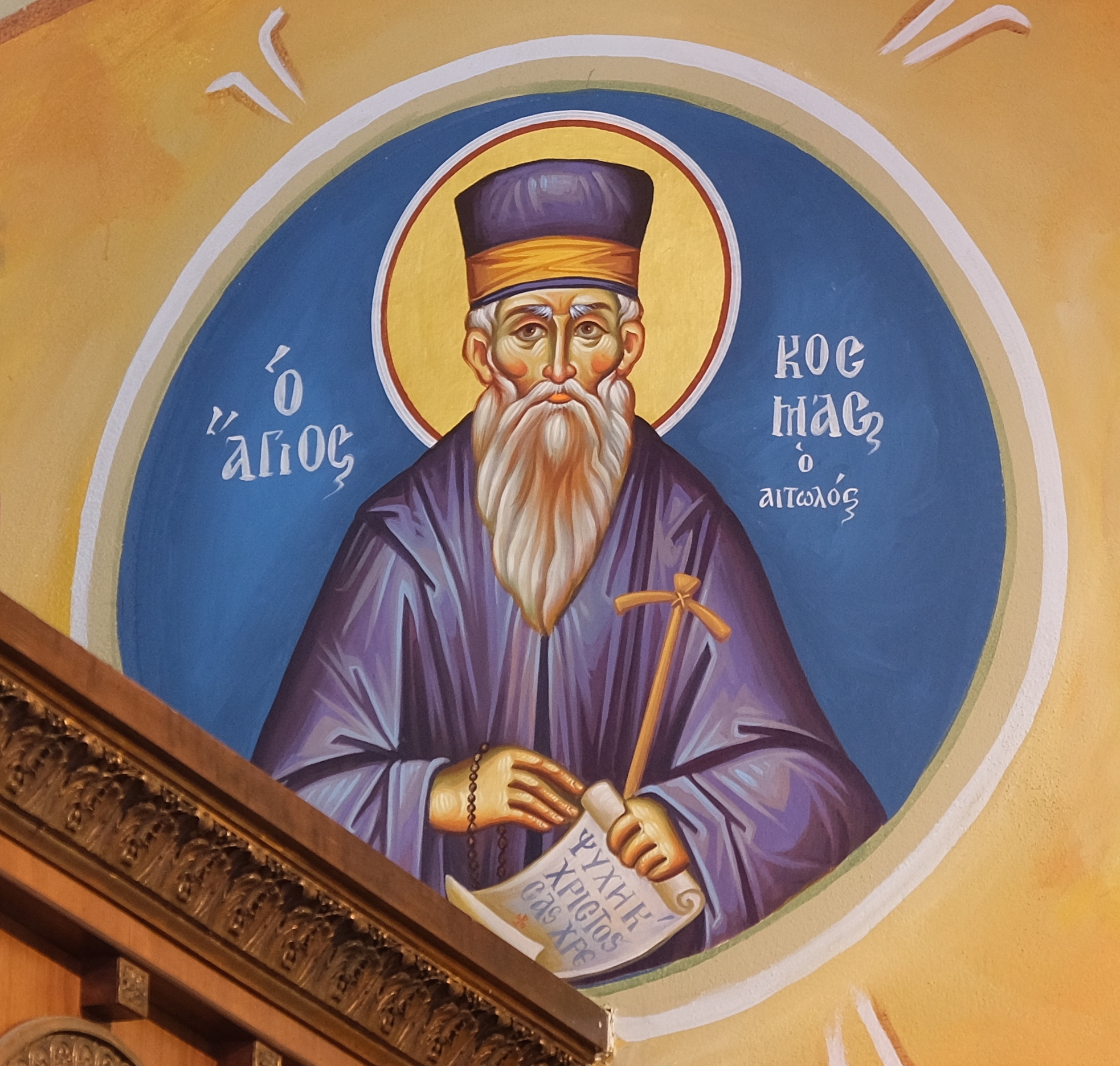
Our holy Father Cosmas was from the town of Mega Dendron (Great Tree) of Aetolia. At the age of twenty, he went to study at the school of the Monastery of Vatopedi on the Holy Mountain. Later, he came to the Athonite Monastery of Philotheou where he was tonsured. With the blessing of his abbot, he departed for Constantinople where he learned the art of rhetoric, and thereafter, he began to preach throughout all the regions of northern Greece, the Ionian Islands, but especially in Albania, for the Christian people there were in great ignorance because of the oppression and cruelty of the Moslems. Finally, in 1776, after having greatly strengthened and enlightened the faithful, working many signs and wonders all the while, he was falsely accused by the leaders of the Jewish people and was executed by strangulation by the Moslem Turks in Albania. Read More
[Greek Orthodox Archdiocese of America - July 4]
July 7
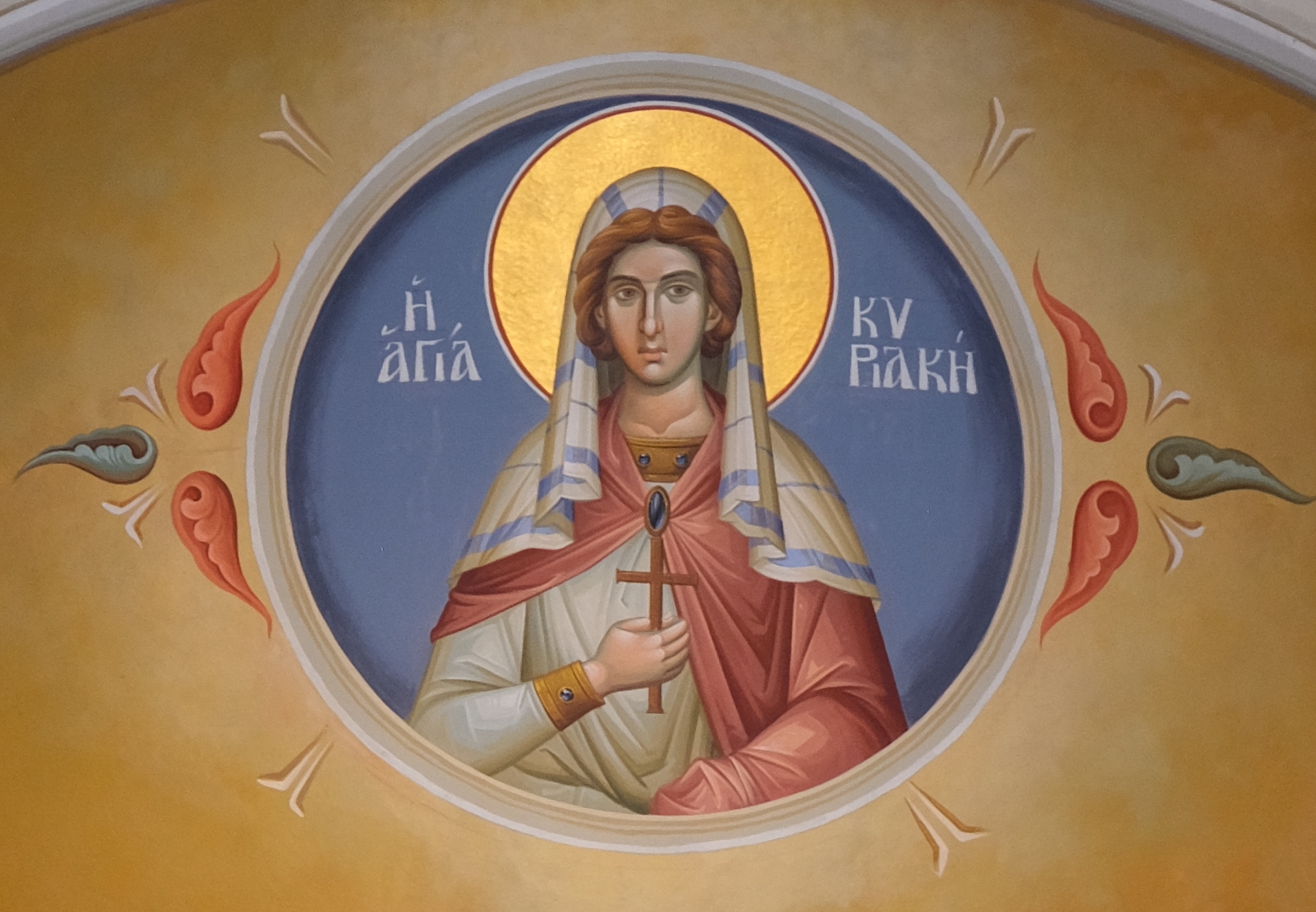
Saint Kyriake was the daughter of Christian parents, Dorotheus and Eusebia. She was given her name because she was born on Sunday, the day of the Lord (in Greek, Kyriake). She contested in Nicomedia during the reign of Diocletian, in the year 300. After many bitter torments she was condemned to suffer beheading, but being granted time to pray first, she made her prayer and gave up her holy soul in peace. Read More
[Greek Orthodox Archdiocese of America - July 5]
October 18
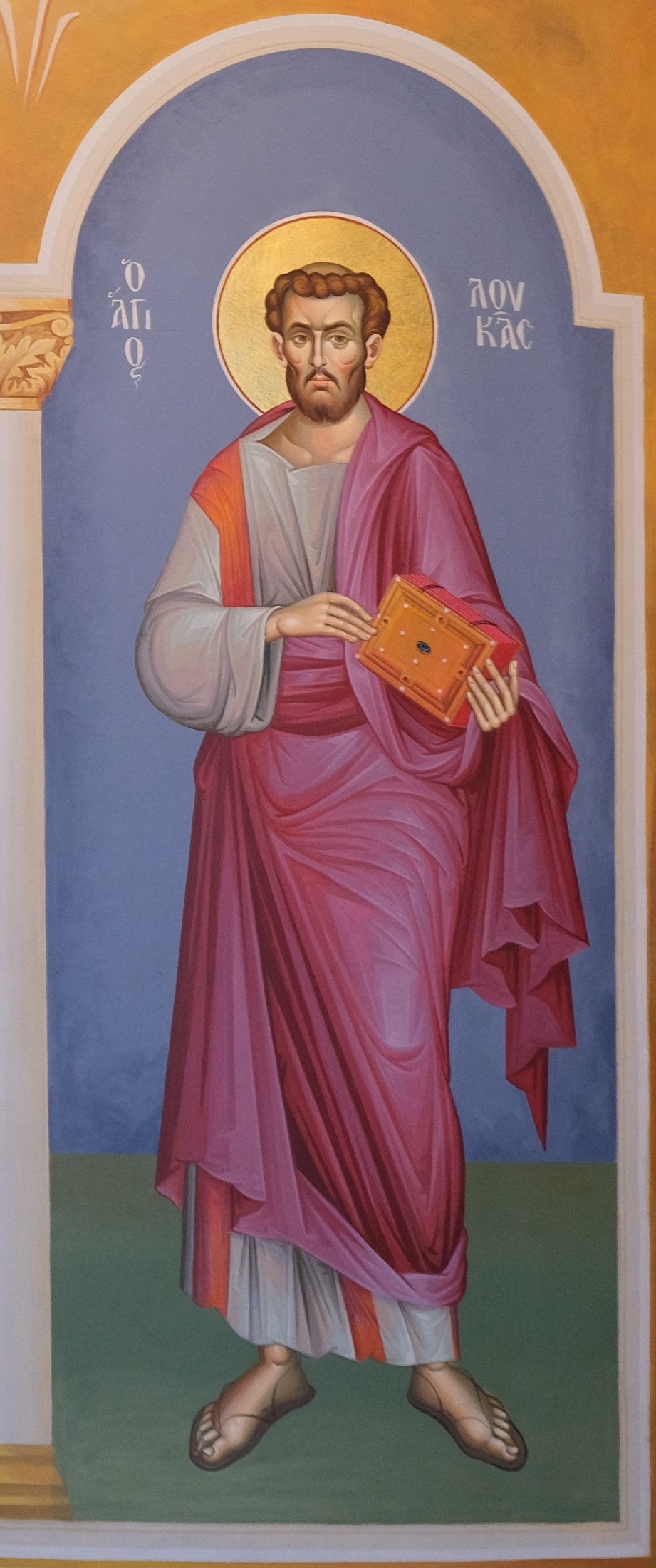
This Apostle was an Antiochean, a physician by trade, and a disciple and companion of Paul. He wrote his Gospel in Greek after Matthew and Mark, after which he wrote the Acts of the Apostles, and dedicated both works to Theophilus, who, according to some, was Governor of Achaia. He lived some eighty-six years and died in Achaia, perhaps in Patras, the capital of this district. His emblem is the calf, the third symbolical beast mentioned by Ezekiel (1:10), which is a symbol of Christ's sacrificial and priestly office, as Saint Irenaeus says. Learn More
[Greek Orthodox Archdiocese of America - June 24]
---
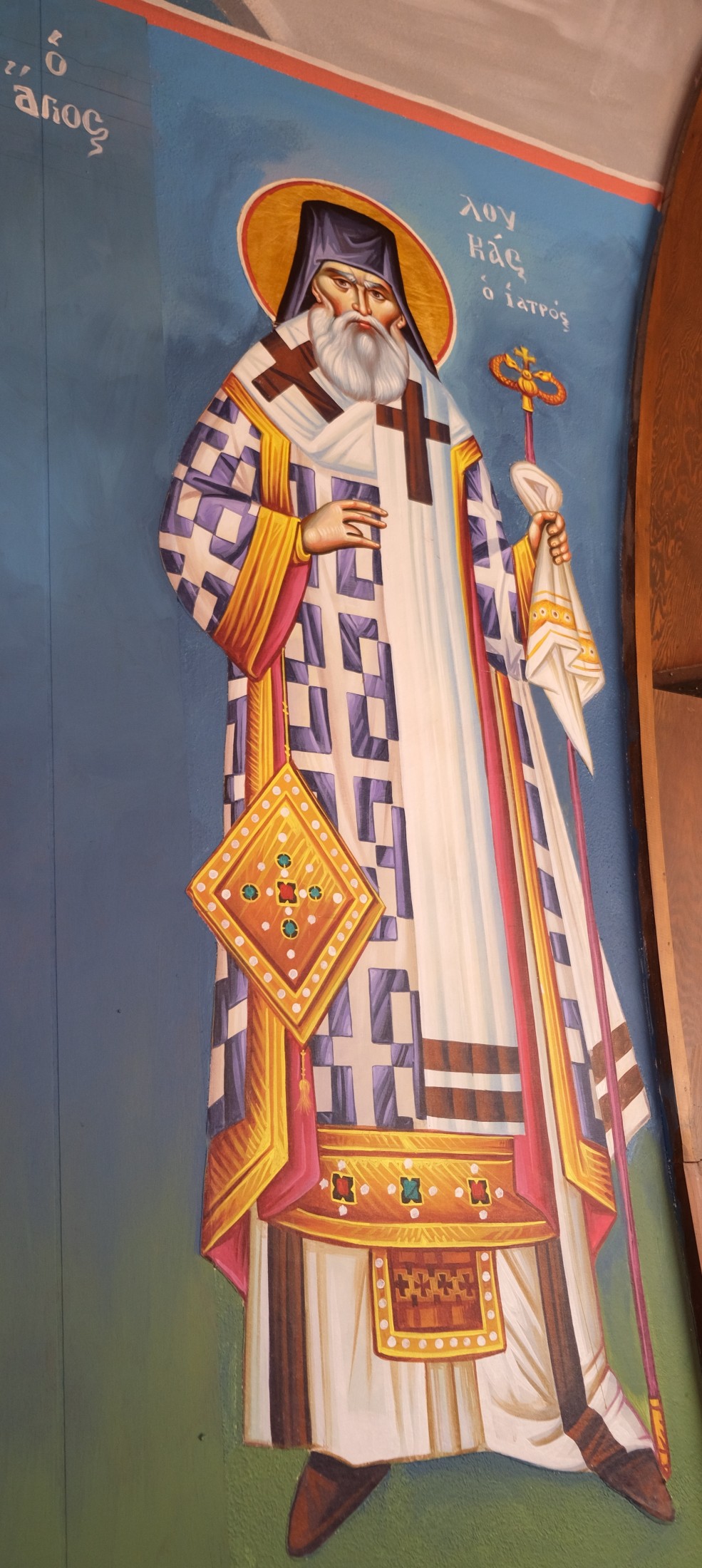
---
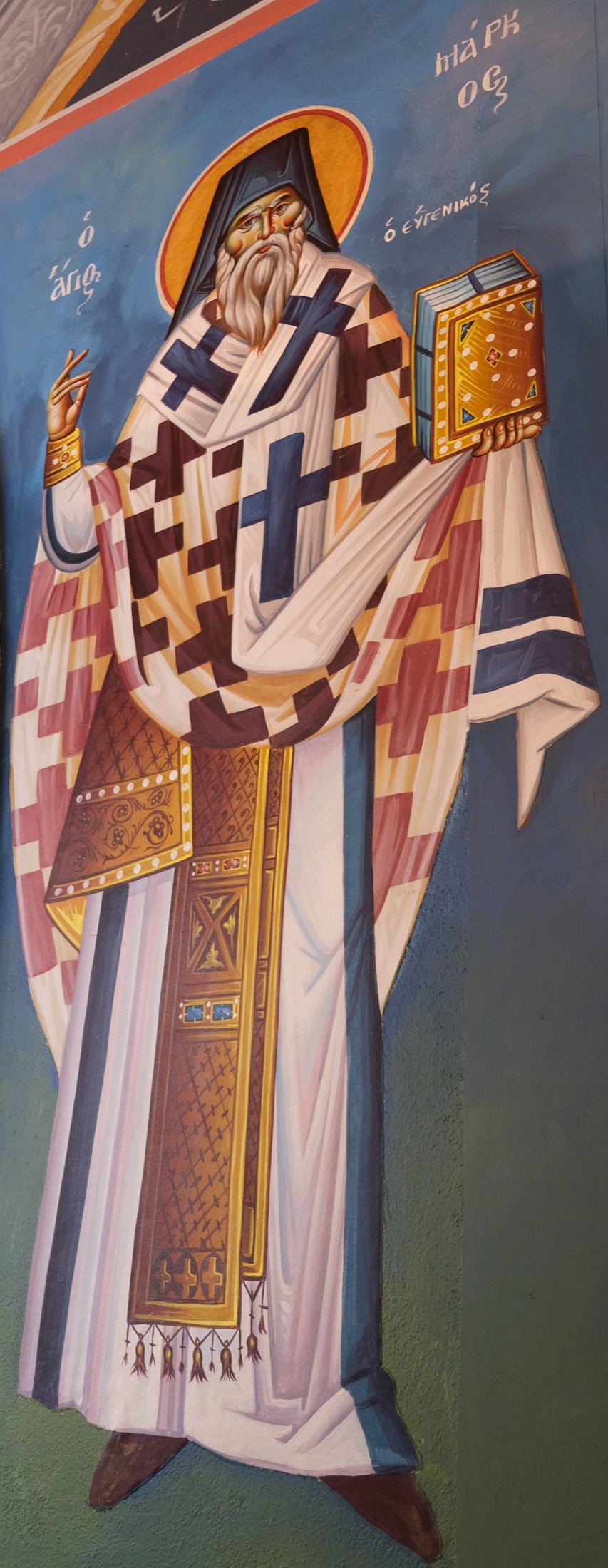
March 25
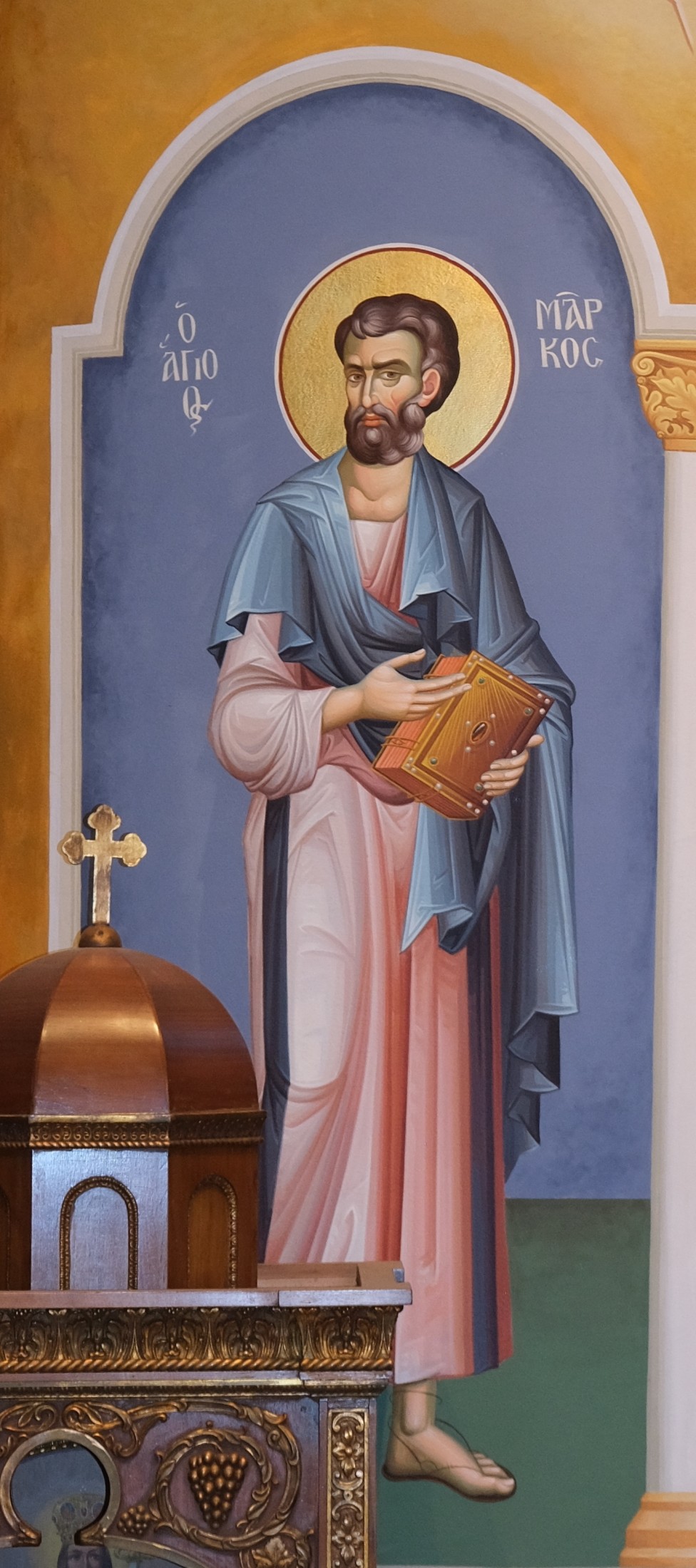
Mark was an idolater from Cyrene of Pentapolis, which is near Libya. Having come to the Faith of Christ through the Apostle Peter, he followed him to Rome. While there, at the prompting of Peter himself and at the request of the Christians living there, he wrote his Gospel in Greek, and it is second in order after Matthew's. Afterwards, travelling to Egypt, he preached the Gospel there and was the first to establish the Church in Alexandria. The idolaters, unable to bear his preaching, seized him, bound him with ropes, and dragged him through the streets until he, cut to pieces on rocks, gave up his soul. It is said that he completed his life in martyrdom about the year 68. He is depicted in holy icons with a lion next to him, one of the living creatures mentioned by Ezekiel (1:10), and a symbol of Christ's royal office, as Saint Irenaeus of Lyons writes. Learn More
[Greek Orthodox Archdiocese of America - June 24]
Novembver 16
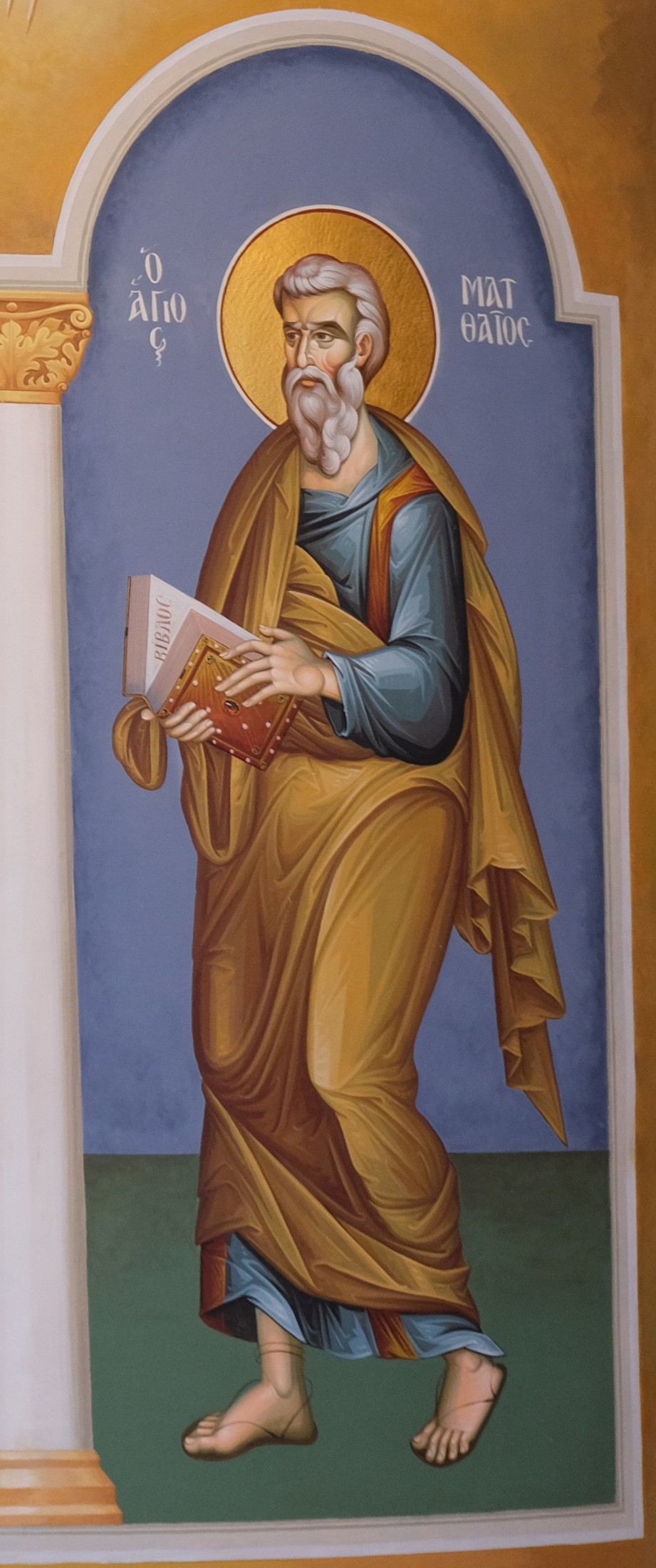
This Apostle, who was also called Levi, was the son of Alphaeus and had Galilee as his homeland. A publican before being called by Christ, he became one of the Twelve Apostles, and an Evangelist. While still in Palestine, he wrote his Gospel first in Hebrew, being also the first of all to write the Gospel. When he is depicted in icons, there is portrayed next to him the likeness of a man, one of the symbolic living creatures mentioned by Ezekiel (1.10), which, as Saint Irenaeus writes, is a symbol of our Saviour's Incarnation. Learn More
[Greek Orthodox Archdiocese of America - June 24]
November 11
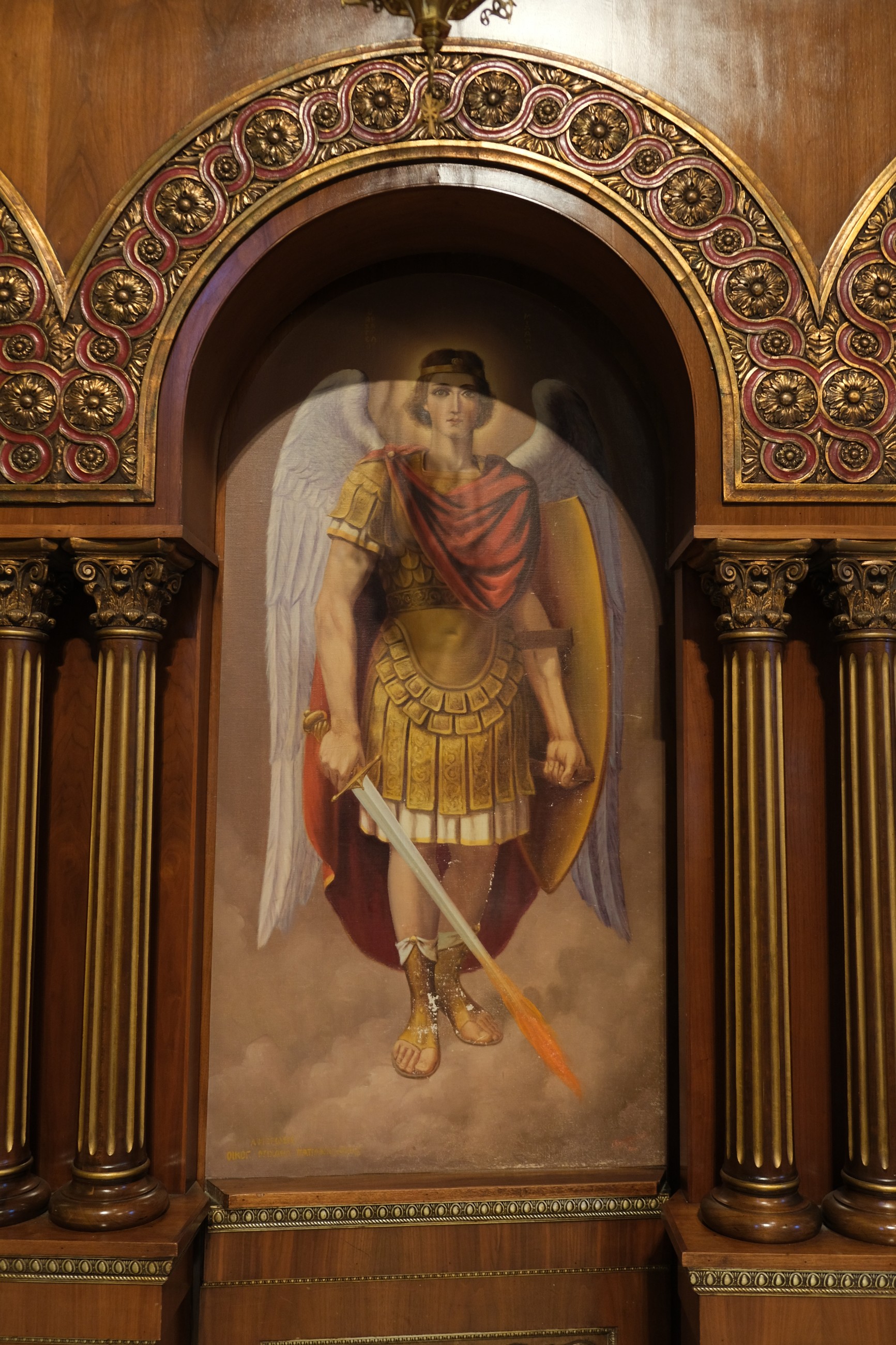
All the Angels, according to the Apostle Paul, are ministering spirits, - sent forth to minister to them who shall be heirs of salvation - (Heb. 1:14). God set them as overseers of every nation and people, and guides to that which is profitable (Deut. 32:8); and while one Angel is appointed to oversee each nation as a whole, one is also appointed to protect each Christian individually. He commands them to guard them that hope on Him, that nothing should harm them, neither should any evil draw nigh to their dwelling (Ps. 90:10-12). In the Heavens they always behold the face of God, sending up to Him the thrice-holy hymn and interceding with Him in our behalf, seeing they rejoice over one sinner that repents (Esaias 6:2-3; Matt. 18:10; Luke 15:7). In a word, they have served God in so many ways for our benefit, that the pages of Holy Scripture are filled with the histories thereof. It is for these reasons that the Orthodox Catholic Church, wisely honouring these divine ministers, our protectors and guardians, celebrates today the present Synaxis that is, our coming together in assembly for their common feast to chant their praises, especially for the Archangels Michael and Gabriel, who are mentioned in the Scriptures by name. The name Michael means "Who is like God?" and Gabriel means "God is mighty." The number of Angels is not defined in the divine Scriptures, where Daniel says that thousands of thousands ministered before Him, and ten thousands of ten thousands attended upon Him -(Dan. 7:10). But all of them are divided into nine orders which are called Thrones, Cherubim, Seraphim, Dominions, Powers, Authorities, Principalities, Archangels, and Angels. Learn More
[Greek Orthodox Archdiocese of America - June 24]
November 9
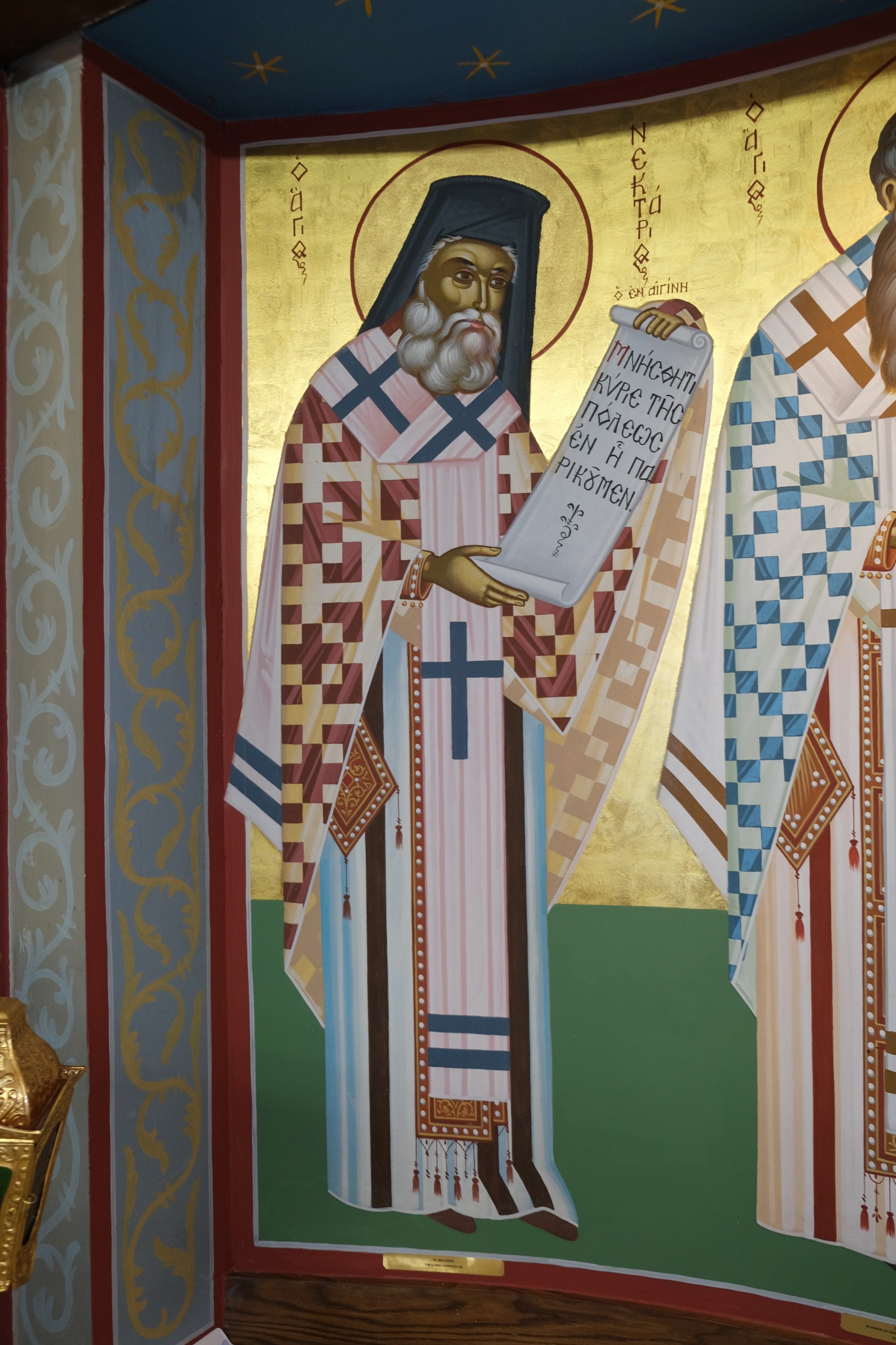
Saint Nektarius was born in Selyvria of Thrace on October 1, 1846. After putting himself through school in Constantinople with much hard labour, he became a monk on Chios in 1876, receiving the monastic name of Lazarus; because of his virtue, a year later he was ordained deacon, receiving the new name of Nektarius. Under the patronage of Patriarch Sophronius of Alexandria, Nektarius went to Athens to study in 1882; completing his theological studies in 1885, he went to Alexandria, where Patriarch Sophronius ordained him priest on March 23, 1886 in the Cathedral of Saint Sabbas, and in August of the same year, in the Church of Saint Nicholas in Cairo, made him Archimandrite. Archimandrite Nektarius showed much zeal both for preaching the word of God, and for the beauty of God's house. He greatly beautified the Church of Saint Nicholas in Cairo, and years later, when Nektarius was in Athens, Saint Nicholas appeared to him in a dream, embracing him and telling him he was going to exalt him very high. Learn More
[Greek Orthodox Archdiocese of America - June 24]
December 6
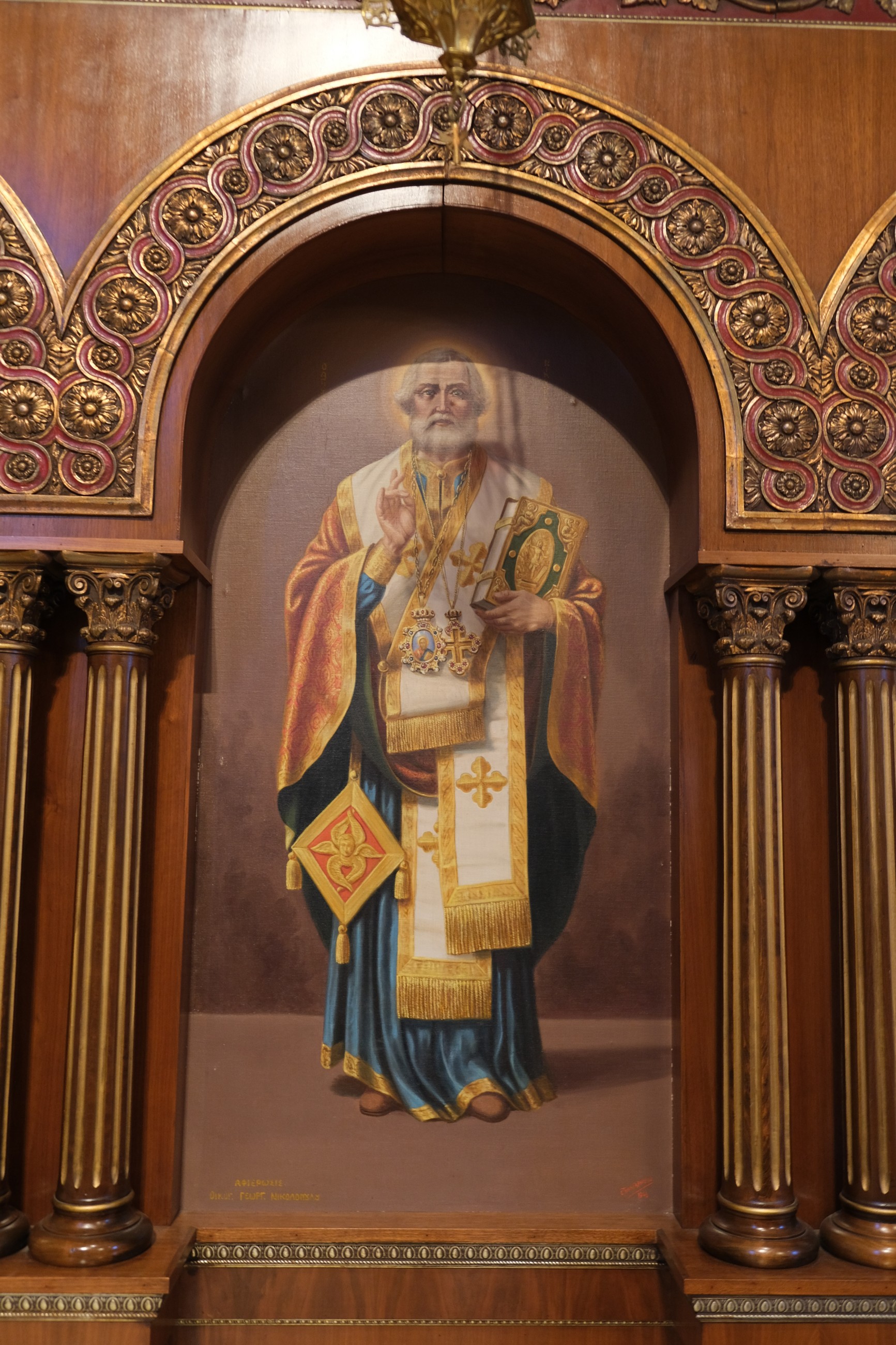
This Saint lived during the reign of Saint Constantine the Great, and reposed in 330, As a young man, he desired to espouse the solitary life. He made a pilgrimage to the holy city Jerusalem, where he found a place to withdraw to devote himself to prayer. It was made known to him, however, that this was not the will of God for him, but that he should return to his homeland to be a cause of salvation for many. He returned to Myra, and was ordained bishop. He became known for his abundant mercy, providing for the poor and needy, and delivering those who had been unjustly accused. No less was he known for his zeal for the truth. He was present at the First Ecumenical Council of the 318 Fathers at Nicaea in 325; upon hearing the blasphemies that Arius brazenly uttered against the Son of God, Saint Nicholas struck him on the face. Since the canons of the Church forbid the clergy to strike any man at all, his fellow bishops were in perplexity what disciplinary action was to be taken against this hierarch whom all revered. In the night our Lord Jesus Christ and our Lady Theotokos appeared to certain of the bishops, informing them that no action was to be taken against him, since he had acted not out of passion, but extreme love and piety. The Dismissal Hymn for holy hierarchs, The truth of things hath revealed thee to thy flock ... was written originally for Saint Nicholas. He is the patron of all travellers, and of sea-farers in particular; he is one of the best known and best loved Saints of all time. Learn More
[Greek Orthodox Archdiocese of America - June 24]
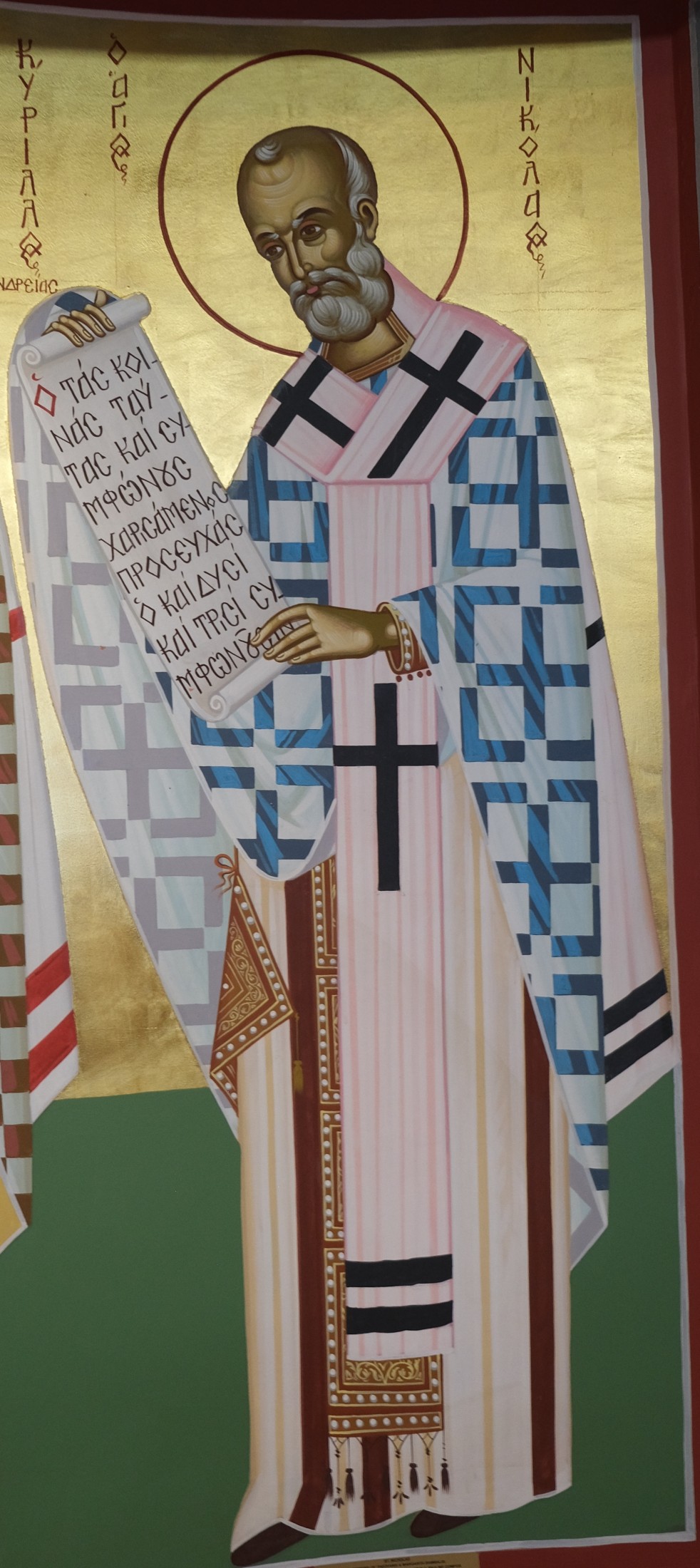
This Saint lived during the reign of Saint Constantine the Great, and reposed in 330, As a young man, he desired to espouse the solitary life. He made a pilgrimage to the holy city Jerusalem, where he found a place to withdraw to devote himself to prayer. It was made known to him, however, that this was not the will of God for him, but that he should return to his homeland to be a cause of salvation for many. He returned to Myra, and was ordained bishop. He became known for his abundant mercy, providing for the poor and needy, and delivering those who had been unjustly accused. No less was he known for his zeal for the truth. He was present at the First Ecumenical Council of the 318 Fathers at Nicaea in 325; upon hearing the blasphemies that Arius brazenly uttered against the Son of God, Saint Nicholas struck him on the face. Since the canons of the Church forbid the clergy to strike any man at all, his fellow bishops were in perplexity what disciplinary action was to be taken against this hierarch whom all revered. In the night our Lord Jesus Christ and our Lady Theotokos appeared to certain of the bishops, informing them that no action was to be taken against him, since he had acted not out of passion, but extreme love and piety. The Dismissal Hymn for holy hierarchs, The truth of things hath revealed thee to thy flock ... was written originally for Saint Nicholas. He is the patron of all travellers, and of sea-farers in particular; he is one of the best known and best loved Saints of all time. Learn More
[Greek Orthodox Archdiocese of America - June 24]
July 27
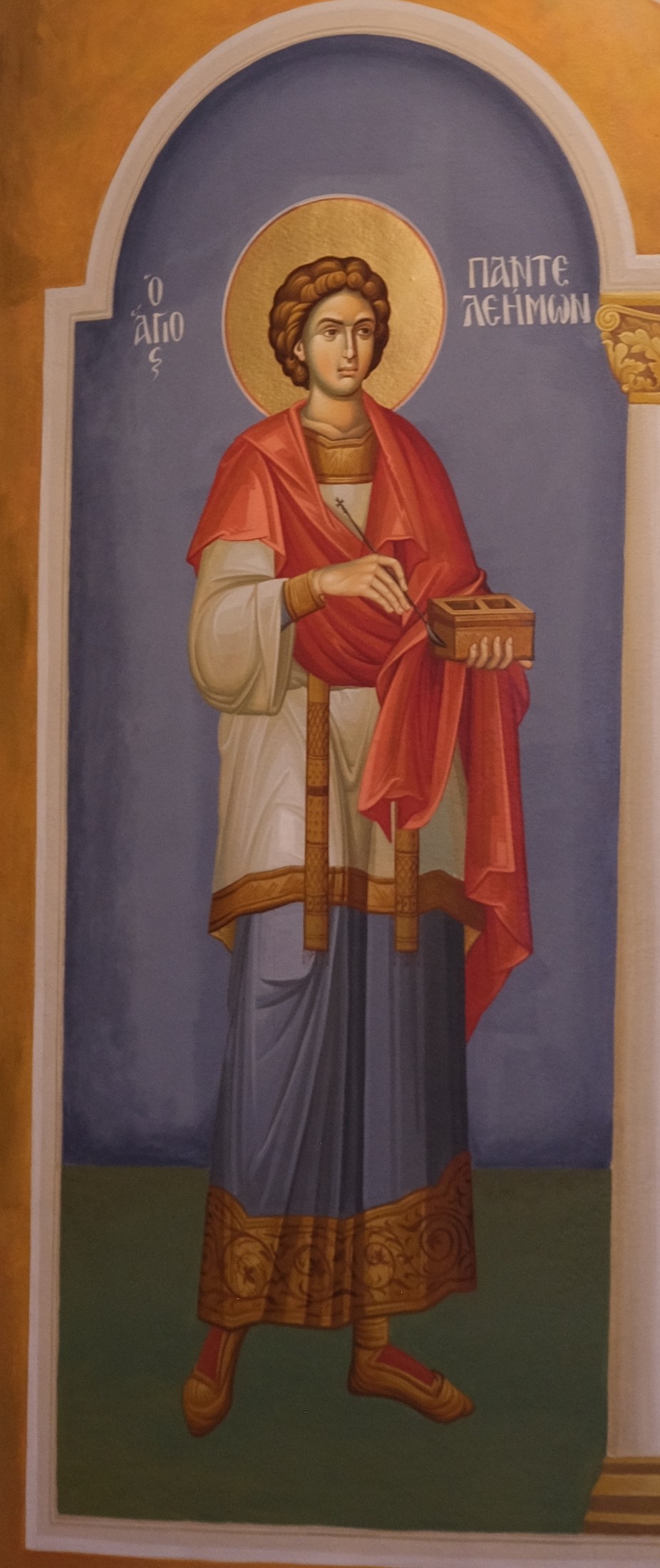
This Saint, who had Nicomedia as his homeland, was the son of Eustorgius and Eubula. His father was an idolater, but his mother was a Christian from her ancestors. It was through her that he was instructed in piety, and still later, he was catechized in the Faith of Christ by Saint Hermolaus (see July 26) and baptized by him. Being proficient in the physician's vocation, he practiced it in a philanthropic manner, healing every illness more by the grace of Christ than by medicines. Thus, although his parents had named him Pantoleon ("in all things a lion"), because of the compassion he showed for the souls and bodies of all, he was worthily renamed Panteleimon, meaning "all-merciful." On one occasion, when he restored the sight of a certain blind man by calling on the Divine Name, he enlightened also the eyes of this man's soul to the knowledge of the truth. This also became the cause for the martyrdom of him who had been blind, since when he was asked by whom and in what manner his eyes had been opened, in imitation of that blind man of the Gospel he confessed with boldness both who the physician was and the manner of his healing. For this he was put to death immediately. Panteleimon was arrested also, and having endured many wounds, he was finally beheaded in the year 305, during the reign of Maximian. Saint Panteleimon is one of the Holy Unmercenaries, and is held in special honor among them, even as Saint George is among the Martyrs. Learn More
[Greek Orthodox Archdiocese of America - June 24]
July 26
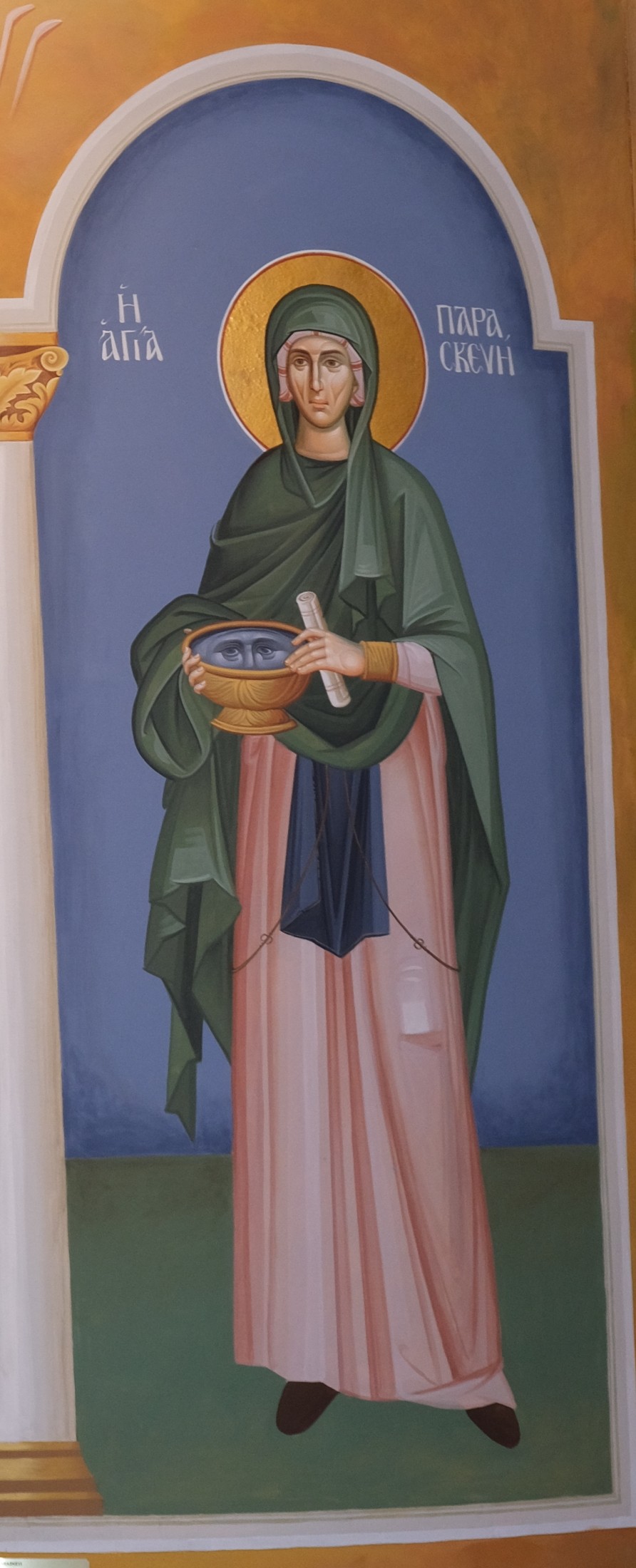
Saint Paraskeve, who was from a certain village near Rome, was born to pious parents, Agatho and Politia. Since she was born on a Friday (in Greek, Paraskeve), she was given this name, which means "preparation" or "preparedness" (compare Matt. 27:62, Mark 15:42, Luke 23:54, and John 19:31, where 'Friday' is called "the day of the preparation"). From childhood she was instructed in the sacred letters and devoted herself to the study of the divine Scriptures, while leading a monastic life and guiding many to the Faith of Christ. During the reign of the Emperor Antoninus Pius, she was apprehended because she was a Christian and was urged to worship the idols, but she answered with the words of Jeremias: "Let the gods that have not made heaven and the earth perish from off the earth" (Jer. 10:11). Because of this she endured exceedingly painful torments, and was beheaded in the year 140. The faithful pray to her for the healing of eye ailments. Learn More
[Greek Orthodox Archdiocese of America - June 24]
July 12
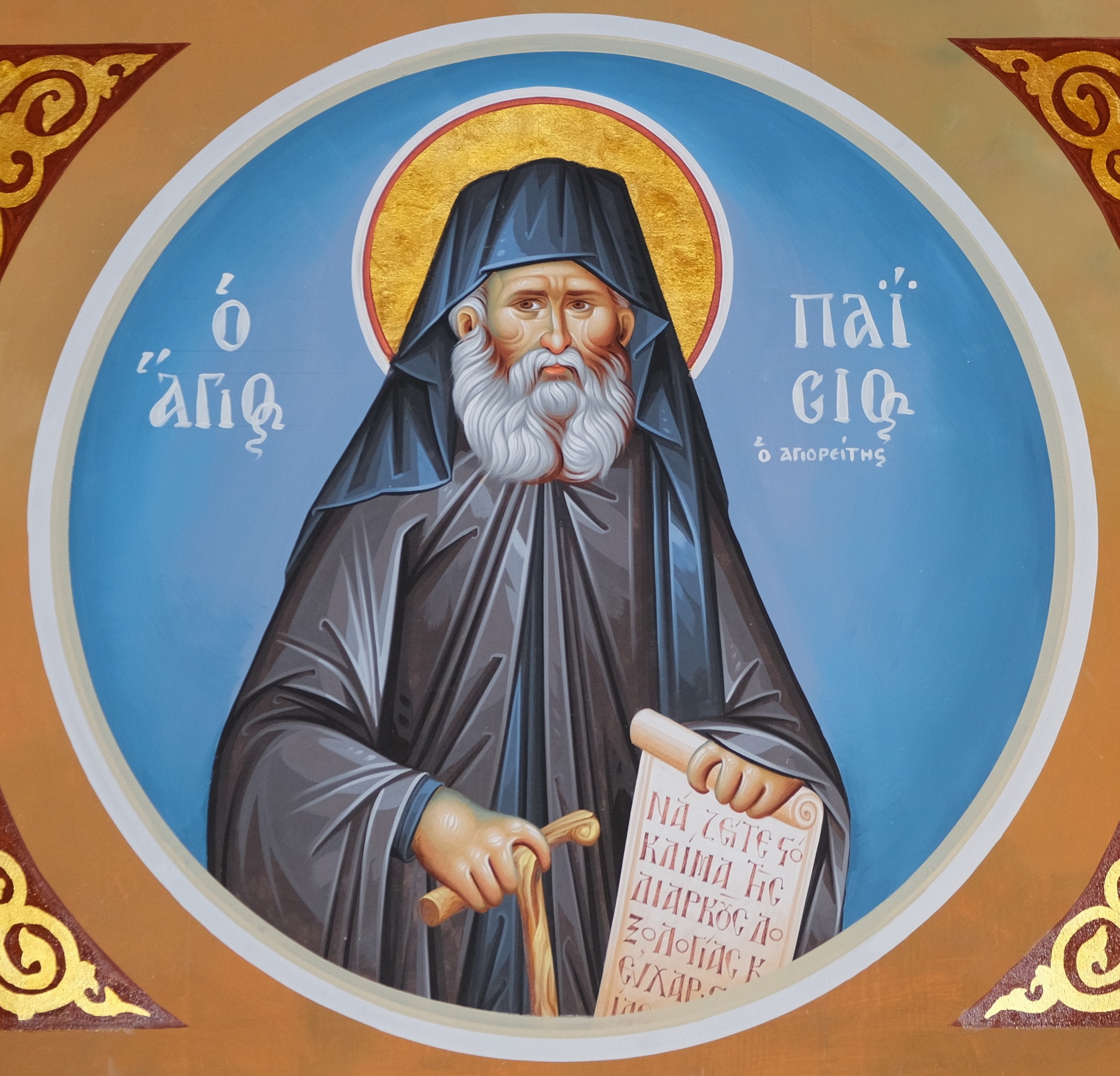
June 29
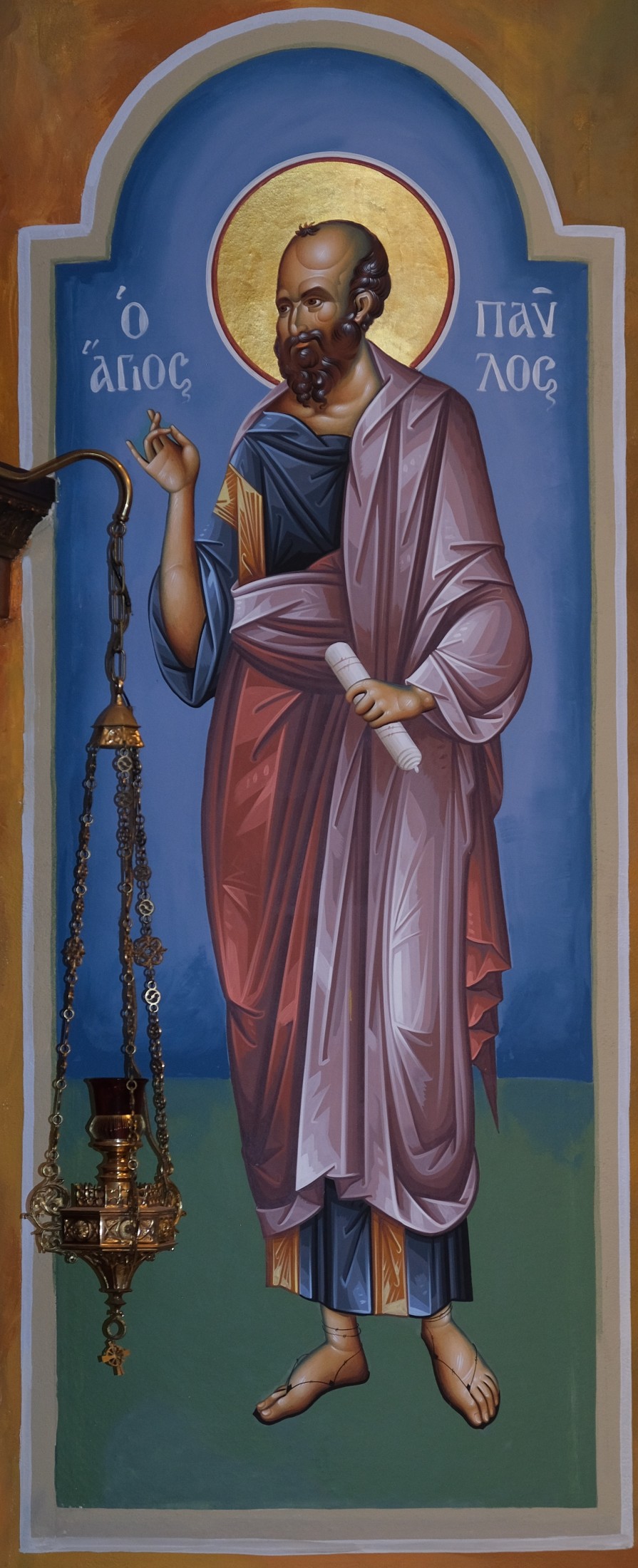
Paul, the chosen vessel of Christ, the glory of the Church, the Apostle of the Nations and teacher of the whole world, was a Jew by race, of the tribe of Benjamin, having Tarsus as his homeland. He was a Roman citizen, fluent in the Greek language, an expert in knowledge of the Law, a Pharisee, born of a Pharisee, and a disciple of Gamaliel, a Pharisee and notable teacher of the Law in Jerusalem. For this cause, from the beginning, Paul was a most fervent zealot for the traditions of the Jews and a great persecutor of the Church of Christ; at that time, his name was Saul (Acts 22:3-4). In his great passion of rage and fury against the disciples of the Lord, he went to Damascus bearing letters of introduction from the high priest. His intention was to bring the disciples of Christ back to Jerusalem in bonds. As he was approaching Damascus, about midday there suddenly shone upon him a light from Heaven. Falling on the earth, he heard a voice saying to him, "Saul, Saul, why persecutest thou Me?" And he asked, "Who art Thou, Lord?" And the Lord said, "I am Jesus Whom thou persecutest; it is hard for thee to kick against the pricks." And that heavenly voice and brilliance made him tremble, and he was blinded for a time. He was led by the hand into the city, and on account of a divine revelation to the Apostle Ananias (see Oct. 1), he was baptized by him, and both his bodily and spiritual eyes were opened to the knowledge of the Sun of Righteousness. And straightway- O wondrous transformation! - beyond all expectation, he spoke with boldness in the synagogues, proclaiming that "Christ is the Son of God" (Acts 9:1-21). As for his zeal in preaching the Gospel after these things had come to pass, as for his unabating labors and afflictions of diverse kinds, the wounds, the prisons, the bonds, the beatings, the stonings, the shipwrecks, the journeys, the perils on land, on sea, in cities, in wildernesses, the continual vigils, the daily fasting, the hunger, the thirst, the nakedness, and all those other things that he endured for the Name of Christ, and which he underwent before nations and kings and the Israelites, and above all, his care for all the churches, his fiery longing for the salvation of all, whereby he became all things to all men, that he might save them all if possible, and because of which, with his heart aflame, he continuously traveled throughout all parts, visiting them all, and like a bird of heaven flying from Asia and Europe, the West and East, neither staying nor abiding in any one place - all these things are related incident by incident in the Book of the Acts, and as he himself tells them in his Epistles. His Epistles, being fourteen in number, are explained in 250 homilies by the divine Chrysostom and make manifest the loftiness of his thoughts, the abundance of the revelations made to him, the wisdom given to him from God, wherewith he brings together in a wondrous manner the Old with the New Testaments, and expounds the mysteries thereof which had been concealed under types; he confirms the doctrines of the Faith, expounds the ethical teaching of the Gospel, and demonstrates with exactness the duties incumbent upon every rank, age, and order of man. In all these things his teaching proved to be a spiritual trumpet, and his speech was seen to be more radiant than the sun, and by these means he clearly sounded forth the word of truth and illumined the ends of the world. Having completed the work of his ministry, he likewise ended his life in martyrdom when he was beheaded in Rome during the reign of Nero, at the same time, some say, when Peter was crucified. Learn More
[Greek Orthodox Archdiocese of America - June 24]
June 29
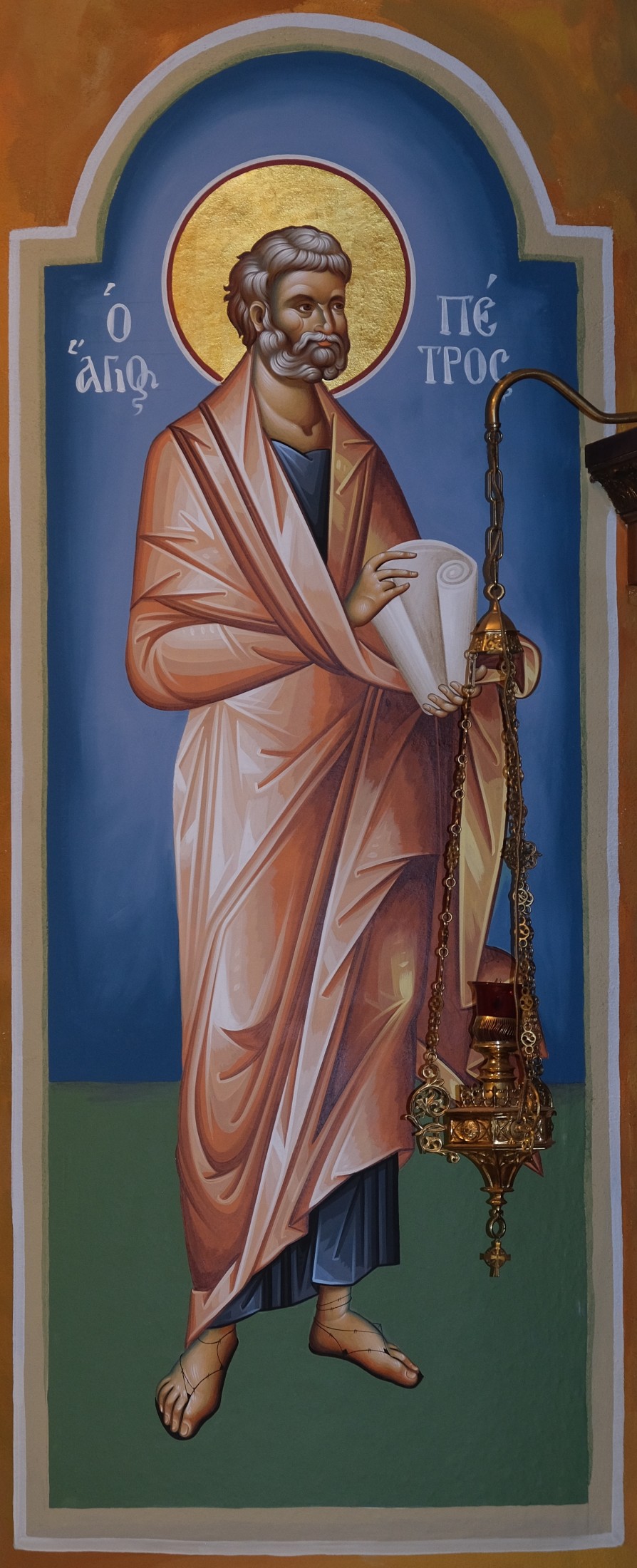
The divinely-blessed Peter was from Bethsaida of Galilee. He was the son of Jonas and the brother of Andrew the First-called. He was a fisherman by trade, unlearned and poor, and was called Simon; later he was renamed Peter by the Lord Jesus Christ Himself, Who looked at him and said, "Thou art Simon the son of Jonas; thou shalt be called Cephas (which is by interpretation, Peter)" (John 1:42). On being raised by the Lord to the dignity of an Apostle and becoming inseparable from Him as His zealous disciple, he followed Him from the beginning of His preaching of salvation up until the very Passion, when, in the court of Caiaphas the high priest, he denied Him thrice because of his fear of the Jews and of the danger at hand. But again, after many bitter tears, he received complete forgiveness of his transgression. After the Resurrection of Christ and the descent of the Holy Spirit, he preached in Judea, Antioch, and certain parts of Asia, and finally came to Rome, where he was crucified upside down by Nero, and thus he ascended to the eternal habitations about the year 66 or 68, leaving two Catholic (General) Epistles to the Church of Christ. Learn More
[Greek Orthodox Archdiocese of America - June 24]
December 2
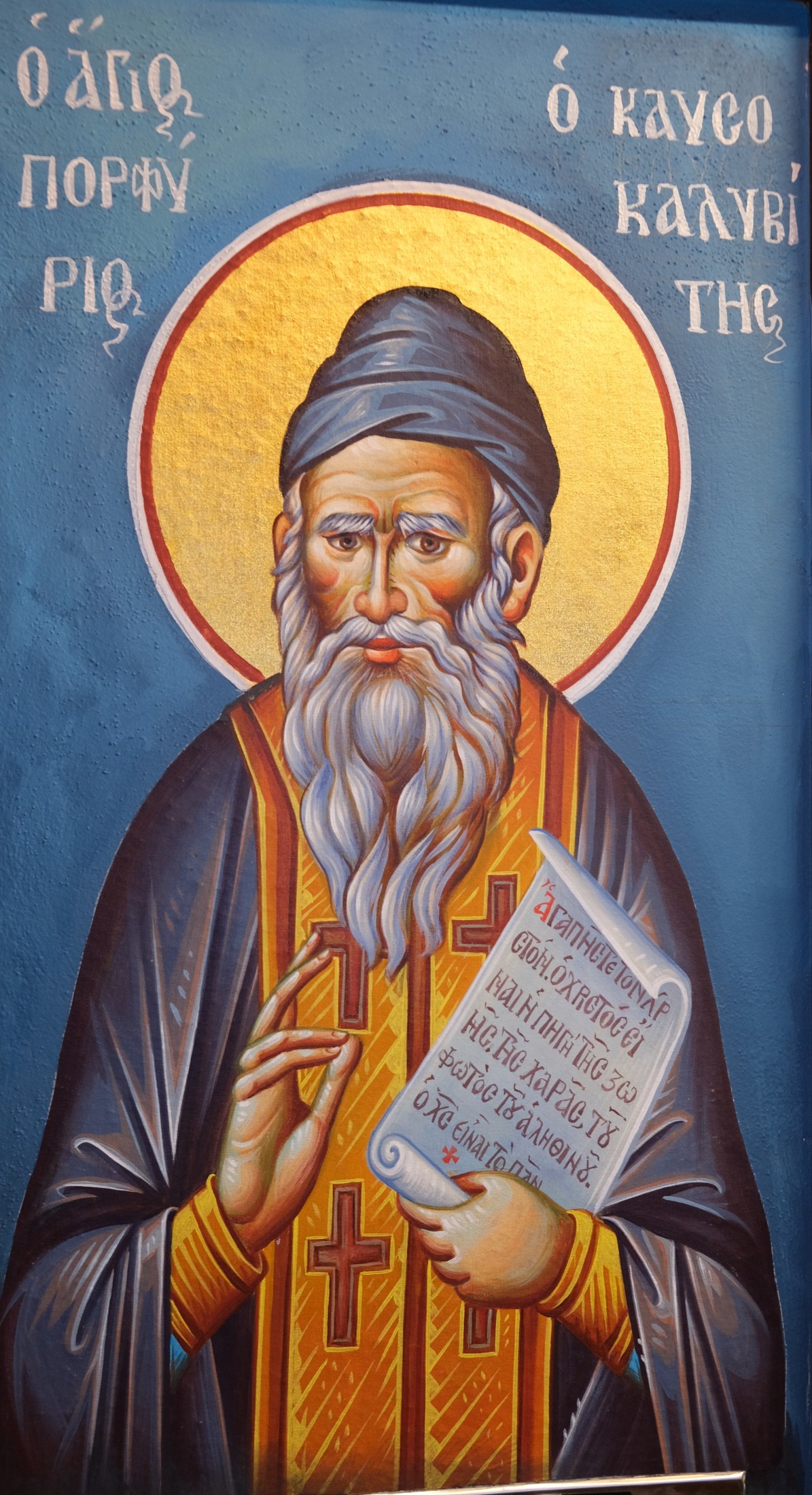
Saint Porphyrios (Bairaktaris) was born in 1907 with the name Evangelos in Evoia, Greece, in the small village of Agios Ioannis (Saint John). As a child he tended to the sheep in the hills, and it is there that he first read the life of Saint John the Hut-Dweller (Commemorated January 15th) which planted the desire of monasticism in his heart. The spark lit by Saint John was fanned when at the age of seven he overheard a conversation about the divine beauty of the Holy Mountain. Eventually he stowed away on a boat to Thessalonica, hoping from there to reach Mount Athos. Learn More
[Greek Orthodox Archdiocese of America - July 3]
October 1
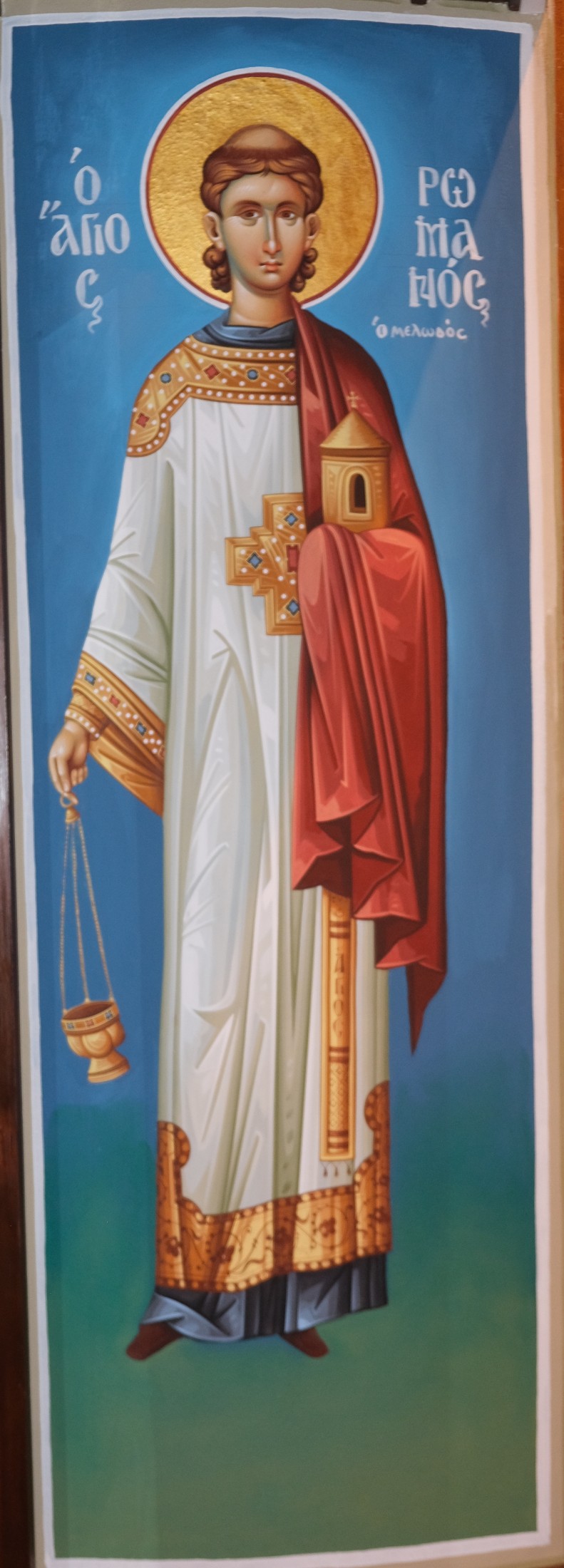
Saint Romanos flourished during the reign of Anastasius (491-518). He was from Emesa of Syria, and apparently was born of Jewish parents, for a hymn written in his honour in Greek says he was "of Hebrew stock," and it has furthermore been noted that he uses many Semitic idioms in his writings. He was baptized an Orthodox Christian, and at some time became a deacon in the Church of Beirut. He was the first composer of the kontakia, the foremost of which is that of the feast of Christ's Nativity, On this day the Virgin .... In composing many of his kontakia. Saint Romanos was inspired by the hymns of Saint Ephraim of Syria. Learn More
[Greek Orthodox Archdiocese of America - June 24]
---
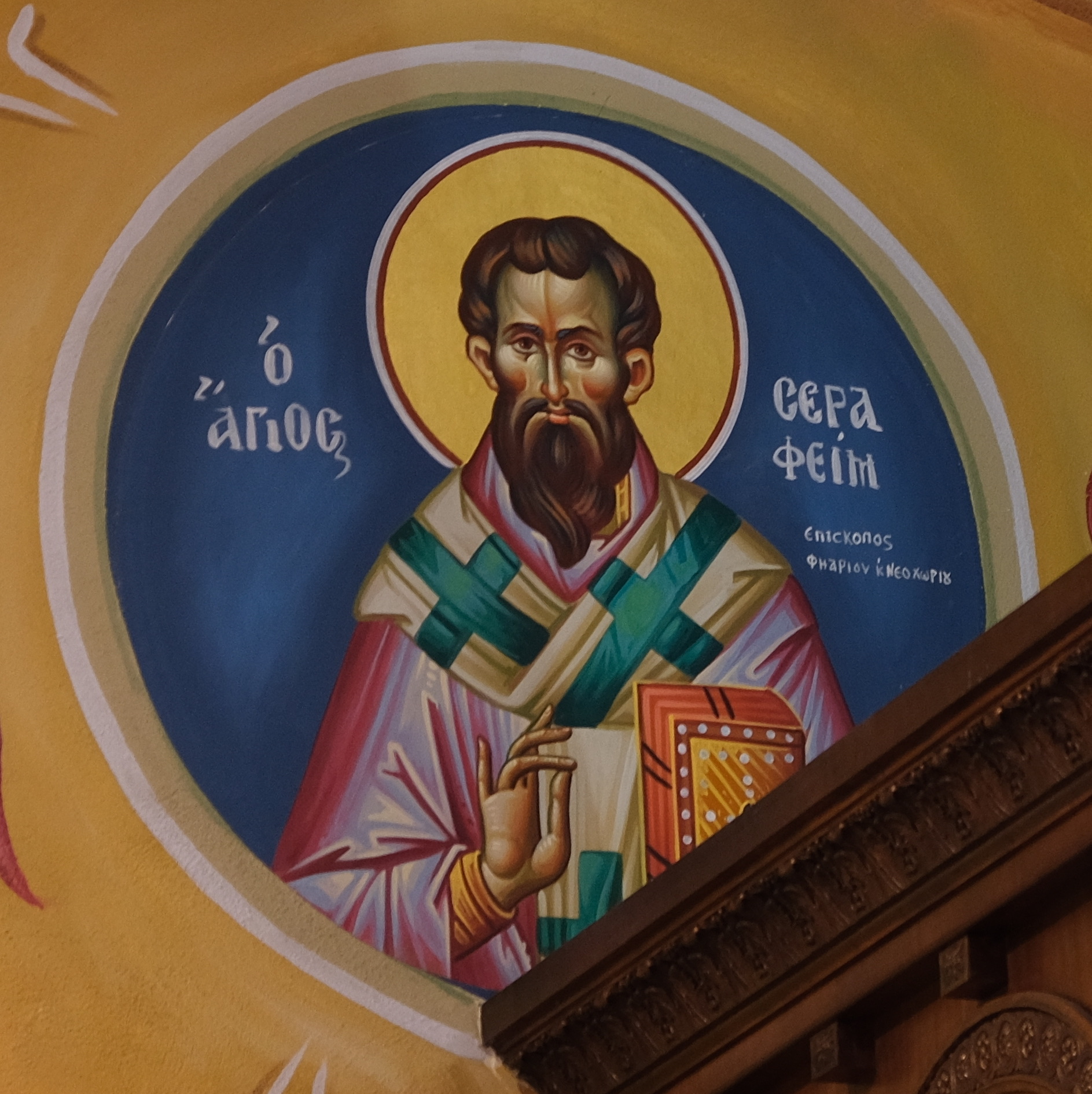
May 6
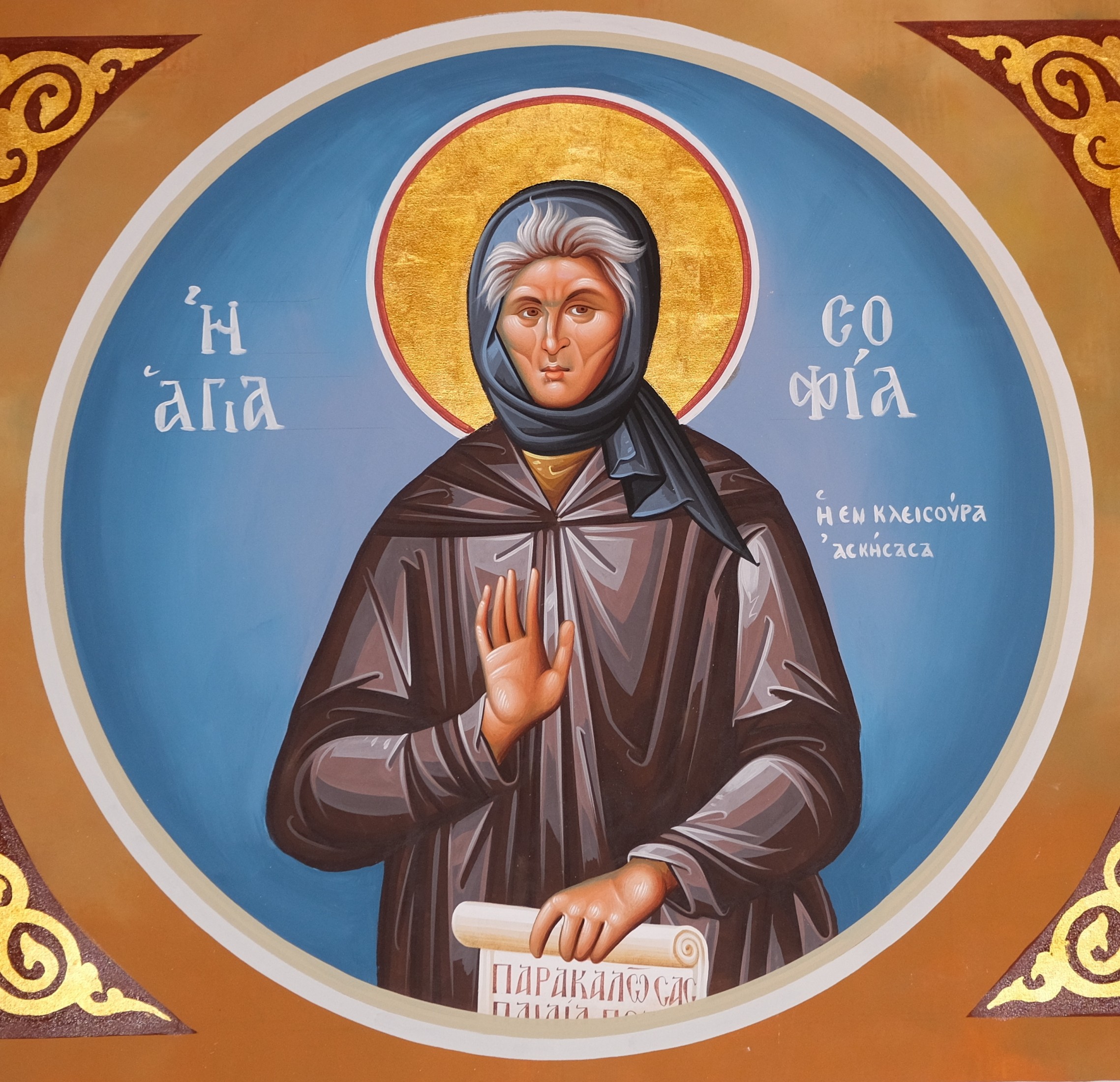
December 12
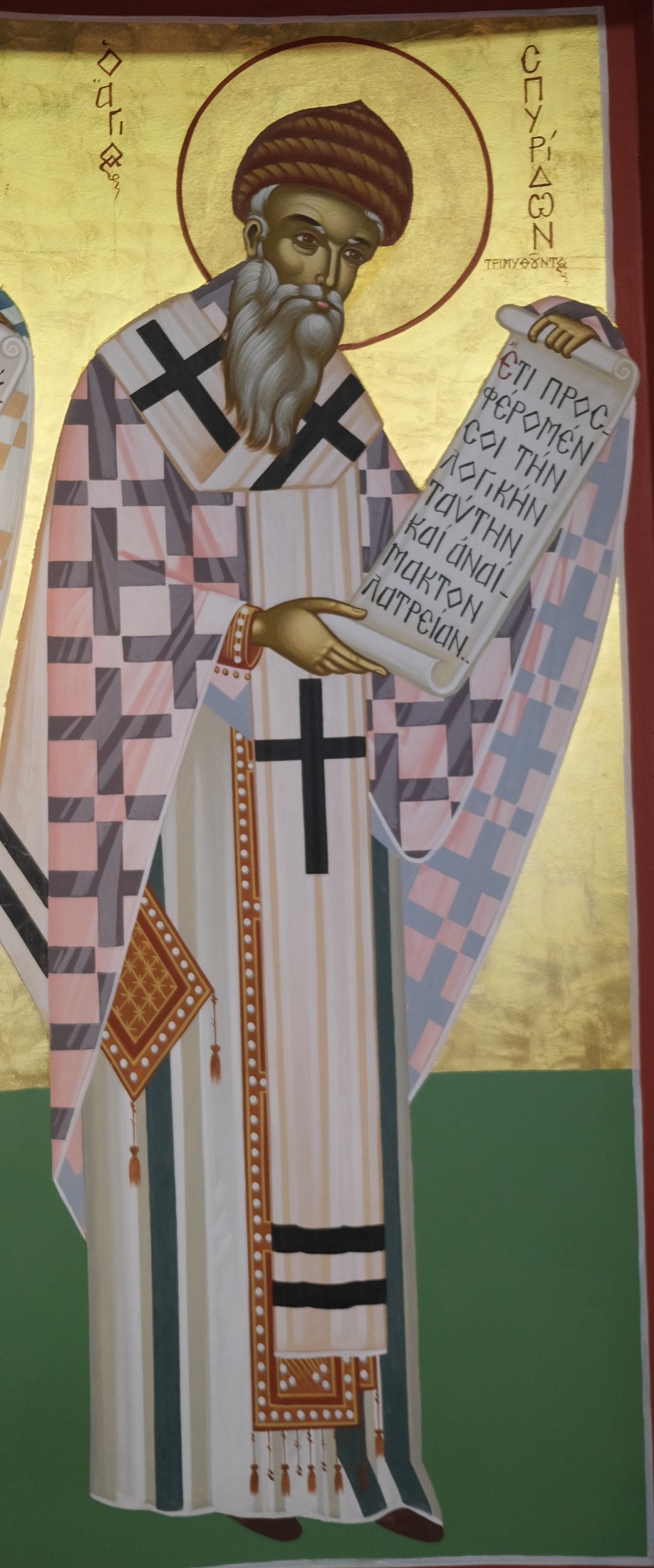
Spyridon, the God-bearing Father of the Church, the great defender of Corfu and the boast of all the Orthodox, had Cyprus as his homeland. He was simple in manner and humble of heart, and was a shepherd of sheep. When he was joined to a wife, he begat of her a daughter whom they named Irene. After his wife's departure from this life, he was appointed Bishop of Trimythus, and thus he became also a shepherd of rational sheep. When the First Ecumenical Council was assembled in Nicaea, he also was present, and by means of his most simple words stopped the mouths of the Arians who were wise in their own conceit. By the divine grace which dwelt in him, he wrought such great wonders that he received the surname 'Wonderworker." So it is that, having tended his flock piously and in a manner pleasing to God, he reposed in the Lord about the year 350, leaving to his country his sacred relics as a consolation and source of healing for the faithful. Learn More
[Greek Orthodox Archdiocese of America - July 5]
Feburary 17
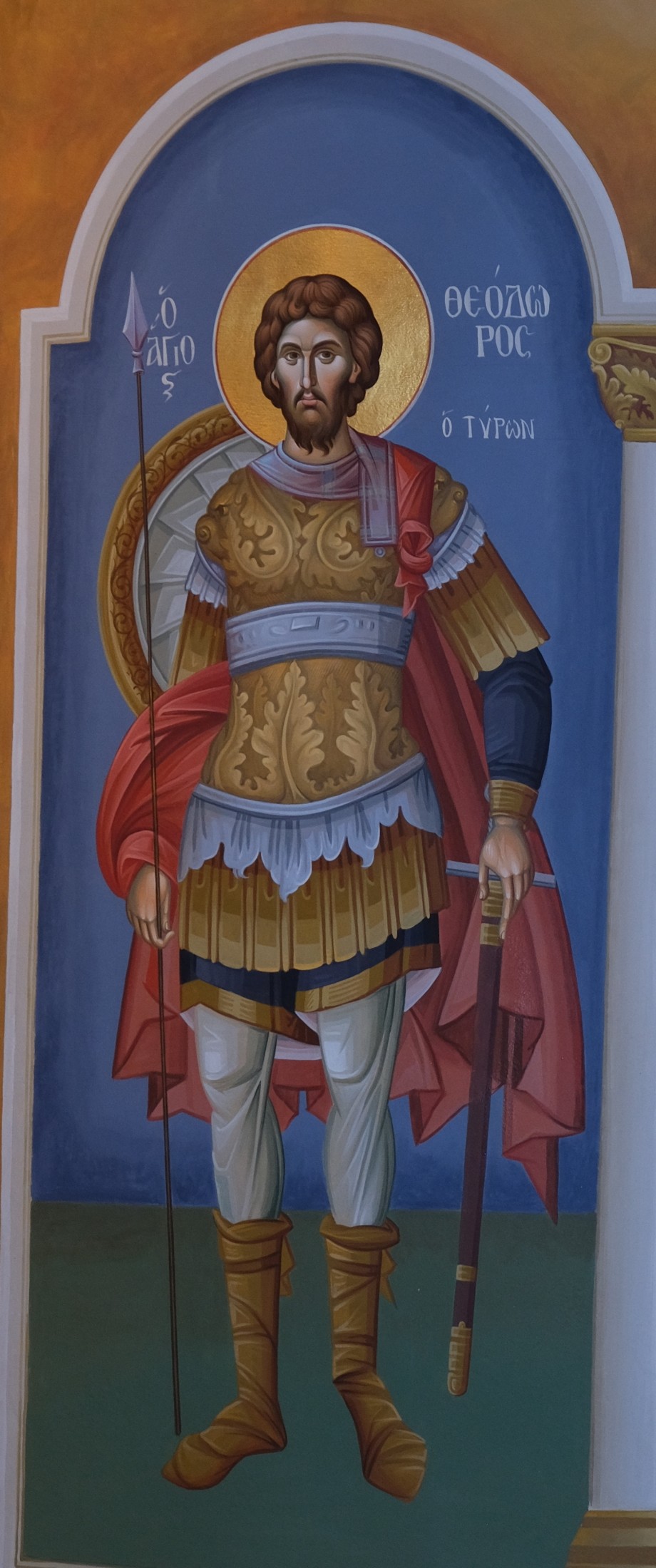
Saint Theodore who was from Amasia of Pontus, contested during the reign of Maximian (286-305). He was called Tyro, from the Latin Tiro, because he was a newly enlisted recruit. When it was reported that he was a Christian, he boldly confessed Christ; the ruler, hoping that he would repent, gave him time to consider the matter more completely and then give answer. Theodore gave answer by setting fire to the temple of Cybele, the "mother of the gods," and for this he suffered a martyr's death by fire. See also the First Saturday of the Fast. Learn More
[Greek Orthodox Archdiocese of America - July 5]
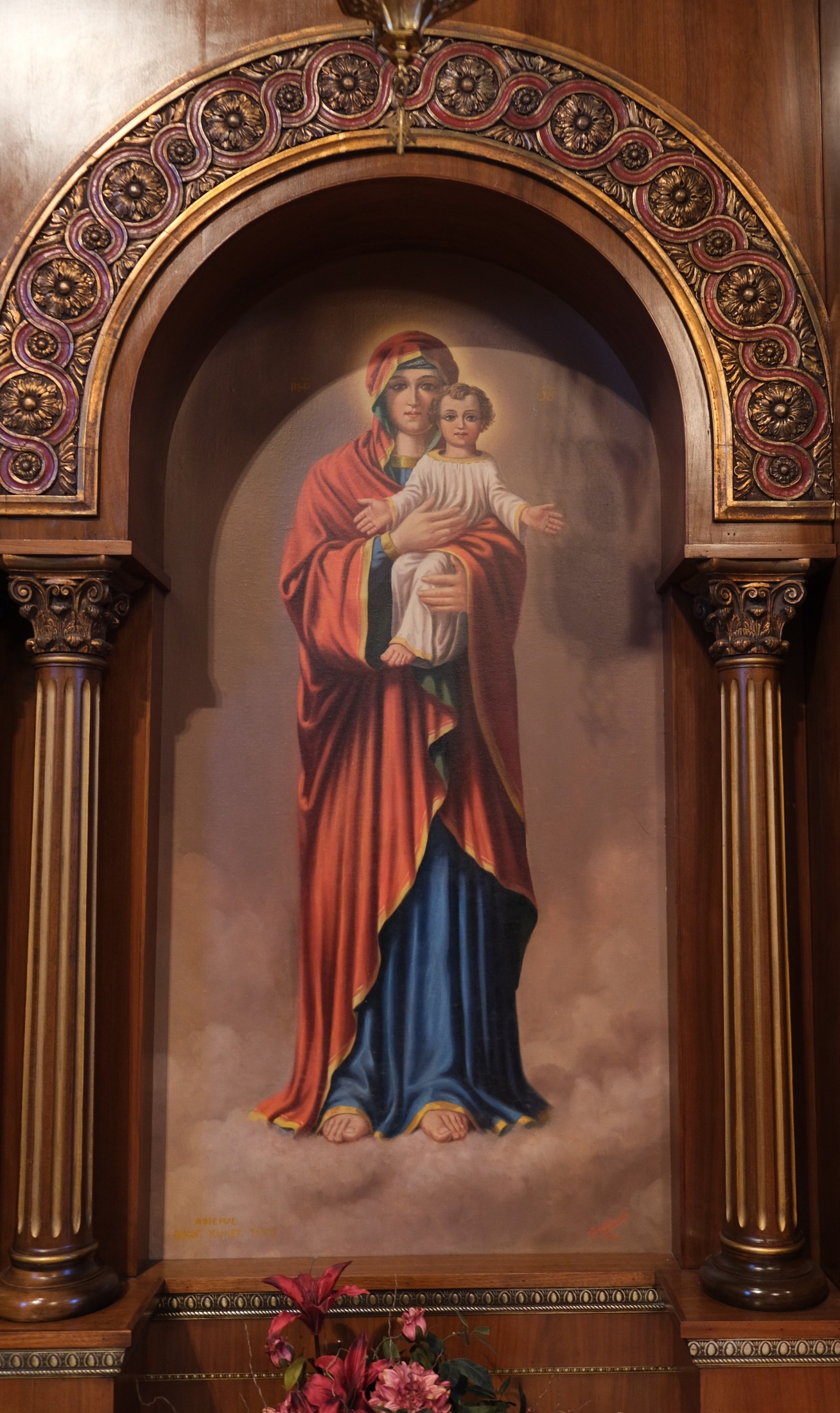
God, Who is Love, as Saint John the Theologian writes, created all things out of that love. He created the heavens, the stars, the planets, including this Earth, and all life existing therein. Today with our expanded scientific achievements we behold much more of His creation than ever before with the use of increasingly powerful telescopes and reflectors. We witness billions of galaxies that appear to be expanding. Our imaginations, moreover, run wild in projecting the possibility and the probability of the existence of other intellectual creatures, humanoids, if you will, in other places of the heavens. We see the portrayal of our fantasies as the movie industry depicts various life forms in other galaxies and the representation of warring creatures battling between the forces of good and evil among the stars. Read More
[Metropolitan Isaiah of Denver (1999) - July 4]
The Church building inside is symbolic of the Universe and is always oriented from east to west, with the altar towards the east.
The main areas of the church are similar to those of Solomon's Temple: the narthex assumes the role of the courtyard, the nave is the temple proper, while the altar represents the Holy of Holies. The nave is separated from the altar area by an icon wall called the Iconostasis.
[Annunciation Greek Orthodox Church of Winston Salem, NC: Greek Festival Church Tour Brochure - May 14]
Narthex, or vestibule, represents the fallen world in which man is called to repentance. Passing from the narthex into the nave symbolizes the Christian's entrance into the kingdom of heaven. In the narthex are a number of special items:
[Annunciation Greek Orthodox Church of Winston Salem, NC: Greek Festival Church Tour Brochure - May 14]
(Lighting a Candle in the Orthodox Faith)
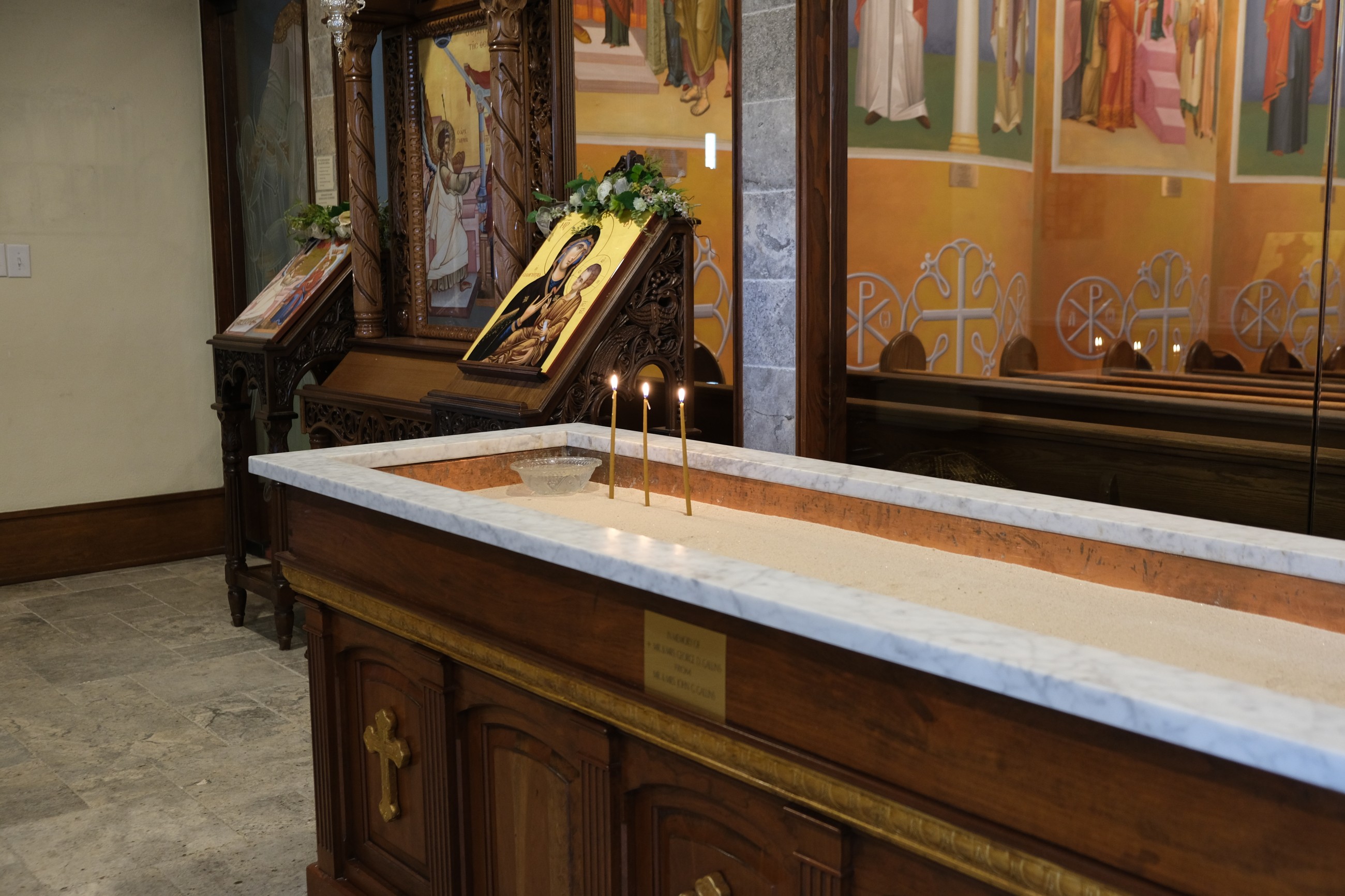
The table where candles are kept. As a personal devotion, Orthodox Christians typically take a candle as they enter the Church, make a small donation as a gift, and light the candle while saying a prayer. Making the sign of the Cross, they place the candle in the sand. The flame of the candles symbolizes the light of Christ that casts out darkness and reminds the faithful that they too should burn with love for Our Lord.
[Annunciation Greek Orthodox Church of Winston Salem, NC: Greek Festival Church Tour Brochure - May 14]
(Icon Stands)
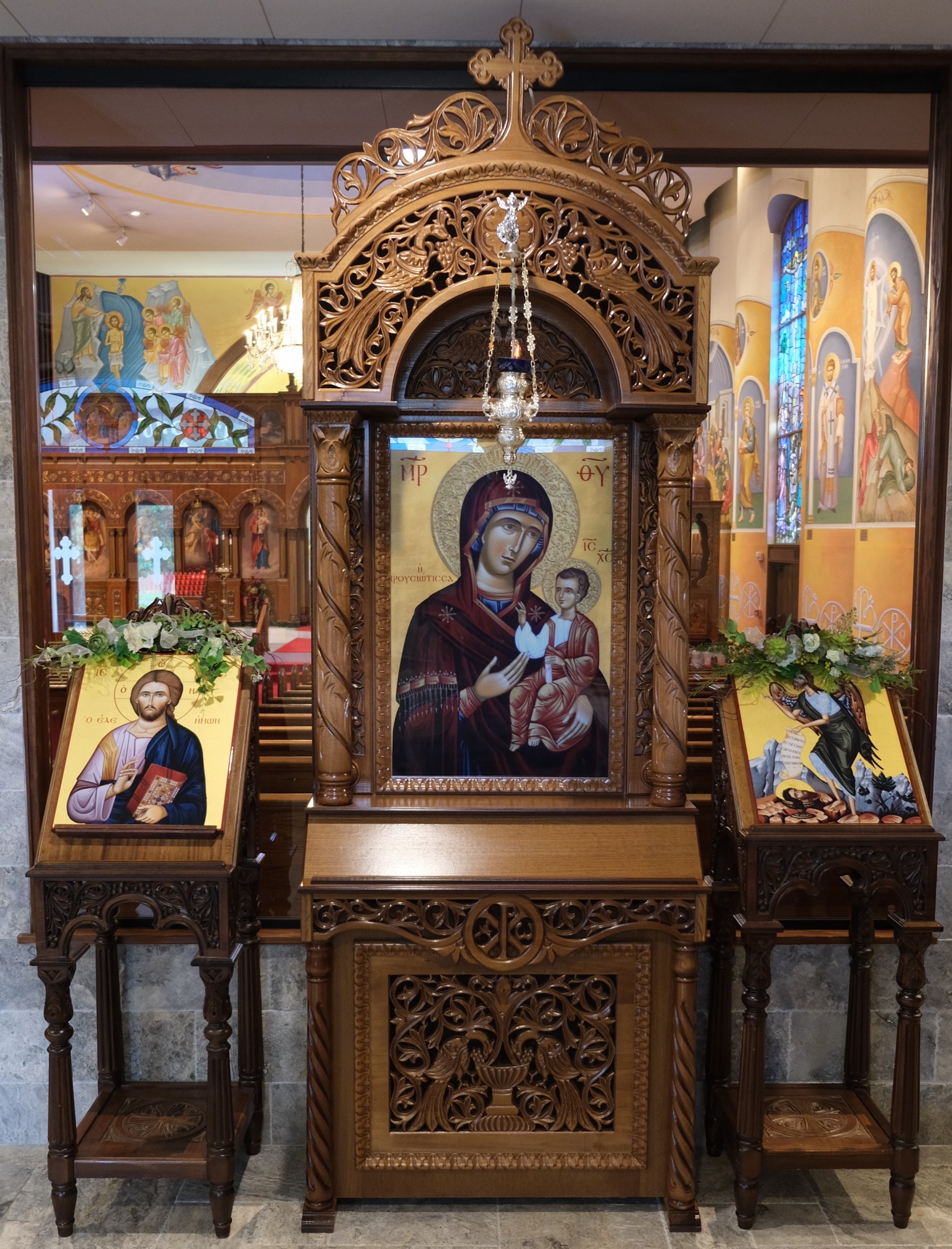
From the verb “proscino” which means to bow and kiss with reverence. These elaborate wooden stands are used to hold holy images (icons) that are venerated (i.e.- shown honor) by the faithful.
[Annunciation Greek Orthodox Church of Winston Salem, NC: Greek Festival Church Tour Brochure - May 14]
Coming Soon
The Nave is the largest area of the Church edifice, the word is taken from the Latin for “belly of a ship." Early Christians considered the Church to be a ship, an Ark of Salvation, which carries the Faithful toward the Kingdom of God. The ceiling represents heaven, and often has a dome, which is the symbolic link between earth and heaven. Christ Almighty (“Pantokrator” in Greek) is depicted, looking down from heaven onto to the assembled congregation. The interior of the Orthodox Church is designed to elevate the worshipper's mind to heaven. Through the Gospel readings, hymns, incense, architecture, and icons, the minds and hearts of the faithful are brought closer to God. Within the nave, you will see the following:
[Annunciation Greek Orthodox Church of Winston Salem, NC: Greek Festival Church Tour Brochure - May 14]
(All Powerful)

Moving forward, you will be directly under the icon of Christ on the ceiling. This icon is standard in all Orthodox Churches, depicting Christ in all of His divine glory. No matter where you stand in the Church building, the eyes of Christ are always looking at you, reminding us of God's omnipresence. The Greek letters “ώ Ό Ν” surrounding the Lord's head stand for “He who is,” a reference to Christ's divinity. Also around Christ's head are the letters “IC” and “XC” commonly used to abbreviate the name of Jesus (IHCOYC ”Isous”) Christ (XPICTOC “Christos”).
[Annunciation Greek Orthodox Church of Winston Salem, NC: Greek Festival Church Tour Brochure - May 14]

The raised platform at the eastern end of the nave represents a spiritual bridge linking earth (the nave) to heaven (the sanctuary). Here you will see:
(Wall of icons)
Directly in front of you is an icon wall separating the altar from the nave. It can be traced back to the veil of the temple, torn in two as the Lord Jesus Christ died on the Cross. There are three entrances: two deacon doors on the sides and the center entrance, called the Royal Doors. The first two icons to the left and to the right of the center door are always in the following order (L to R):
Icons on wall above Iconostasis: (L to R):
[Annunciation Greek Orthodox Church of Winston Salem, NC: Greek Festival Church Tour Brochure - May 14]
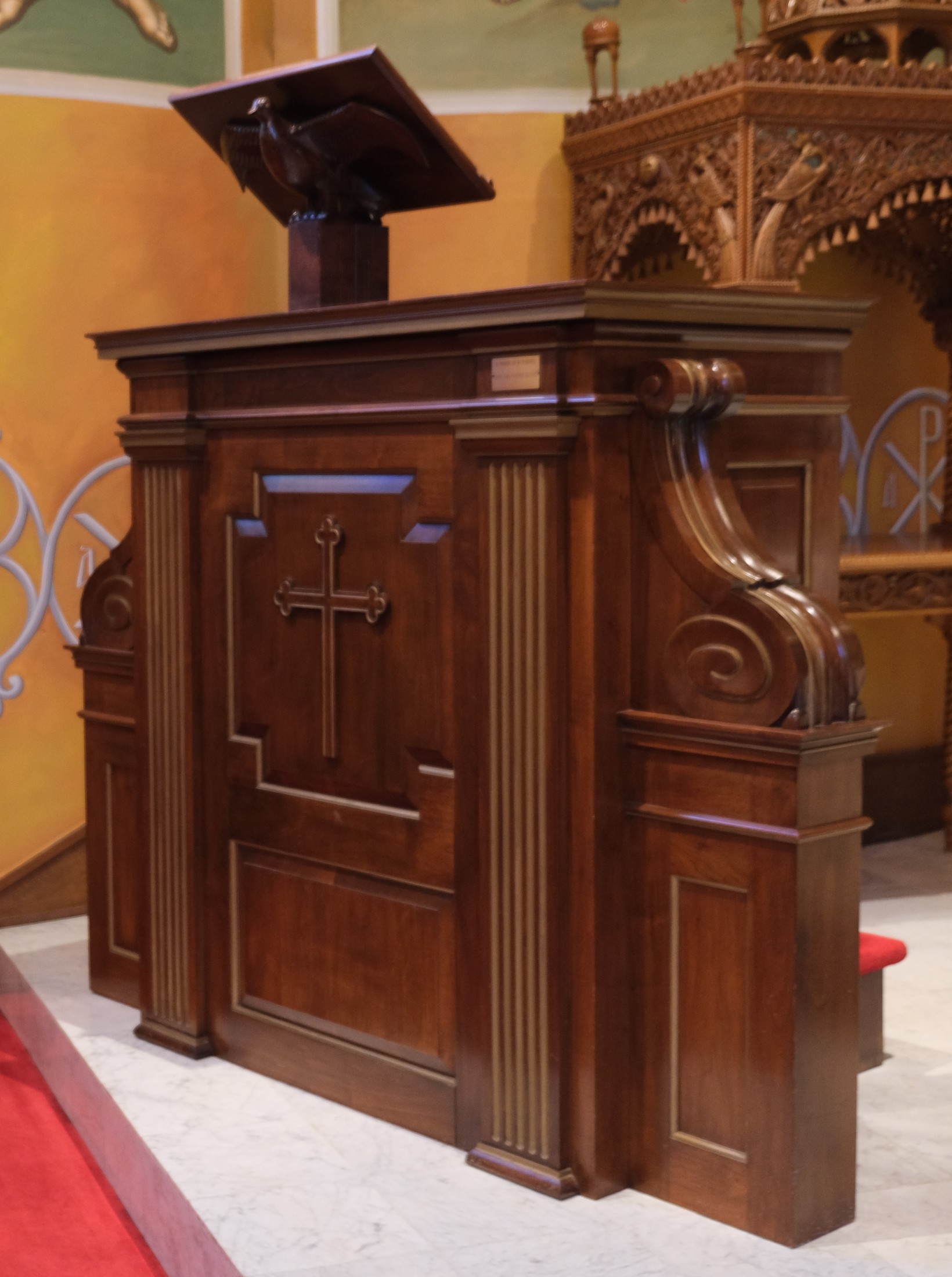
Symbolizes the stone which sealed the entrance of the tomb of Jesus. As the angel, seated upon the stone, brought tidings of the Resurrection to the myrrhbearing women, so is the pulpit used for the reading and preaching of God's Word, which is contained in the Gospels.
[Annunciation Greek Orthodox Church of Winston Salem, NC: Greek Festival Church Tour Brochure - May 14]
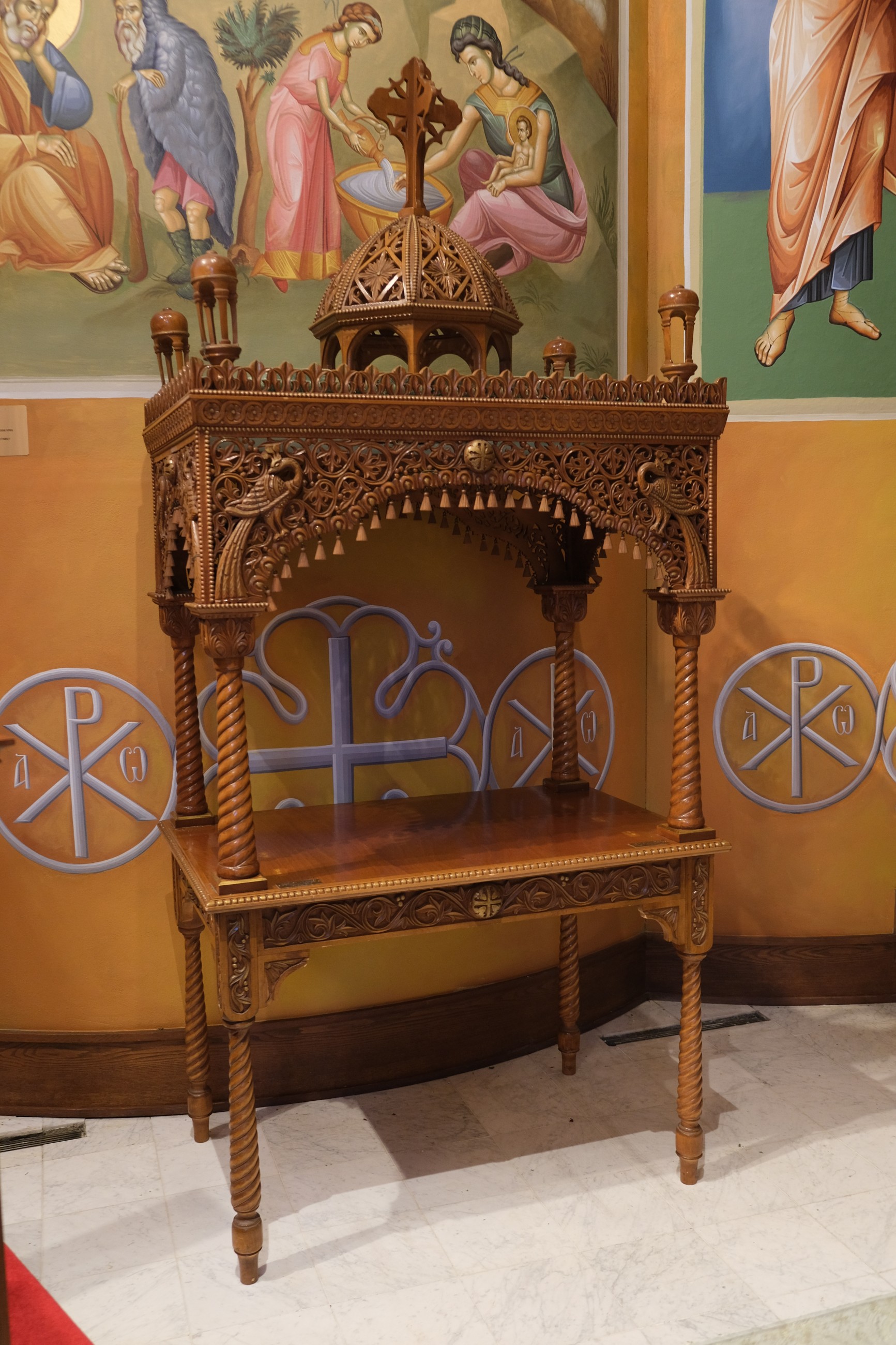
An elaborate piece of furniture that represents the Savior's tomb It is used on Good Friday to house the Epitaphios (not displayed), a velvet and gold shroud depicting our Lord lying in the tomb.
[Annunciation Greek Orthodox Church of Winston Salem, NC: Greek Festival Church Tour Brochure - May 14]
(Psalterion)
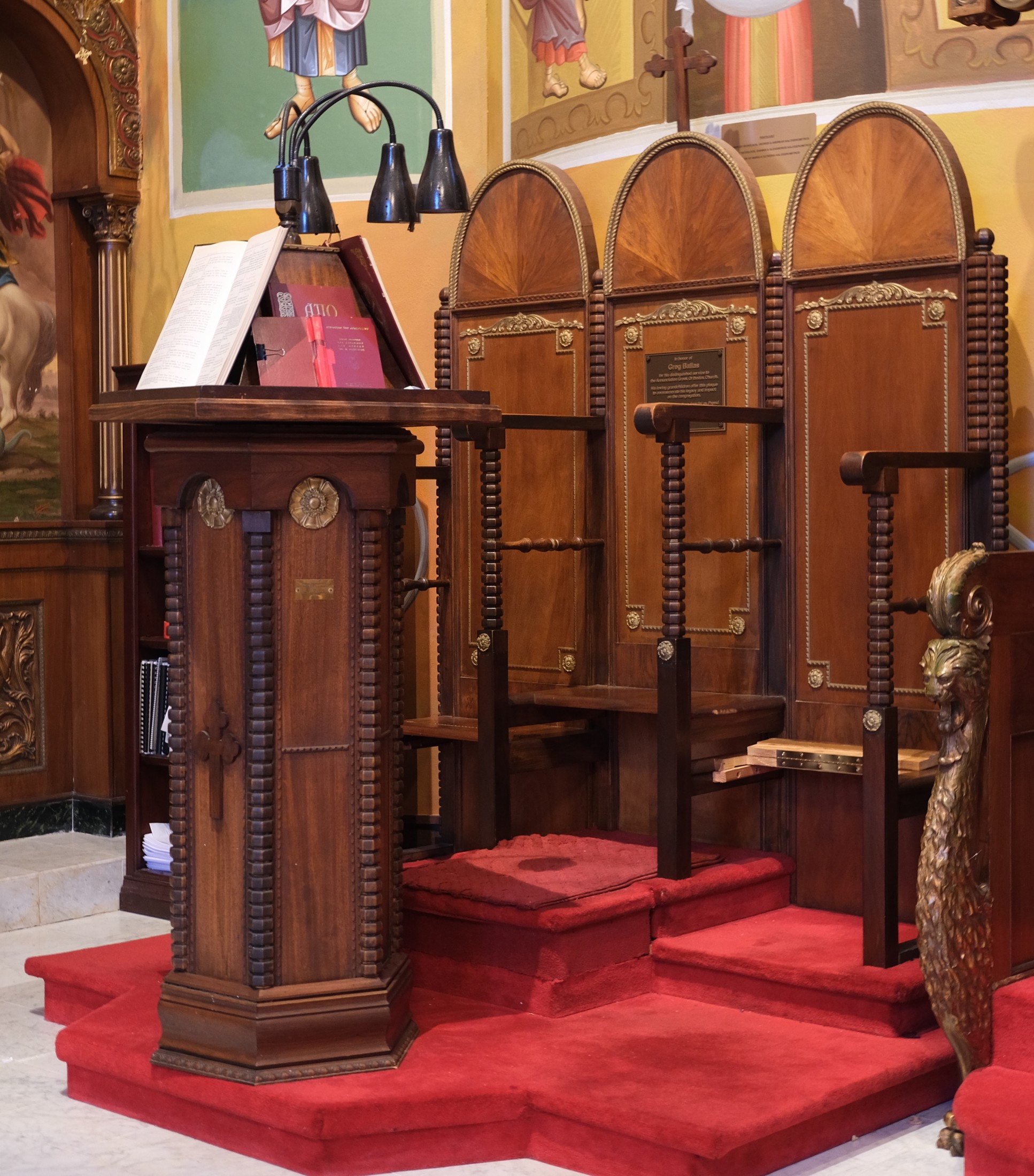
Where the chanters stand and sing Psalms, hymns, and the responses to the clergy throughout the worship services.
[Annunciation Greek Orthodox Church of Winston Salem, NC: Greek Festival Church Tour Brochure - May 14]
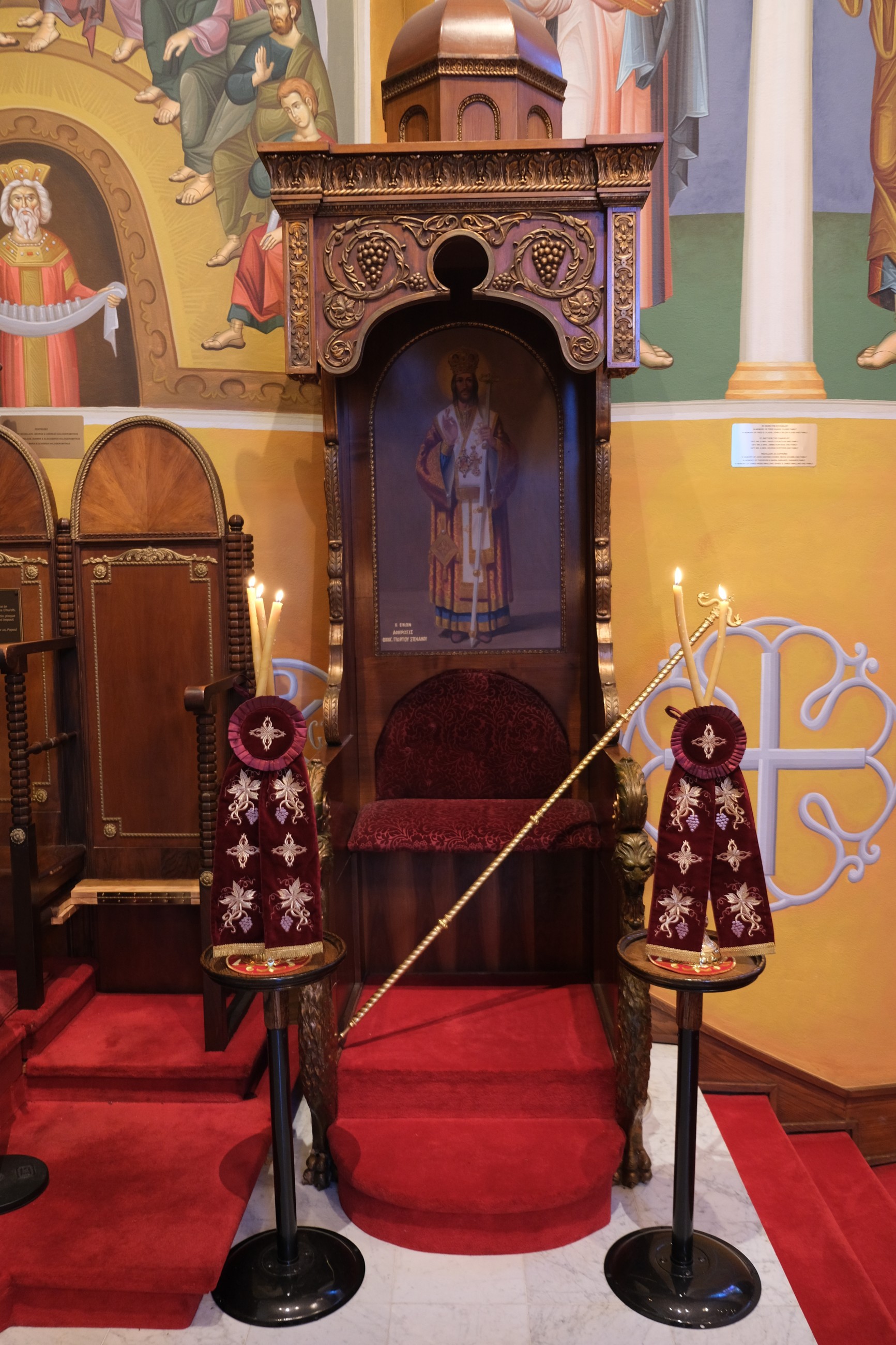
Set aside for the bishop or archbishop. Our bishop is Metropolitan Alexios of Atlanta. The throne is usually made of carved wood and is set on the right side of the Solea. In ancient times, it was used to seat the Byzantine Emperor (of the Eastern Roman Empire). It has an icon of Christ, reminding us that Our Lord is the Head of the Church and His representative is the bishop.
[Annunciation Greek Orthodox Church of Winston Salem, NC: Greek Festival Church Tour Brochure - May 14]
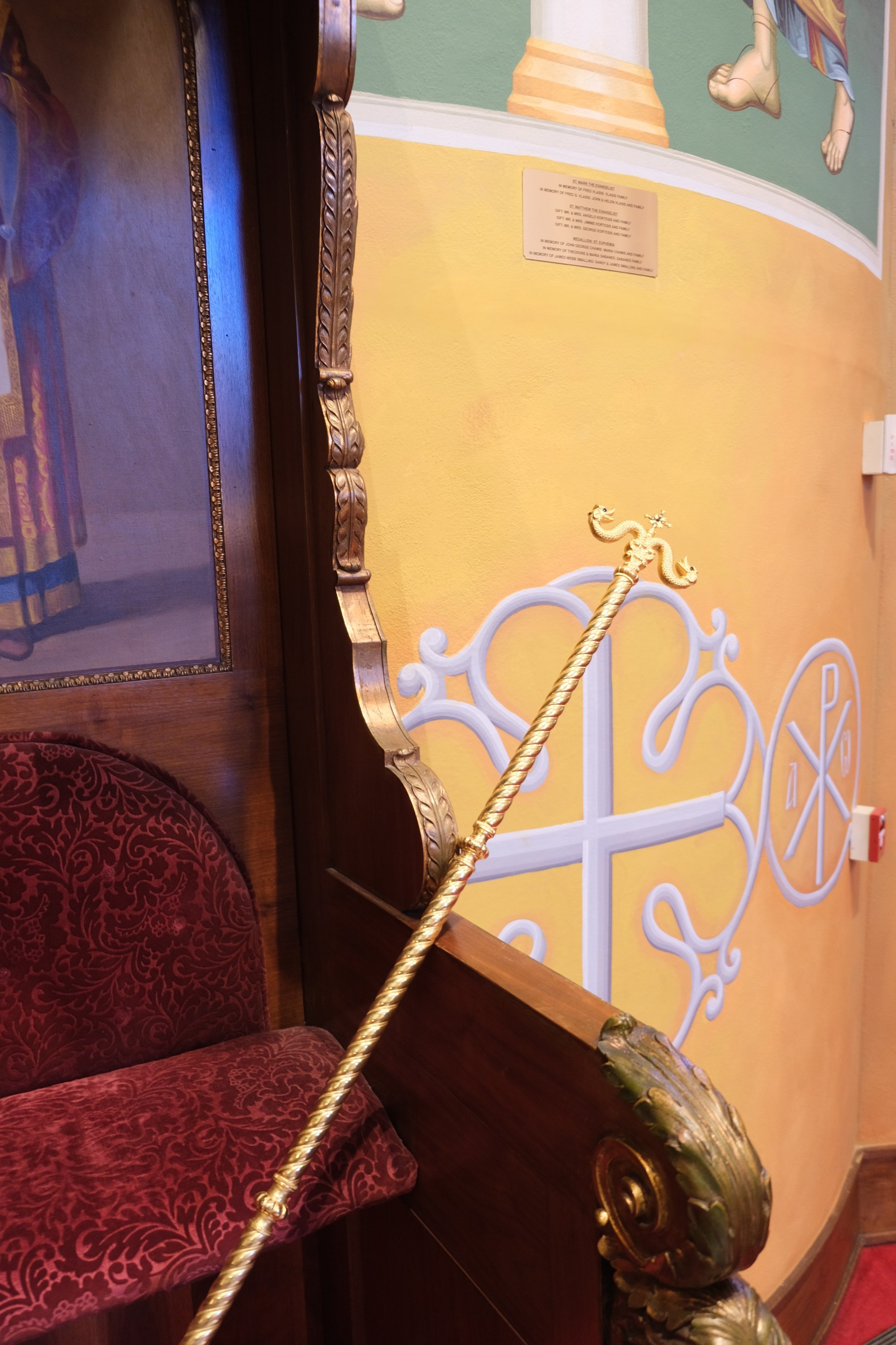
A symbol of the fact that the Bishop represents Christ the Shepherd of the Christian Flock.
[Annunciation Greek Orthodox Church of Winston Salem, NC: Greek Festival Church Tour Brochure - May 14]
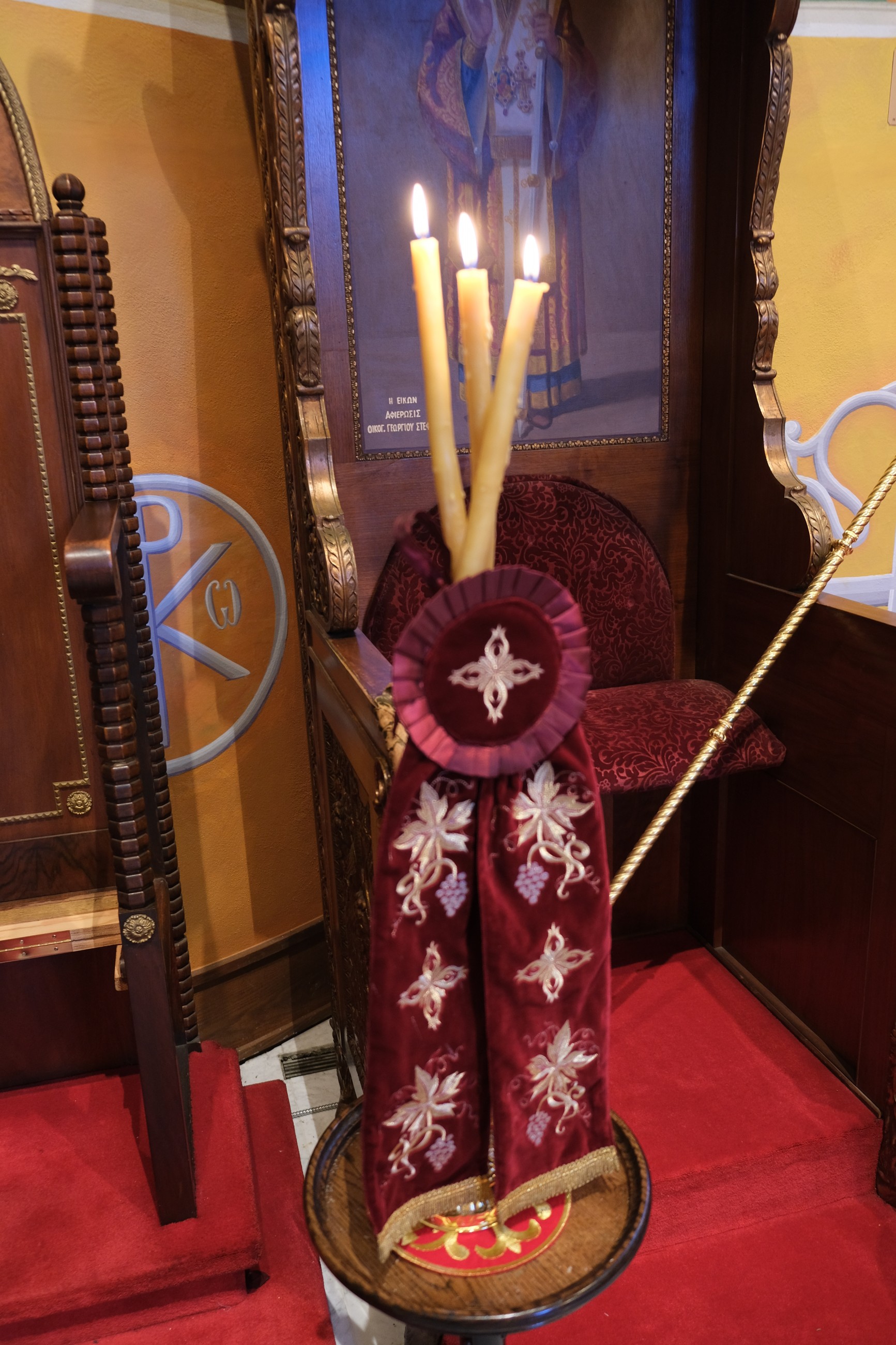
Used by the Bishop during services. The three candles represent the HOLY TRINITY.
[Annunciation Greek Orthodox Church of Winston Salem, NC: Greek Festival Church Tour Brochure - May 14]
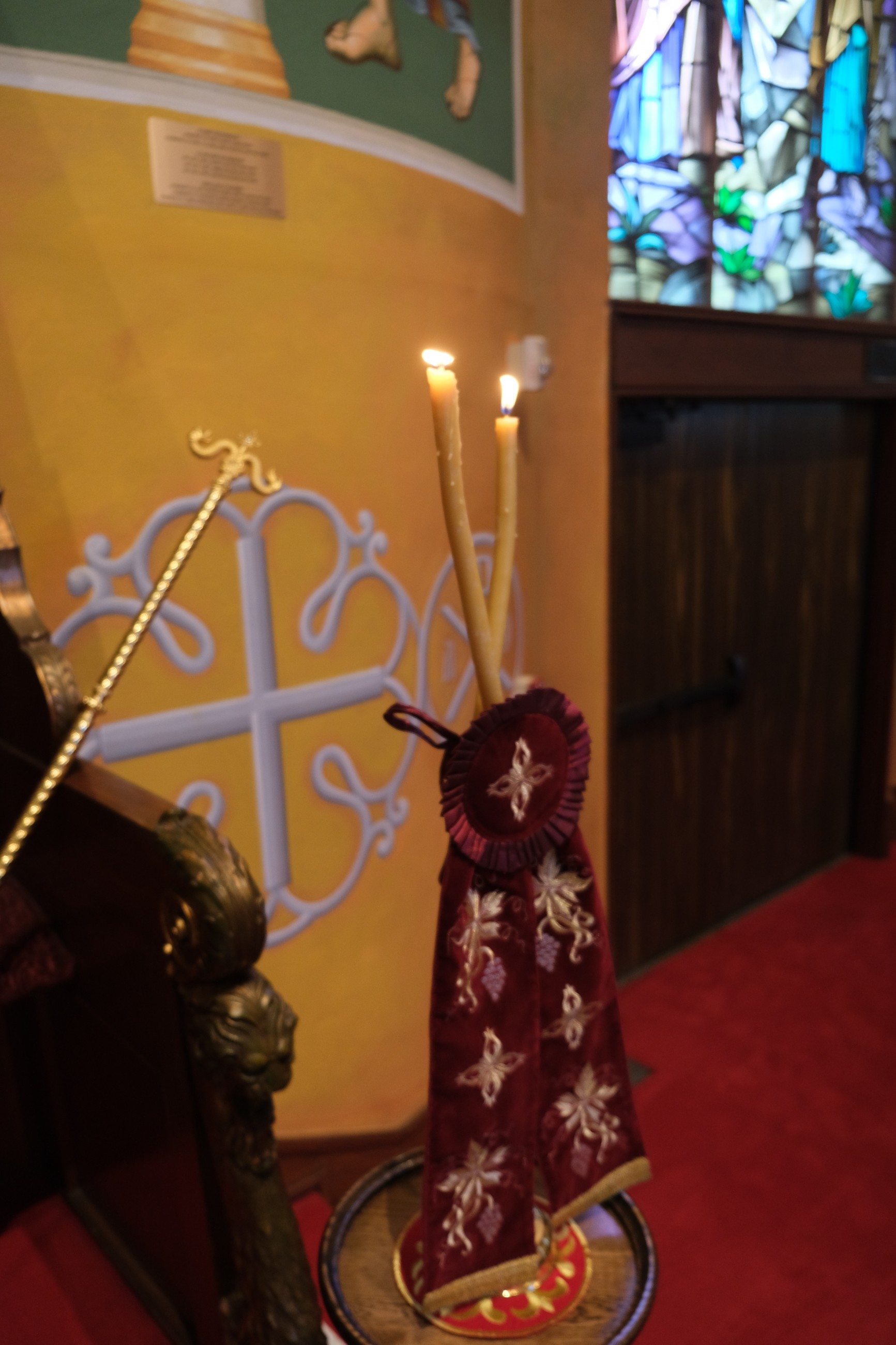
Used by the Bishop during services. The two candles represent the two natures of Christ, DIVINE and HUMAN.
[Annunciation Greek Orthodox Church of Winston Salem, NC: Greek Festival Church Tour Brochure - May 14]
The Sanctuary, or Altar area, is always situated in the eastern end of the Church building and represents heaven (Christ will return from the east). Only ordained clergy and those who have been given a blessing to enter are permitted.
[Annunciation Greek Orthodox Church of Winston Salem, NC: Greek Festival Church Tour Brochure - May 14]
(Prothesis)

A small altar to the left of the main Altar Table. Here the chalice and paten are kept, and the Eucharist is prepared prior to the Liturgy. An icon of the Nativity is along the back of the altar.
[Annunciation Greek Orthodox Church of Winston Salem, NC: Greek Festival Church Tour Brochure - May 14]
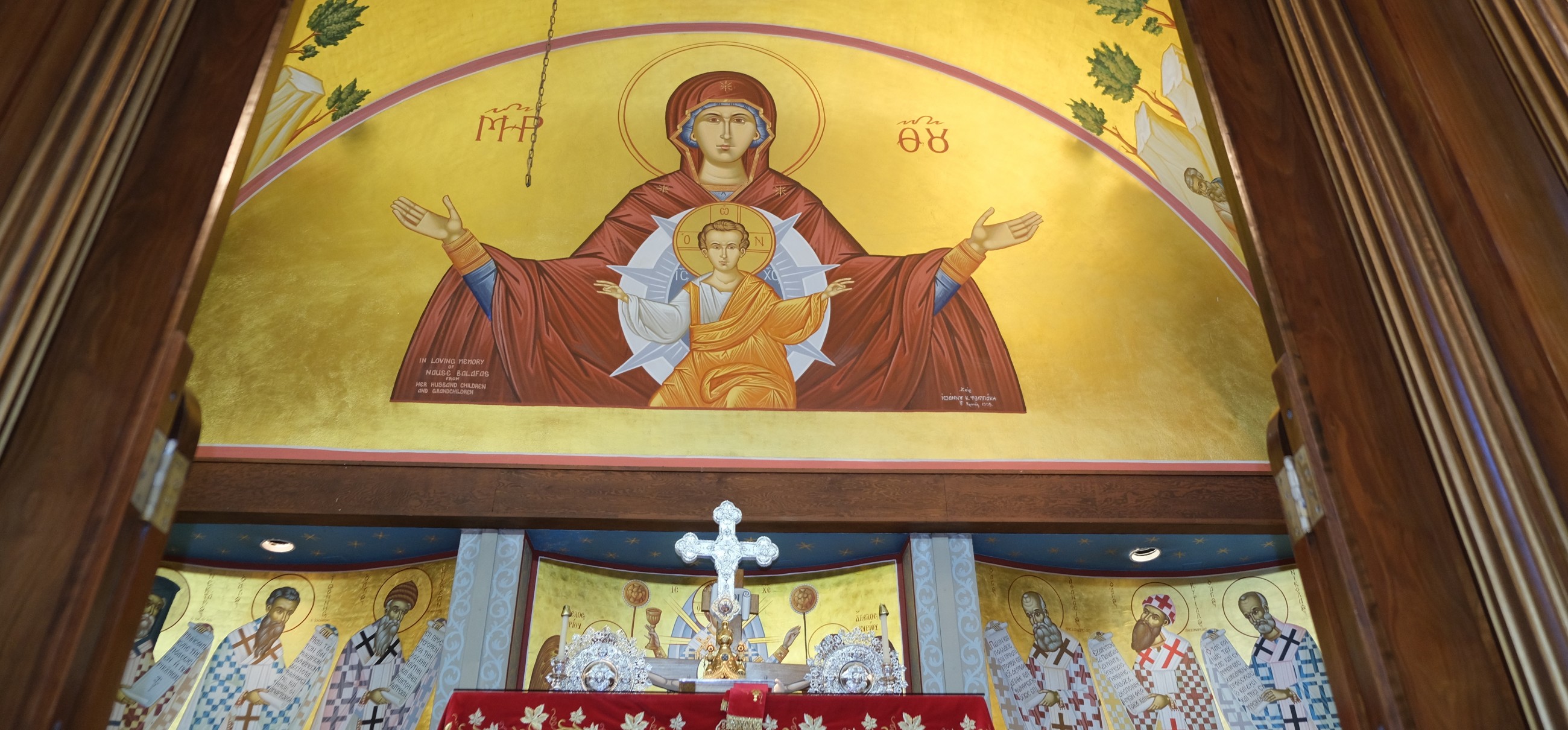
From the back of the Church, you can see the top portion of this large icon on the curved wall behind the altar, depicting the Virgin Mary holding the Christ Child. The word Platytera means “More Spacious Than The Heavens.” The Greek initials “MP ϴN” stand for “Mother of God.”
[Annunciation Greek Orthodox Church of Winston Salem, NC: Greek Festival Church Tour Brochure - May 14]

Enthroned constantly on the Holy Altar Table, where Christ is present as the Word of God in the Gospel Book and as the Bread of Life in the Tabernacle.
[Annunciation Greek Orthodox Church of Winston Salem, NC: Greek Festival Church Tour Brochure - May 14]

Used for the blessing of the faithful.
[Annunciation Greek Orthodox Church of Winston Salem, NC: Greek Festival Church Tour Brochure - May 14]
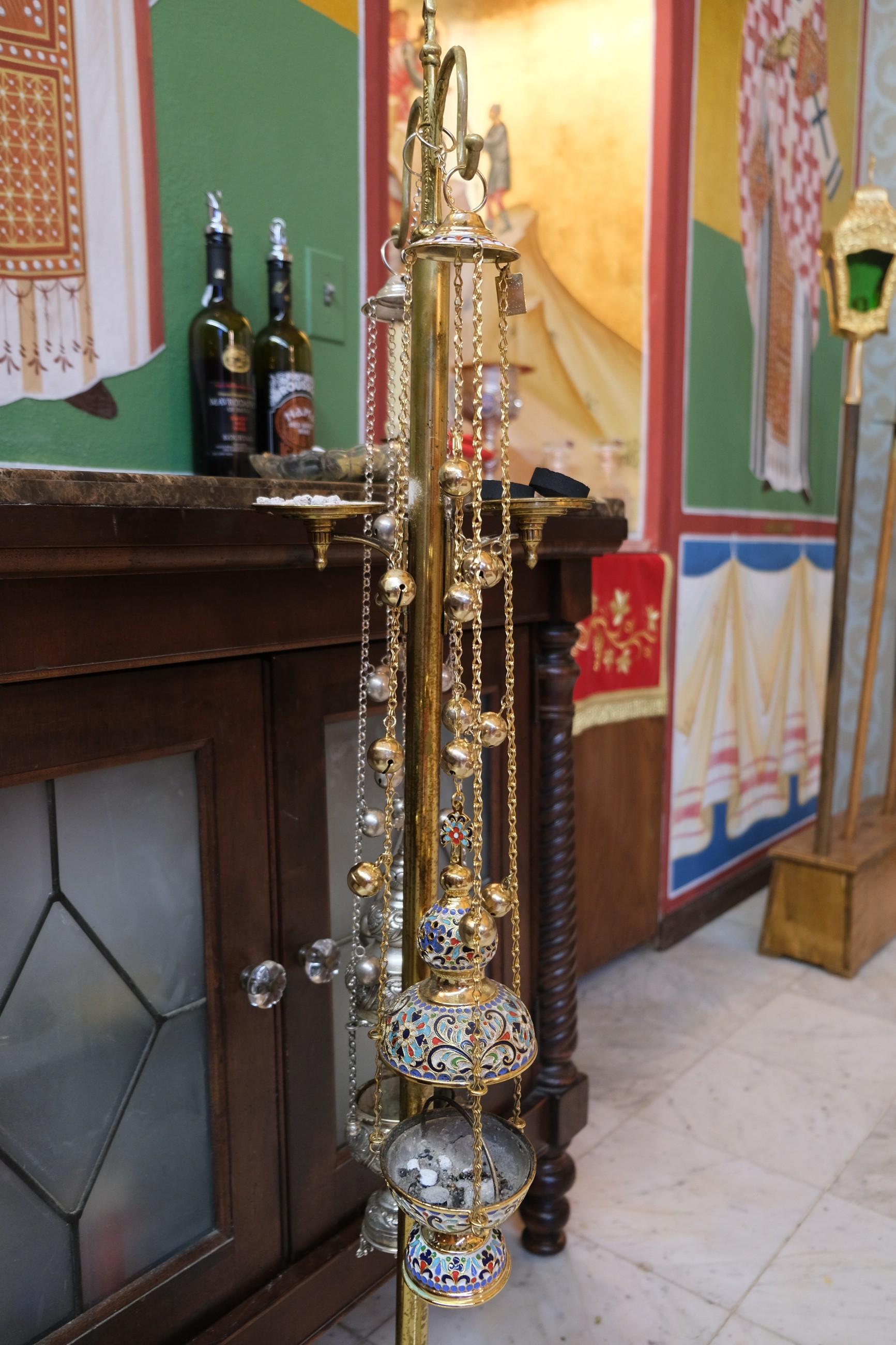
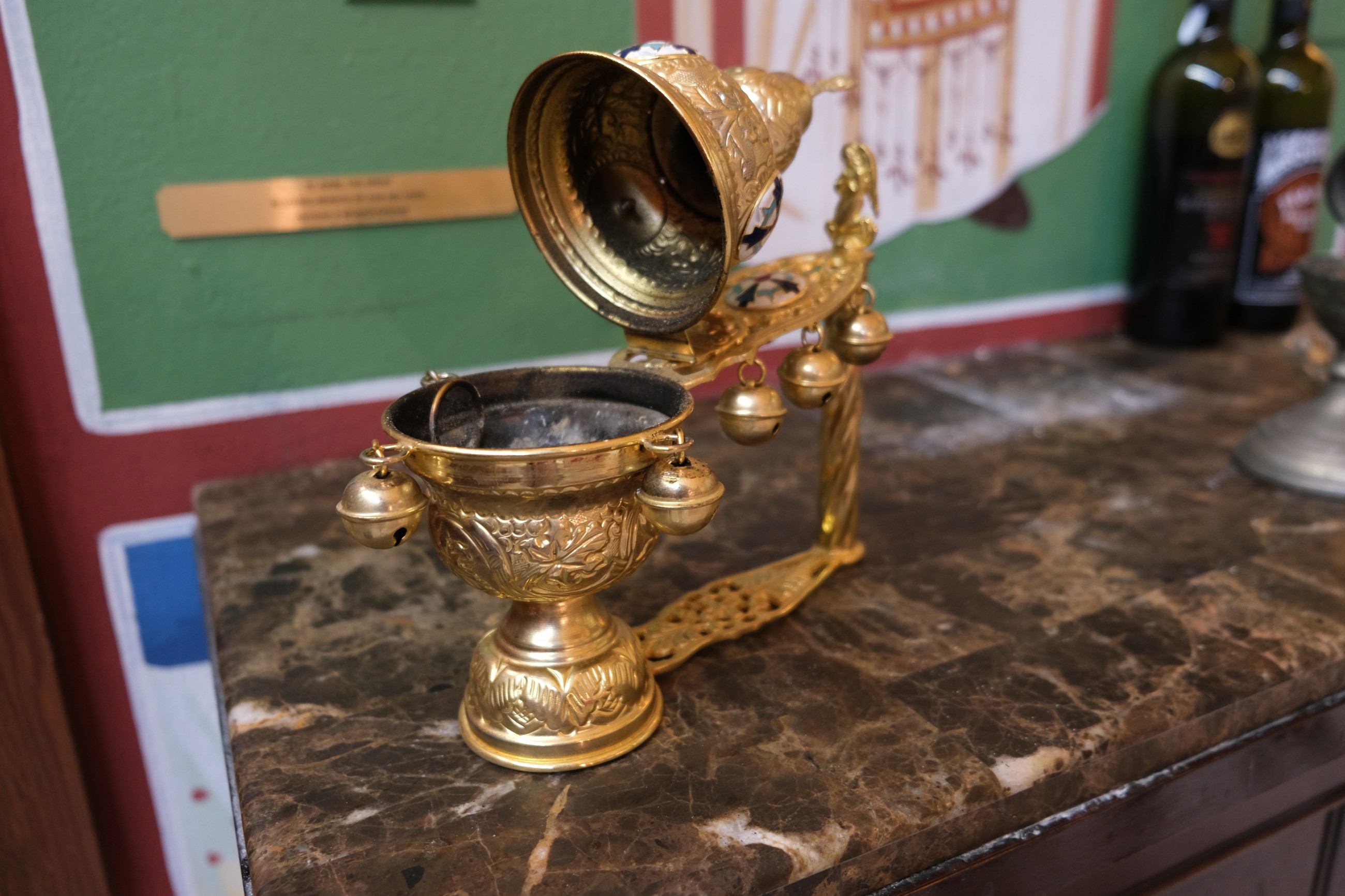
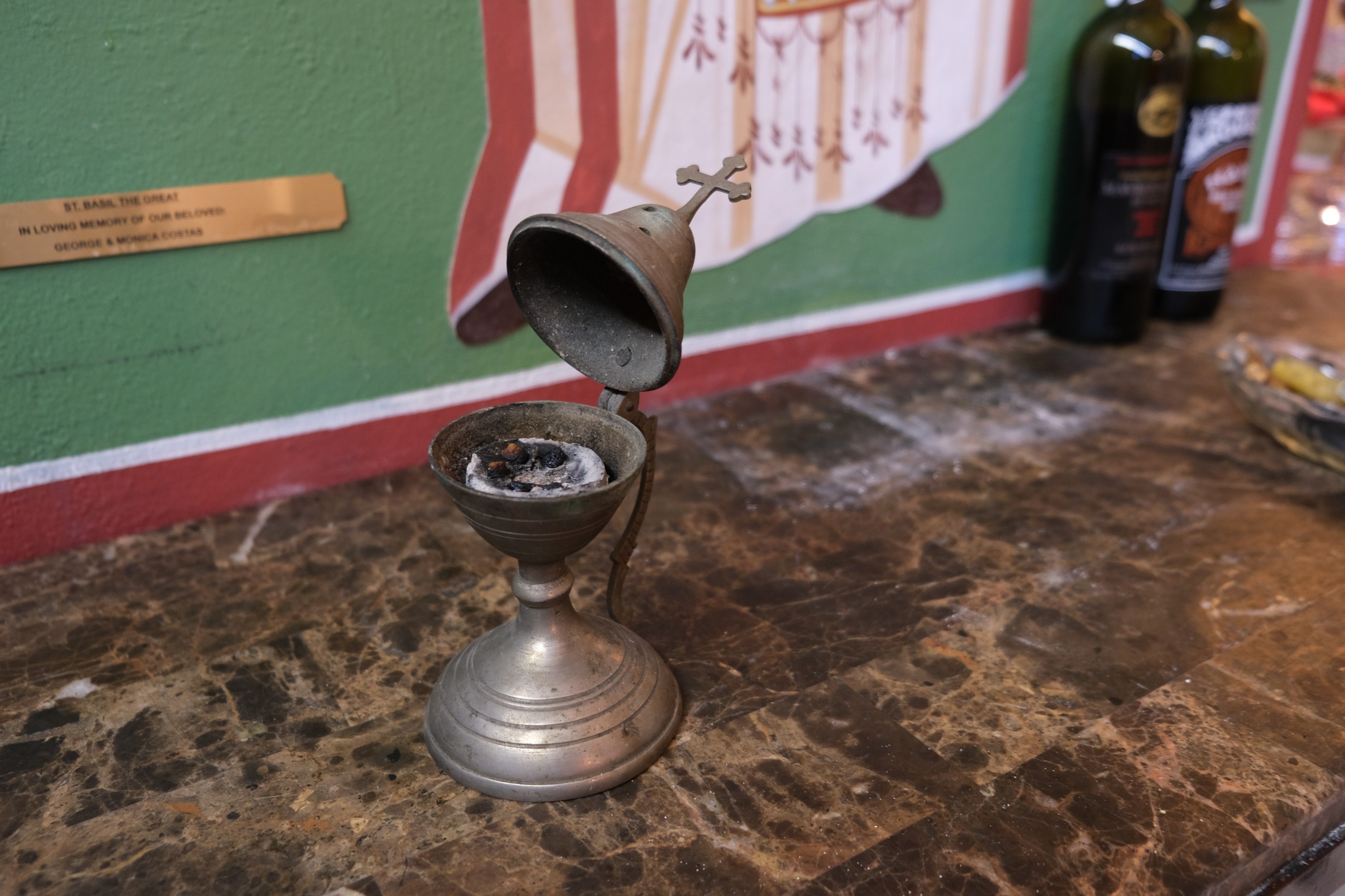
The charcoal is lit and incense is placed upon it. Traditionally, homes are censed on Saturday nights and on the eve and day of special feastdays.
[Annunciation Greek Orthodox Church of Winston Salem, NC: Greek Festival Church Tour Brochure - May 14]
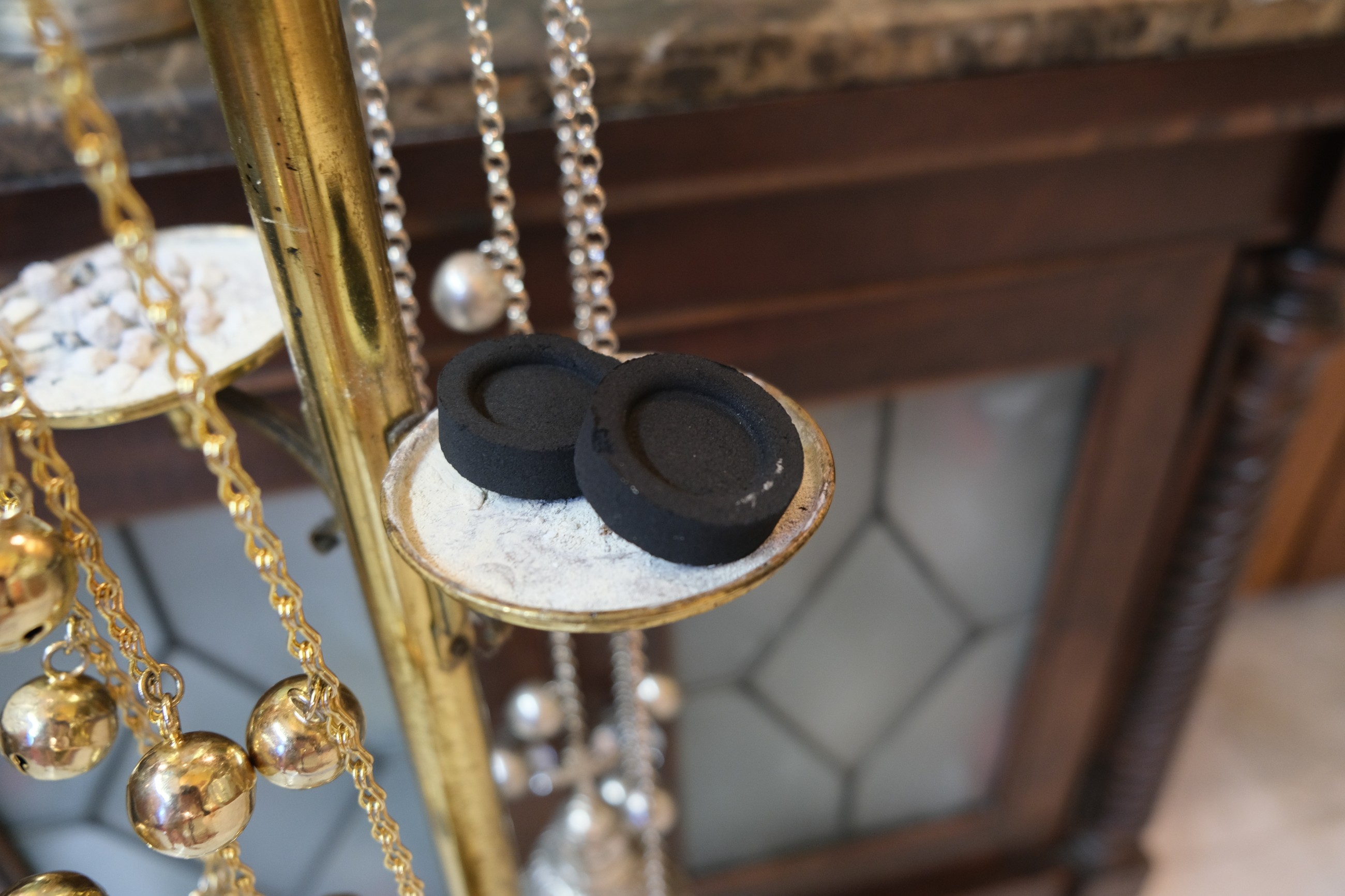
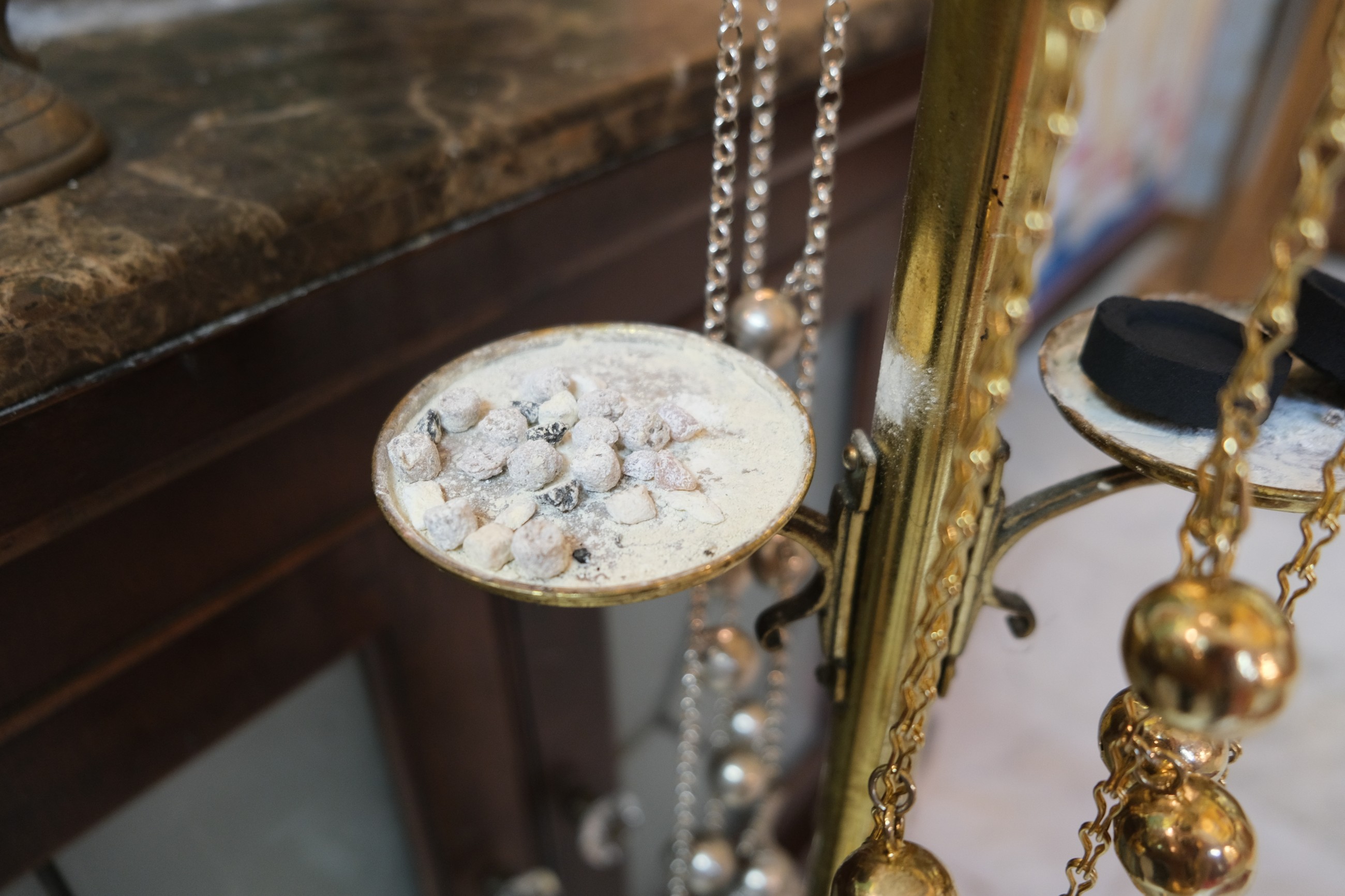
Sweet smelling pieces of incense are made from the fragrances of flowers such as the rose, honeysuckle and used in Services.
[Annunciation Greek Orthodox Church of Winston Salem, NC: Greek Festival Church Tour Brochure - May 14]

Placed upon the Altar for beautification; the seven lights represent the seven days of creation.
[Annunciation Greek Orthodox Church of Winston Salem, NC: Greek Festival Church Tour Brochure - May 14]
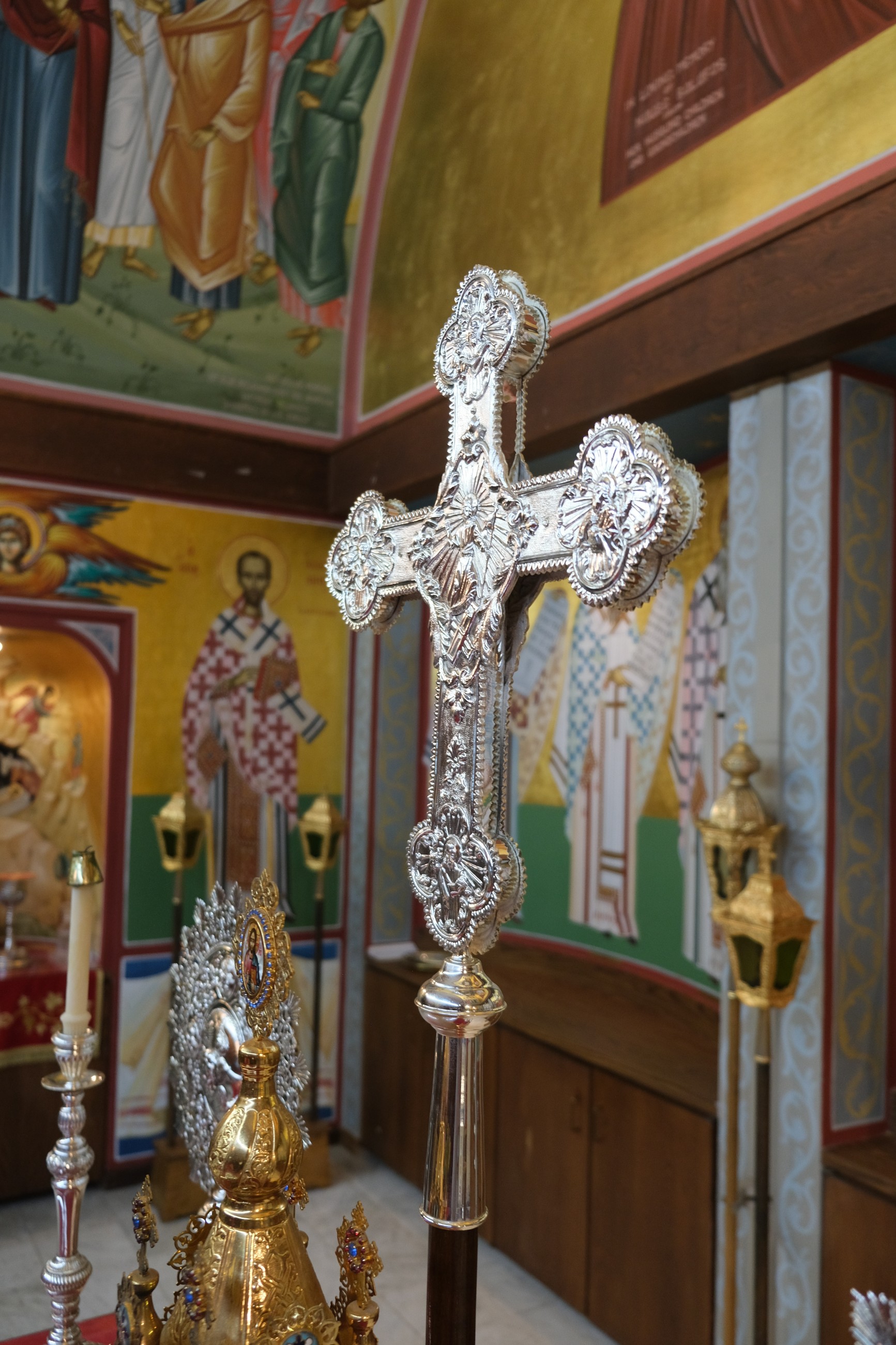
The cross with the corpus (body) of Christ on one side, and the Resurrected Christ on the other side for Sundays and the period following Pascha (the Christian Passover, aka “Easter” in the West) and before Pentecost. On the side with the Crucifix, the Greek initials on the sign above the Head of Christ, “INBI,” stand for “Jesus of Nazareth, King of the Jews.”
[Annunciation Greek Orthodox Church of Winston Salem, NC: Greek Festival Church Tour Brochure - May 14]
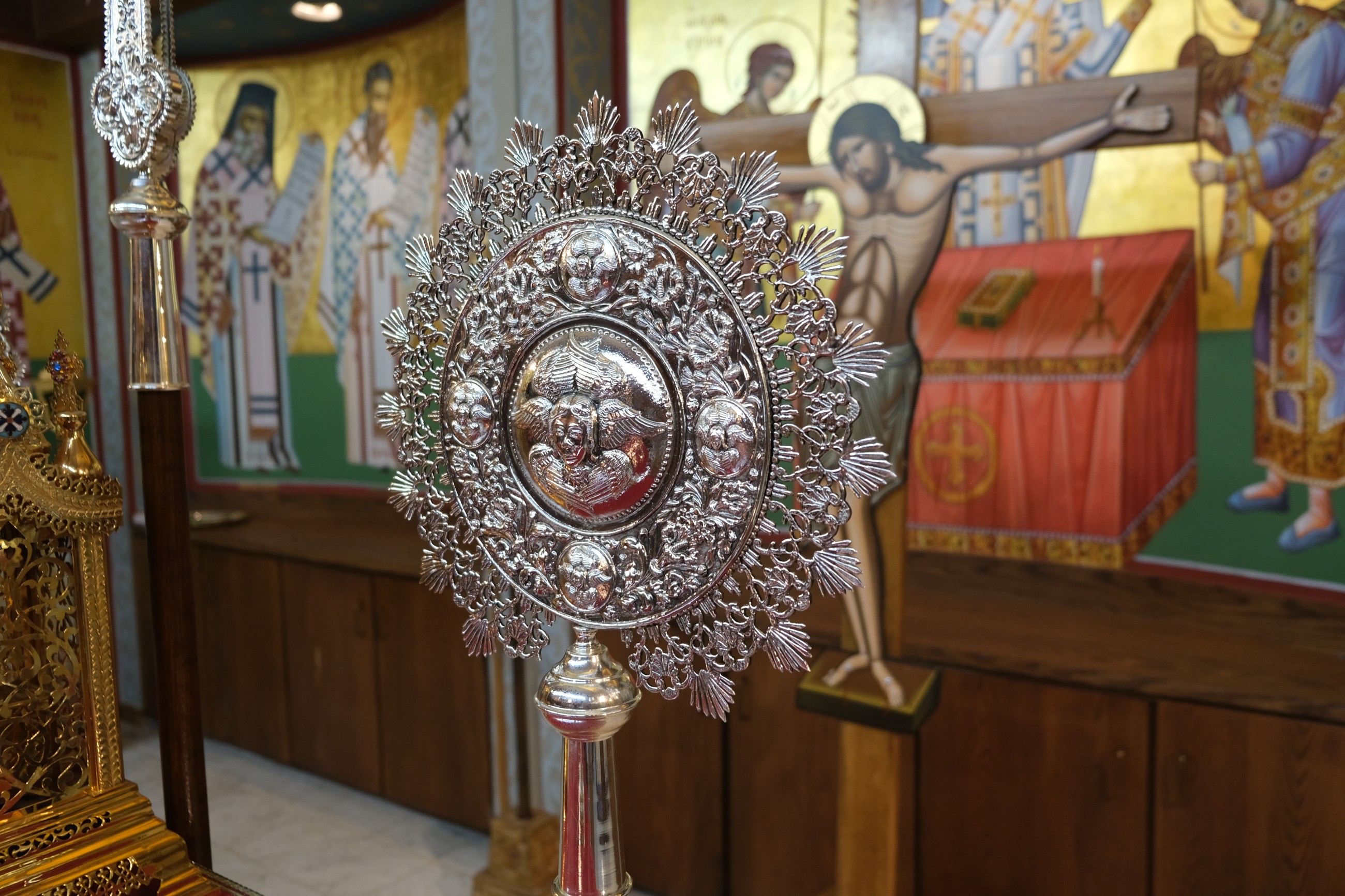
These ceremonial fans, having images of angels, represent the Seraphim and Cherubim, the angelic hosts surrounding the Throne of God, singing His praises.
[Annunciation Greek Orthodox Church of Winston Salem, NC: Greek Festival Church Tour Brochure - May 14]

Multiple items used in the Sacraments of the Church, including:
The Sacrament of Baptism incorporates us into the Church, the Body of Christ, and is our introduction to the life of the Holy Trinity. Water is a natural symbol of cleansing and newness of life. Through the three-fold immersion in the waters of Baptism in the Name of the Holy Trinity, one dies to the old ways of sin and is born to a new life in Christ. Baptism is one's public identification with Christ Death and victorious Resurrection. Following the custom of the early Church, Orthodoxy encourages the baptism of infants. The Church believes that the Sacrament is bearing witness to the action of God who chooses a child to be an important member of His people. From the day of their baptism, children are expected to mature in the life of the Spirit, through their family and the Church. The Baptism of adults is practiced when there was no previous baptism in the name of the Holy Trinity.Learn More
[Greek Orthodox Archdiocies of America - July 4]
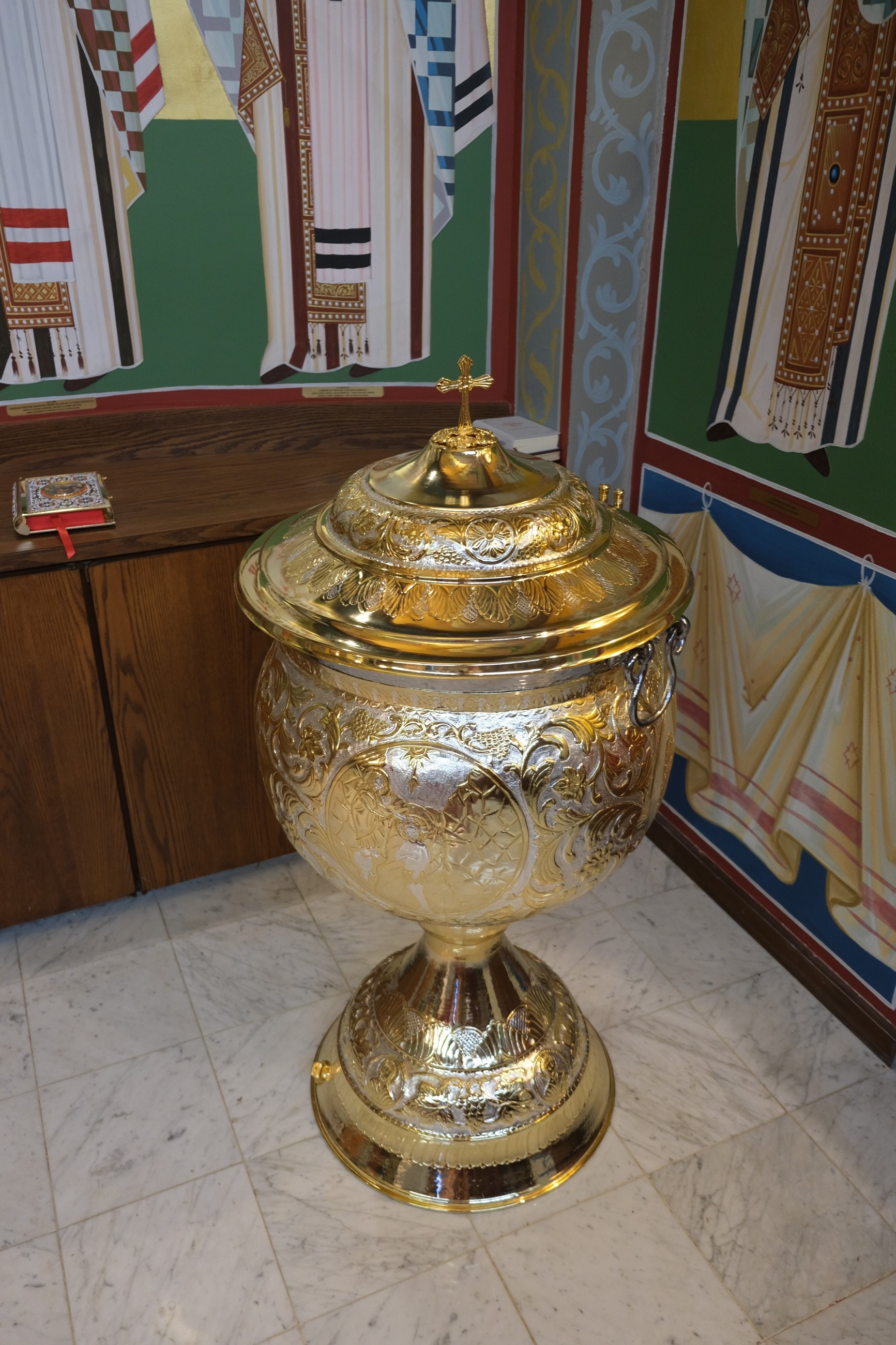
A large basin used for the immersion of infants during Baptism.
[Annunciation Greek Orthodox Church of Winston Salem, NC: Greek Festival Church Tour Brochure - May 14]
The Sacrament of Chrismation (Confirmation) immediately follows baptism and is never delayed until a later age. As the ministry of Christ was enlivened by the Spirit, and the preaching of the Apostles strengthened by the Spirit, so is the life of each Orthodox Christian sanctified by the Holy Spirit. Chrismation, which is often referred to as one's personal Pentecost, is the Sacrament which imparts the Spirit in a special way. Learn More
[Greek Orthodox Archdiocies of America - July 4]
(Myrodochion)

Contains a special mixture called HOLY CHRISM. Baptized Christians of other faiths are anointed with it when they join the Orthodox Church. It represents the SEAL OF THE HOLY SPIRIT.
[Annunciation Greek Orthodox Church of Winston Salem, NC: Greek Festival Church Tour Brochure - May 14]
God is active in our lives. It is He who joins a man and a woman in a relationship of mutual love. The Sacrament of Marriage bears witness to His action. Through this Sacrament, a man and a woman are publicly joined as husband and wife. They enter into a new relationship with each other, God, and the Church. Since Marriage is not viewed as a legal contract, there are no vows in the Sacrament. According to Orthodox teachings, Marriage is not simply a social institution, it is an eternal vocation of the kingdom. A husband and a wife are called by the holy Spirit not only to live together but also to share their Christian life together so that each, with the aid of the other, may grow closer to God and become the persons they are meant to be. In the Orthodox Marriage Service, after the couple have been betrothed and exchanged rings, they are crowned with "crowns of glory and honor" signifying the establishment of a new family under God. Near the conclusion of the Service, the husband and wife drink from a common cup which is reminiscent of the wedding of Cana and which symbolized the sharing of the burdens and joys of their new life together. Learn More
[Greek Orthodox Archdiocies of America - July 4]
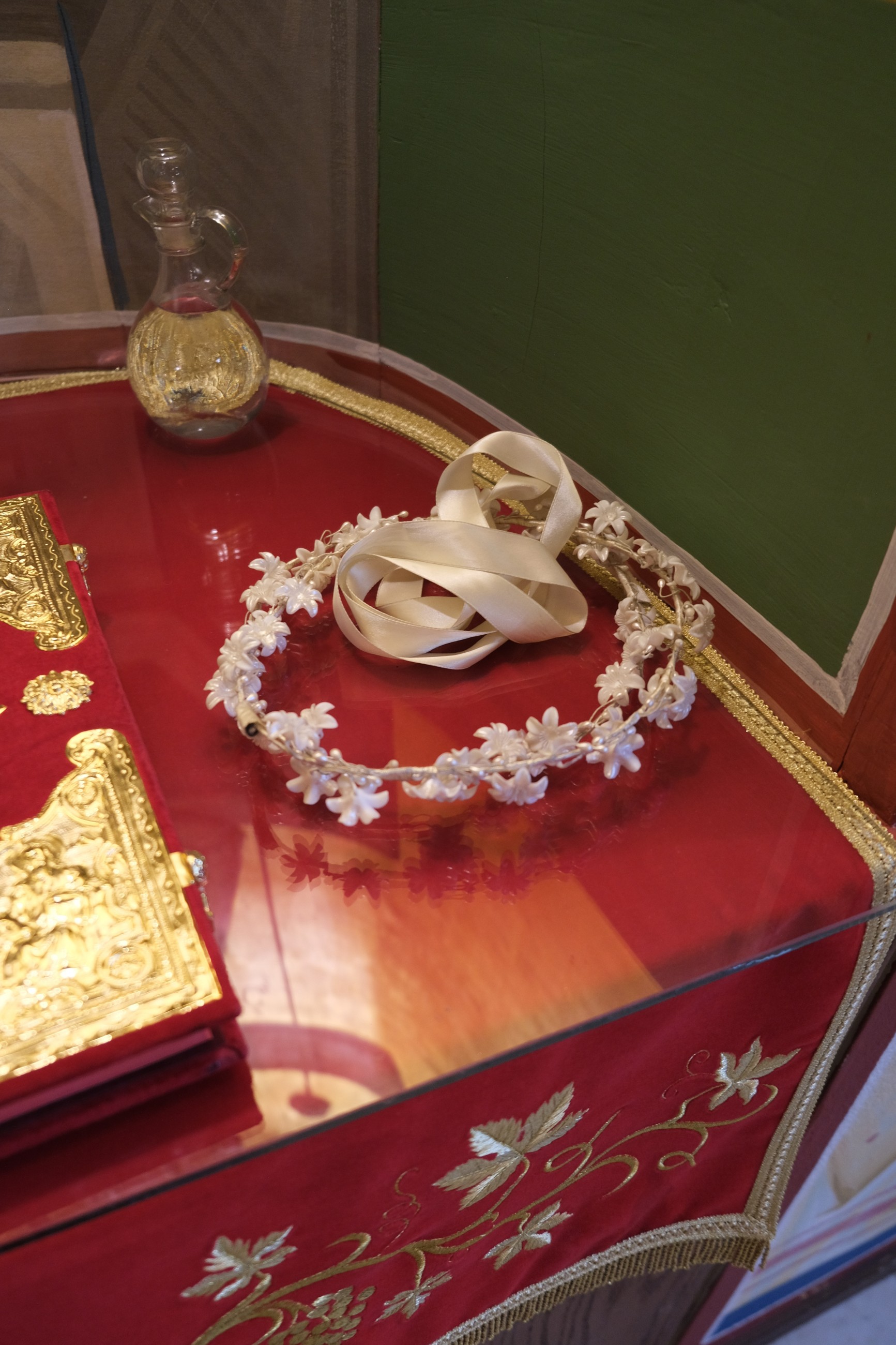
During the Sacrament of Marriage, the heads of the bridegroom and bride are crowned by the priest. In the Russian tradition, the crowns are gold or silver, while the Greek tradition uses crowns of leaves and flowers. The crowns are crowns of joy, but also crowns of martyrdom, since marriage involves a self-sacrifice on both sides.
[Annunciation Greek Orthodox Church of Winston Salem, NC: Greek Festival Church Tour Brochure - May 14]
The Holy Eucharist, which is known as the Divine Liturgy, is the central and most important worship experience of the Orthodox Church. Often referred to as the "Sacrament of Sacraments", it is the Church's celebration of the Death and Resurrection of Christ offered every Sunday and Holy day. All the other Sacraments of the Church lead toward and flow from the Eucharist, which is at the center of the life of the Church. The previous pamphlet in this series was devoted to the meaning and celebration of the Eucharist in the Orthodox Church. Learn More
[Greek Orthodox Archdiocies of America - July 4]
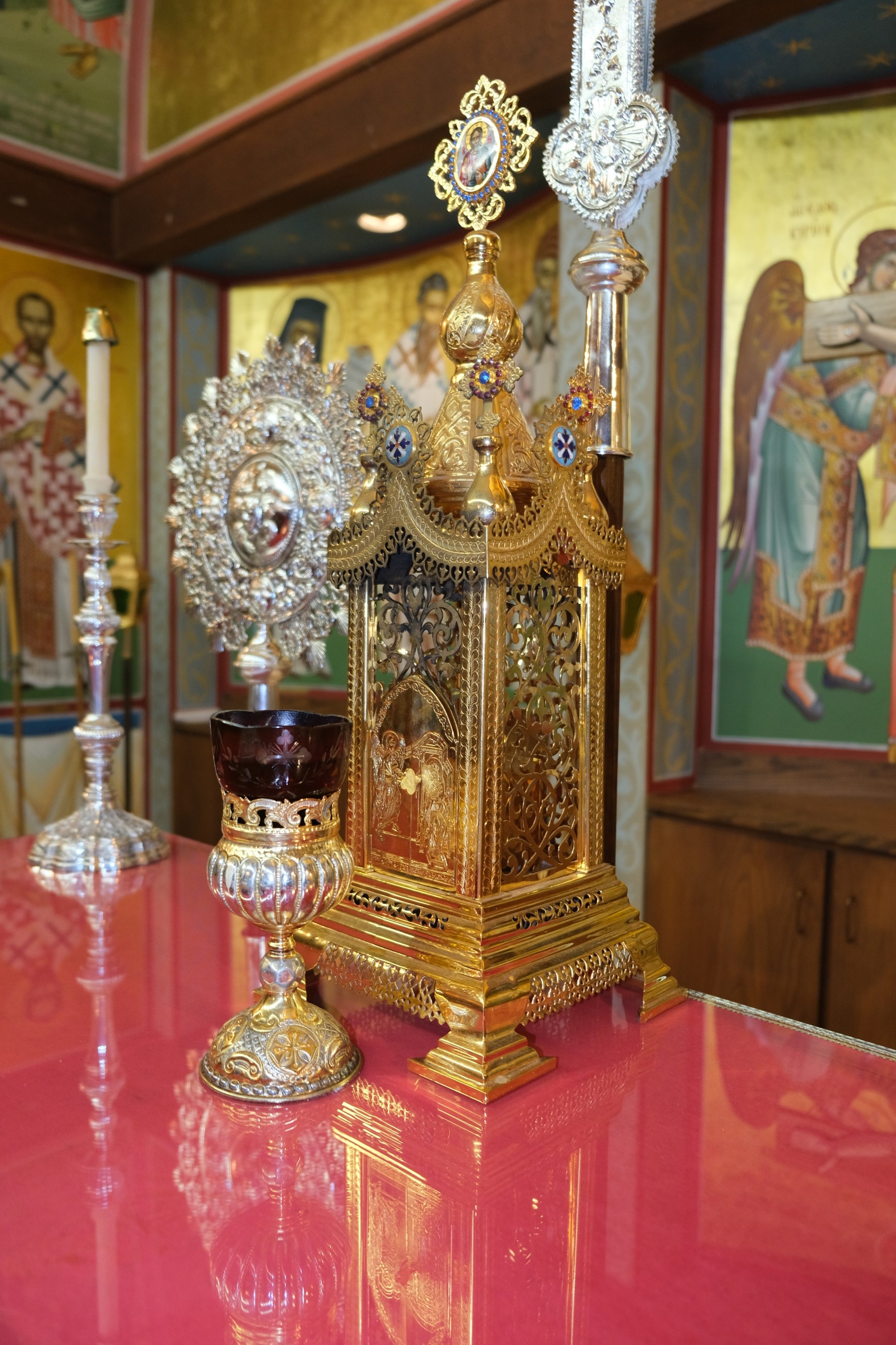 An elaborate golden object that looks like a small church used to hold the consecrated Eucharist for communion of the sick.
An elaborate golden object that looks like a small church used to hold the consecrated Eucharist for communion of the sick.
[Annunciation Greek Orthodox Church of Winston Salem, NC: Greek Festival Church Tour Brochure - May 14]
[Annunciation Greek Orthodox Church of Winston Salem, NC: Greek Festival Church Tour Brochure - May 14]
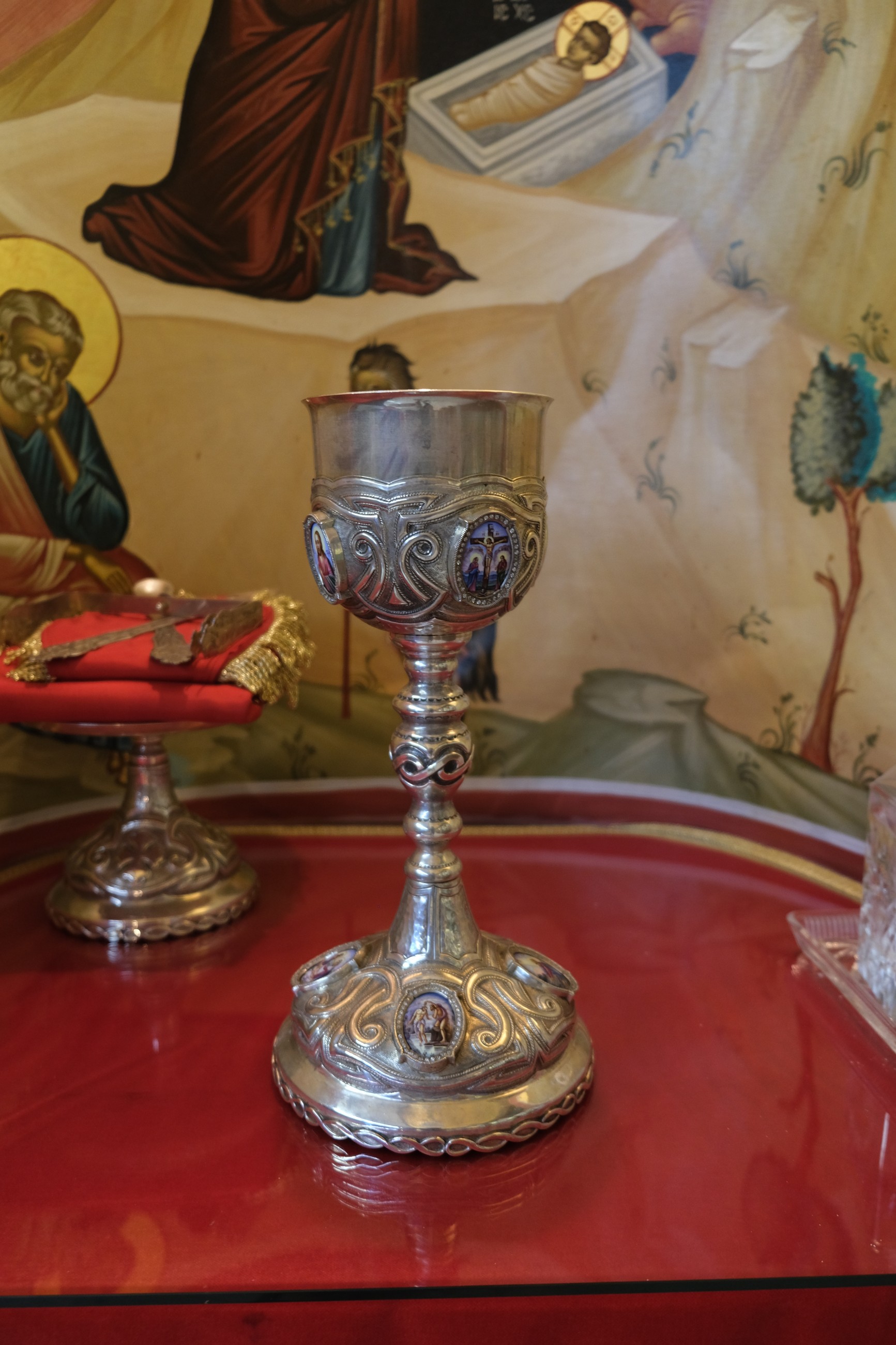
Used to offer Communion (the Holy Eucharist) during Divine Liturgy. Wine, bread, and hot water-having been changed mystically by the descent of the Holy Spirit upon the gifts, are combined in the Chalice and served to the Faithful with the spoon.
[Annunciation Greek Orthodox Church of Winston Salem, NC: Greek Festival Church Tour Brochure - May 14]
Diskos
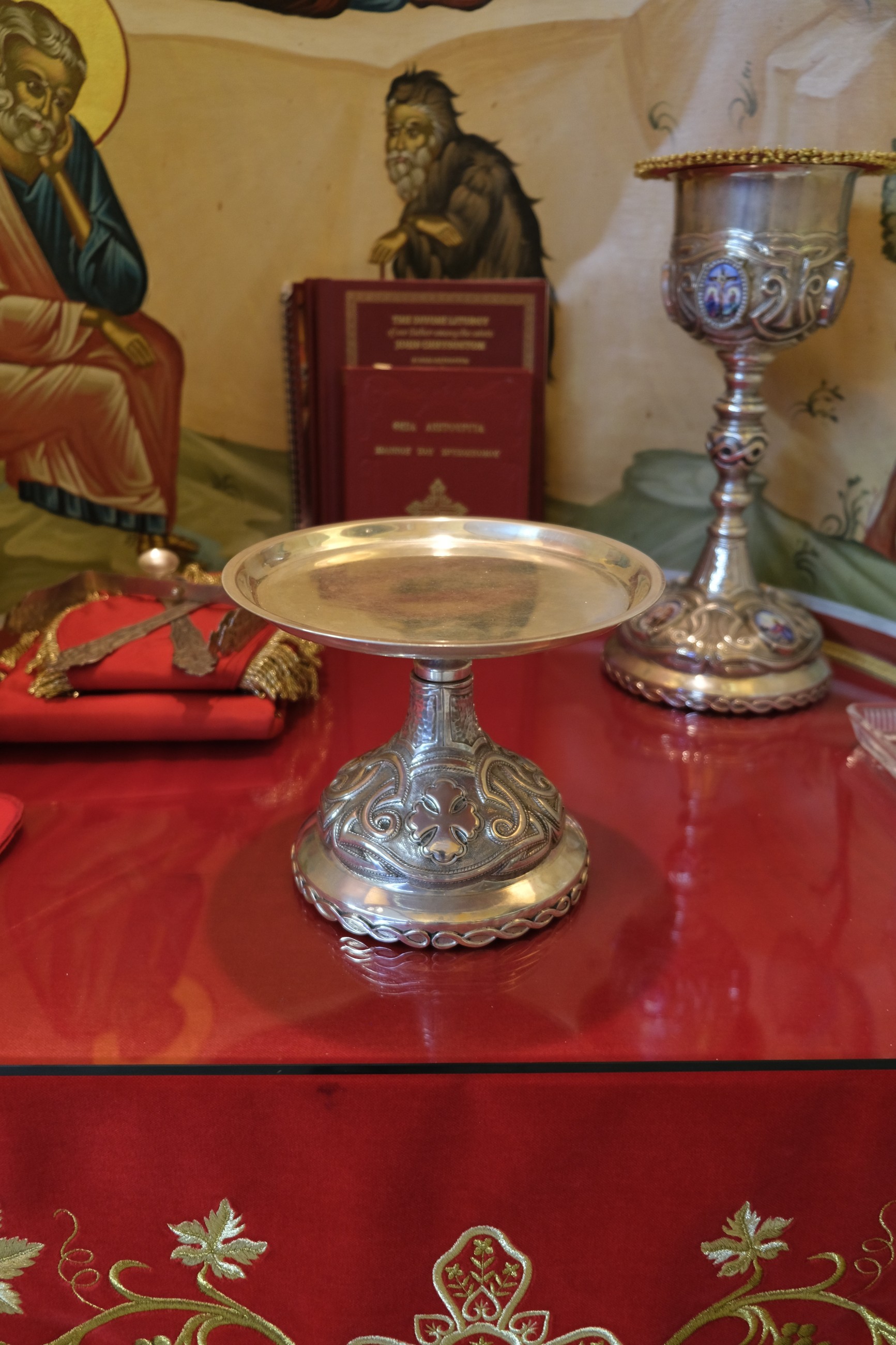
A plate used to carry the Phosphor (leavened bread, or "artos"). As the Holy Gifts are prepared for Communion, a Lamb is cut from the Phosphora and placed on the Paten. During the Great Entrance, it is brought to the Altar table along with the wine, where, by joining the Lamb with the wine, the celebrant calls for the bread and wine to be changed into the Body and Blood of Christ for Communion.
[Annunciation Greek Orthodox Church of Winston Salem, NC: Greek Festival Church Tour Brochure - May 14]
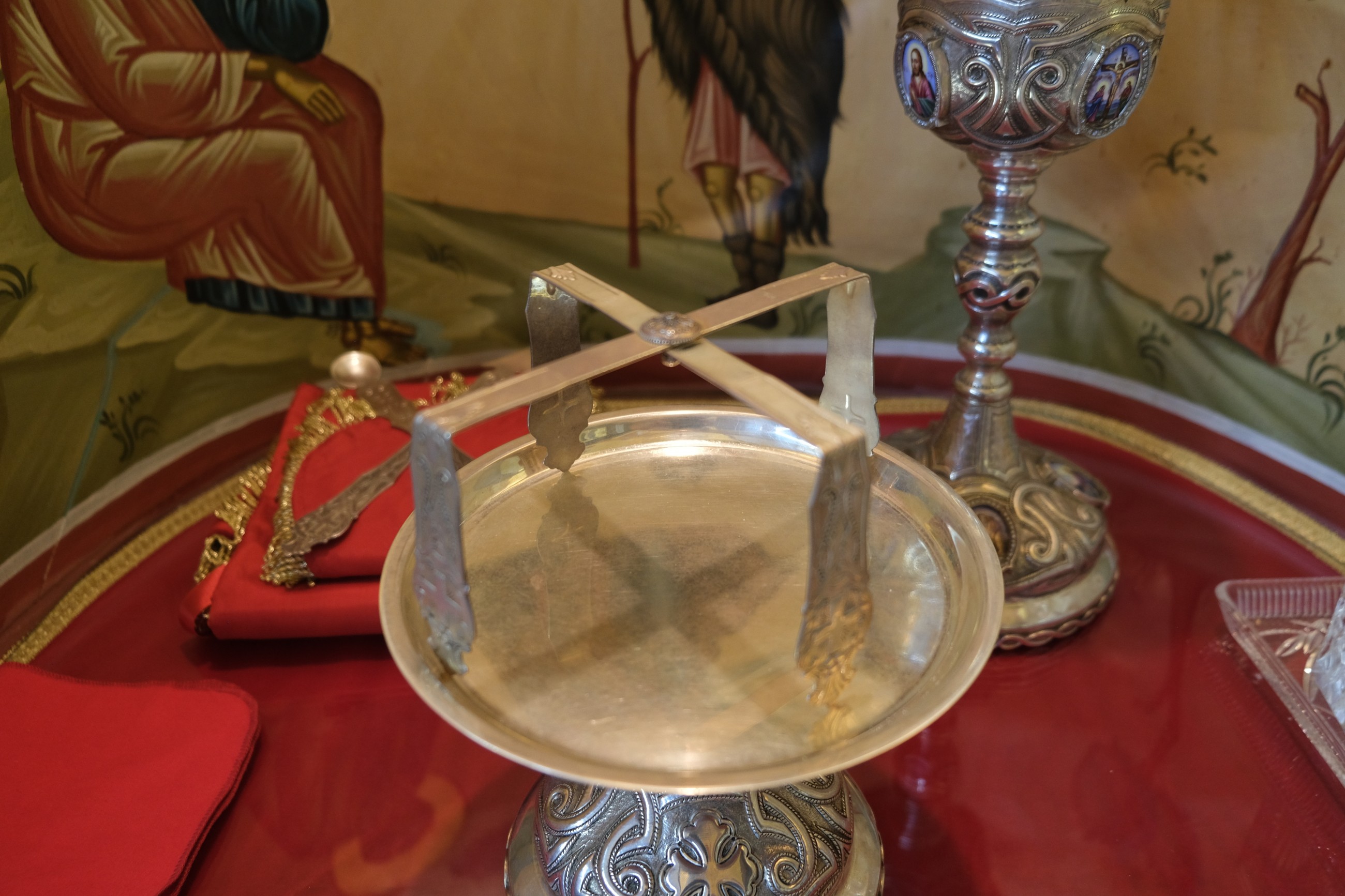
A cross-shaped object which is placed on the Paten during the Proskomidi (the preparatory service) and supports the covering. Historically, the Asterisk represented the heavens, while the Paten represented the earth. More recently the Asterisk has also come to symbolize the star of the Magi. As a result, it is often called "the star." The priest prays, "And the star came to rest over the place where the Young Child was" as he puts it on the Diskos over the Lamb.
[Annunciation Greek Orthodox Church of Winston Salem, NC: Greek Festival Church Tour Brochure - May 14]
Lonhi
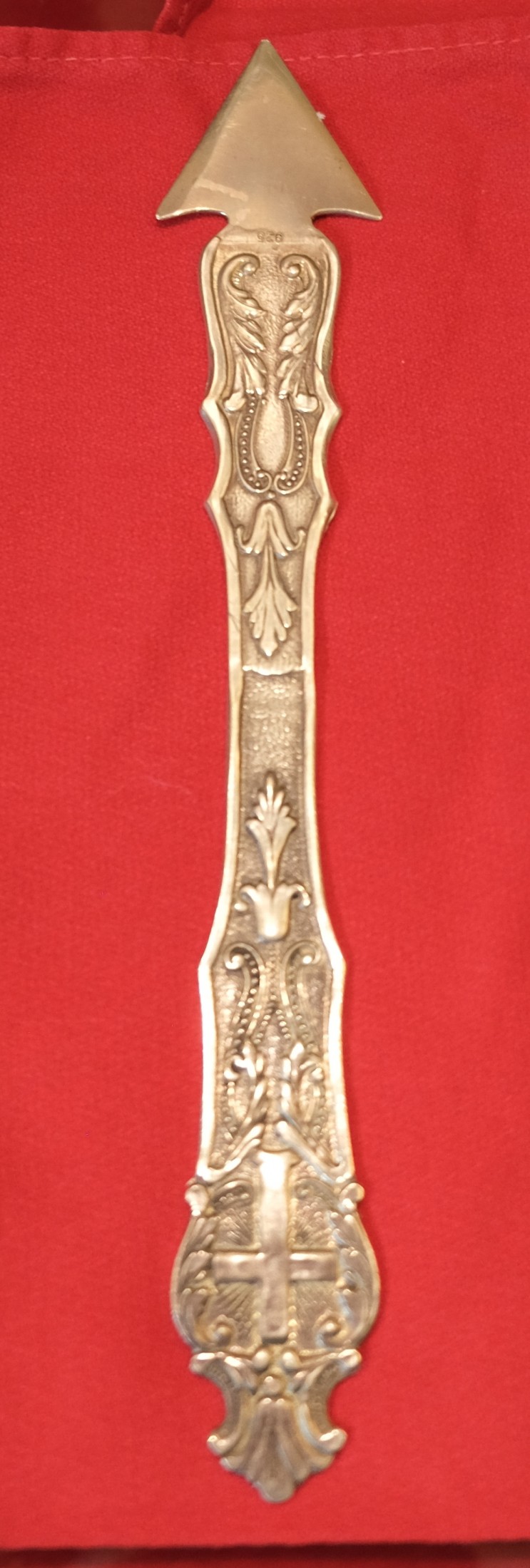
Represents the LANCE with which Christ was pierced while on the cross.
[Annunciation Greek Orthodox Church of Winston Salem, NC: Greek Festival Church Tour Brochure - May 14]
Lavida
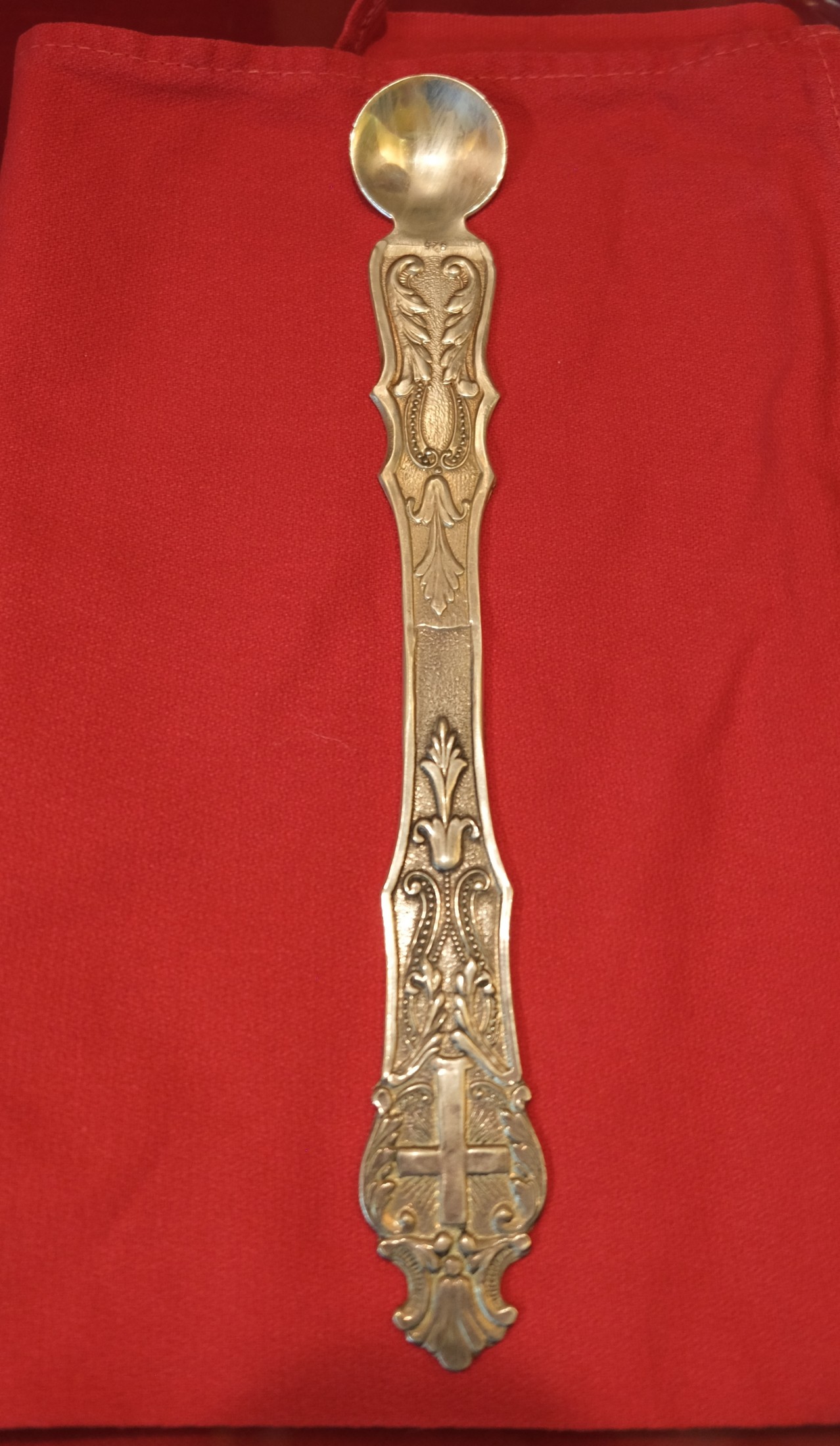
Used to disseminate Holy Communion to the faithful.
[Annunciation Greek Orthodox Church of Winston Salem, NC: Greek Festival Church Tour Brochure - May 14]
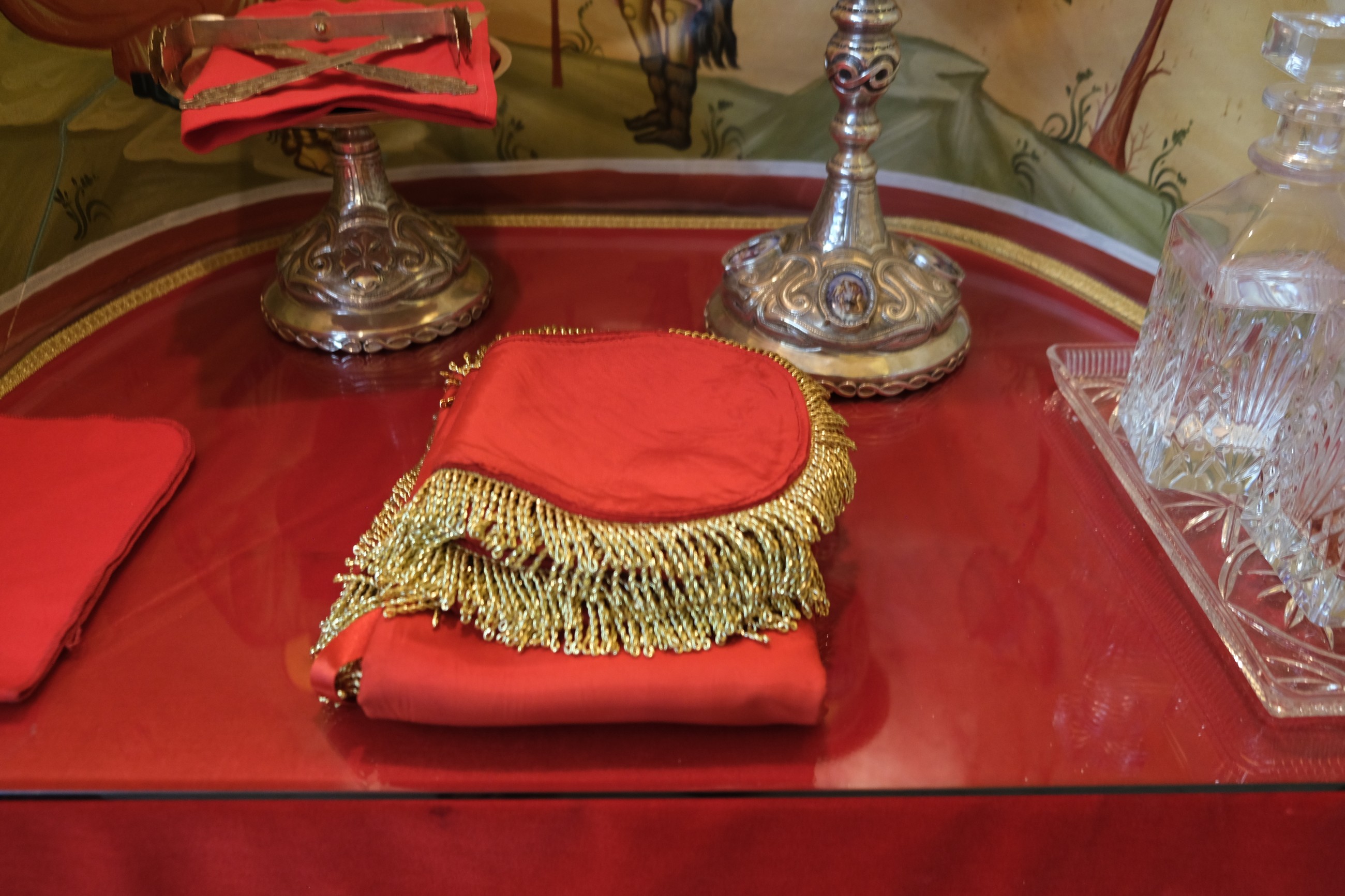
Chalice Covering: to cover the Chalice from the time of the Proskomidia (the preparatory service), until after the Consecration and final preparation for Communion. It is decorated by the Seraphim, which are the angels closest to God. Their name in Hebrew means "flaming," as they are aflame with love for God and kindle others to such love.
Aer (Covers both the Gifts): It takes its name either from the lightness of the material of which it is made, or from the fact that during the Nicene Creed in the Divine Liturgy, the priest holds it high in the air and waves it slowly over the chalice and diskos. Its original use was to cover the Chalice and prevent anything from falling into it before the consecration. It symbolizes the swaddling clothes with which Christ was wrapped at his Nativity, and also the grave clothes in which he was wrapped at his burial (both themes are found in the text of the Liturgy of Preparation).
[Annunciation Greek Orthodox Church of Winston Salem, NC: Greek Festival Church Tour Brochure - May 14]
(Bishops, Priest, Deacons, their Vestments)
The Holy Spirit preserved the continuity of the Church through the Sacrament of Holy Orders. Through ordination, men who have been chosen from within the Church are set apart by the Church for special service to the Church. Each is called by God through His people to stand amid the community, as pastor and teacher, and as the representative of the parish before the Altar. Each is also a living icon of Christ among His people. According to Orthodox teaching, the process of ordination begins with the local congregation; but the bishop alone, who acts in the name of the universal Church, can complete the action. He does so with the invocation of the Holy Spirit and the imposition of his hands on the person being ordained. Learn More
[Greek Orthodox Archdiocies of America - July 4]
Vestments:
Pascha (Easter)
Holy Ascension
Holy Pentecost
Transfiguration of our Lord and Savior Jesus Christ
The Dormition of our Most Holy Lady the Theotokos and Ever Virgin Mary
Elevation of the Holy Cross
The Entrance of the Theotokos into the Temple
The Nativity of Our Lord and Savior, Jesus Christ
The Theophany of Our Lord and Saviour Jesus Christ
The Presentation of Our Lord and Savior in the Temple
Annunciation of the Theotokos
Palm Sunday
Anastasia the Great Martyr
Anna, the Holy & Righteous Ancestor of God
Anthony the Great
Archangel Michael
Athanasios the Great, Patriarch of Alexandria
Barbara the Great Martyr
Basil the Great, Archbishop of Caesaria in Cappadocia
Catherine the Great Martyr of Alexandria
Charalambos the Holy Martyr
Christ
Christine
Chrysi the Neomartyr
Constantine, Equal-to-the Apostles
Cosmas the Holy Unmercenary
Cyril, Patriarch of Alexandria
Damianos the Holy Unmercenary
Demetrios the Myrrh-streamer Great Martyr of Thessaloniki
Dionysios-of-Zakynthos
Eleutherios the Holy Martyr, Bishop Illyria
Elijah the Prophet
Euphemia the Great Martyr
Filoumenos Jacobs Well
Fotini the Samaritan Woman
Gaberial, Archangel
George the Great Martyr and Triumphant
Gregory Palamas, Archbishop of Thessaloniki
Gregory the Theologian
Helen, Equal-to-the Apostle
Irene of Lesvos
Irene the Great Martyr
Joakim, the Holy & Righteous Ancestor of God
John Chrysostom, Archbishop of Constantinople
John the Baptist
John the Evangelist
John the Merciful
John the Russian
Kassiani the Hymnographer
Kosmas the New Hieromartyr & Equal-to-the Apostles of Aetolia
Kyriake the Great Martyr
Luke the Evangelist
Luke the Surgeon
Mark of Ephesus
Mark the Evangelist
Matthew the Evangelist
Nektarios the Wonderworker, Bishop of Pentapolis
Nicholas the Wonderworker, Archbishop of Myra
Nicholas the Wonderworker, Archbishop of Myra
Panteleimon the Great Martyr Healer
Paraskevi the Righteous Martyr of Rome
Pasisios the Athonite
Paul the Apostle
Peter the Apostle
Porphyrios of Kavsokalyvia
Romanos the Melodist
Seraphim Bishop of Fyaria and Neohoro
Sofia of Kleisoura
Spiridon the Wonderworker of Trymithous
Theodore Theodore of Tyre the Great Martyr
Theotokos
Narthex
Pangari
Proskinitaria
Icon of the Life Giving Tree
Nave
Christ Pantokrator (All Powerful)
Pews
Solea
Iconostasis
Pulpit
Kouvouklion
Chant Stand (Psalterion)
Bishop's Throne
Bishop's Staff
Trikeri (3 Candles)
Dikeri (2 Candles)
Sanctuary
Altar of Oblation (Prothesis)
Platytera
The Gospel Book
Blessing Cross
Censer
Hand Censer
Home Censer
Charchol
Incense
Altar Candles
Processional Crucifix
Processional Fans
Processional Candles/Lanterns
Baptism
Baptismal Font
Chrismation
Chrismation Vessel (Myrodochion)
Marriage
Crowns
Holy Communion
Tabernacle
Sacred Vessels
Chalice (Cup)
Paten
Asterisk
Spear
Spoon
Covers
Preparation of Holy Communion
Ordination
Vestments
Please report errors to [email protected]